

C O N T A C T U S w w w . r i s e n e n e r g y . c o m
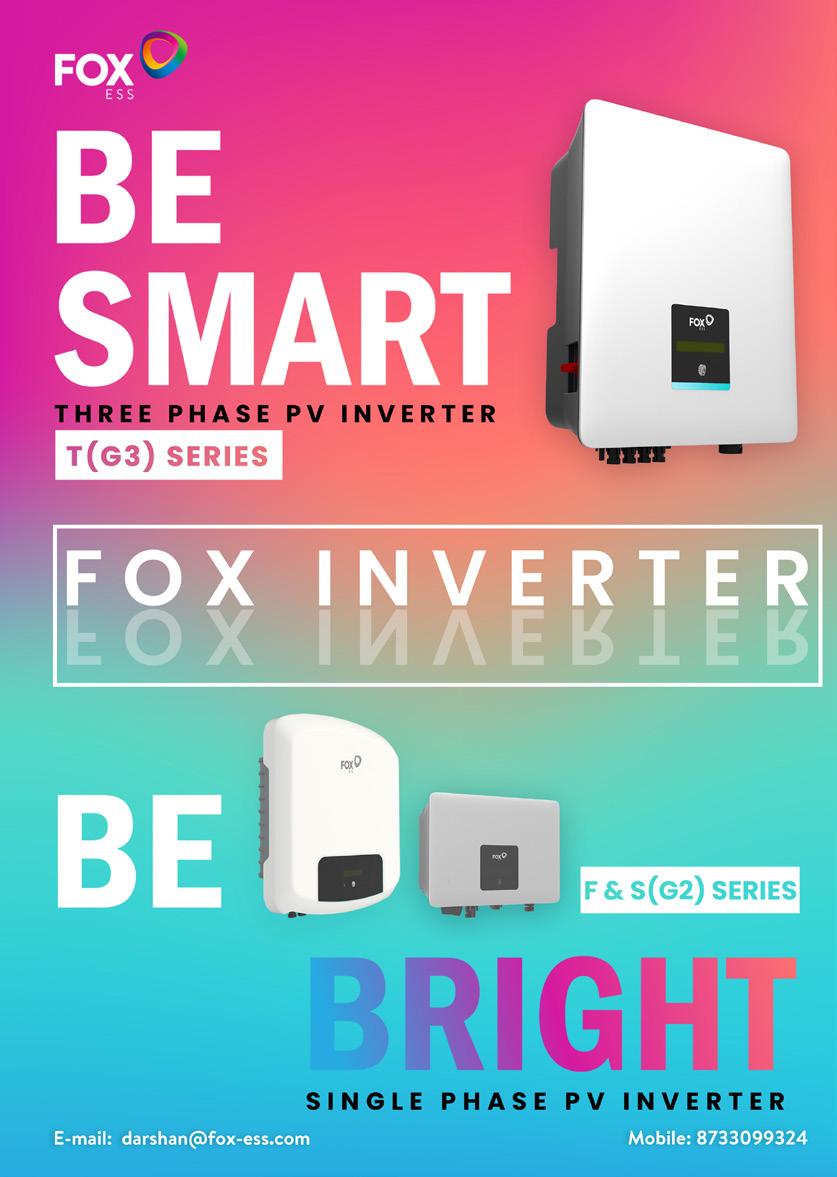

VOLUME 15
OWNER : FirstSource Energy
India Private Limited
PLACE OF PUBLICATION : 95-C, Sampat Farms, 7th Cross Road, Bicholi Mardana Distt-Indore 452016, Madhya Pradesh, INDIA Tel. + 91 96441 22268 www.EQMagPro.com
EDITOR & CEO : ANAND GUPTA anand.gupta@EQmag.net
PUBLISHER : ANAND GUPTA
PRINTER : ANAND GUPTA
PUBLISHING COMPANY DIRECTORS: ANIL GUPTA
ANITA GUPTA
CONSULTING EDITOR : SURENDRA BAJPAI
HEAD SALES & MARKETING
MUKUL HARODE sales@EQmag.net
GRAPHICS & LAYOUT BY : RATNESH JOSHI
SUBSCRIPTIONS : RISHABH CHOUHAN admin@eqmag.net
Disclaimer,Limitations of Liability
While every efforts has been made to ensure the high quality and accuracy of EQ international and all our authors research articles with the greatest of care and attention ,we make no warranty concerning its content,and the magazine is provided on an>> as is <<basis.EQ international contains advertising and third –party contents.EQ International is not liable for any third- party content or error,omission or inaccuracy in any advertising material ,nor is it responsible for the availability of external web sites or their contents
Issue 05 CONTENT
The data and information presented in this magazine is provided for informational purpose only.neither EQ INTERNATINAL ,Its affiliates,Information providers nor content providers shall have any liability for investment decisions based up on or the results obtained from the information provided. Nothing contained in this magazine should be construed as a recommendation to buy or sale any securities. The facts and opinions stated in this magazine do not constitute an offer on the part of EQ International for the sale or purchase of any securities, nor any such offer intended or implied
Restriction on use
The material in this magazine is protected by international copyright and trademark laws. You may not modify,copy,reproduce,republish,post,transmit, or distribute any part of the magazine in any way.you may only use material for your personall,Non-Commercial use, provided you keep intact all copyright and other proprietary notices. want to use material for any non-personel,non commercial purpose,you need written permission from EQ International.
PRODUCT REVIEW
SOLAX 40 KW TO 150 KW GRID-TIED INVERTER - THE ULTIMATE SOLUTION FOR C&I APPLICATIONS

PRODUCT REVIEW INDIA
SINENG ELECTRIC SHINES AT SNEC 2023 WITH ALLSCENARIO PV AND ENERGY STORAGE SOLUTIONS, EMPOWERING A GREEN FUTURE


FEATURED
WHAT IS APPLE MISSION FOR 2030?
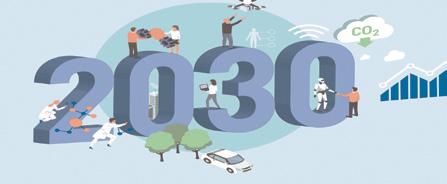
DEPOSIT OF LITHIUM IN J&K WILL BE HISTORIC MILESTONE IN ATMANIRBHAR BHARAT: ARJUN RAM MEGHWAL
DISCOVERY OF BIGGEST

58
08 12
INTERNATIONAL
36
SUNPURE
PRODUCT REVIEW
BUSINESS & FINANCE
SINENG ELECTRIC SIGNED THE CONTRACT WITH LARSEN & TOUBRO TO POWER A 700MW PV PROJECT IN SAUDI ARABIA

BUSINESS & FINANCE
“VENUS”
ELECTRIC VEHICLE
TO JAPAN PFC APPROVES LOAN WORTH RS 633 CRORE FOR DEPLOYMENT OF 5000 EV CABS IN DELHI

INDIA STARTS EXPORTING EV COM-

THERMAX GROUP POSTS QUARTERLY AND ANNUAL PAT GROWTH OF 51% & 45% YOY RESPECTIVELY SOFAR


FORGES AHEAD TO A NET-ZERO FUTURE WITH BLOCKBUSTER PV & ESS INNOVATIONS AT SNEC




OPINION
COMPARISON OF ENCAPSULANTS AKSHAY AGARWAL, DIRECTOR, NAVITAS ALPHA RENEWABLES PVT. LTD. (NARPL)

13 10
63 18 52
25 29 31
PRODUCT REVIEW DECARBONISATION Pg. 08-71 EQ News
LAUNCHES THEIR LATEST RAILED PV CLEANING ROBOT
QUARTER RESULT AT
SNEC!
SOLIS LAUNCHES S6 ADVANCED POWER HYBRID INVERTER WITH IMPRESSIVE FEATURES AND FUNCTIONALITY
TOYOTA
PONENTS
Founded in 2005, JA Solar is a manufacturer of high-performance photovoltaic products. With 12 manufacturing bases and more than 20 branches around the world, the company’s business covers silicon wafers, cells, modules and photovoltaic power stations. JA Solar products are available in over 120 countries and regions.









SOLAX 40 KW TO 150 KW GRID-TIED INVERTERTHE ULTIMATE SOLUTION FOR C&I APPLICATIONS
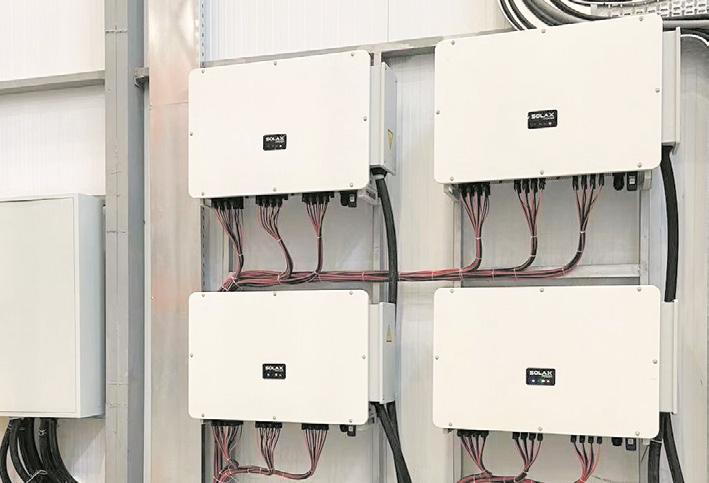
SolaX, a market-leading provider of solar solutions, offers a selection of on-grid options to meet the growing needs of commercial and industrial (C&I) clients. Notably, X3-MEGA G2 and X3-FORTH are among the most popular and highly recommended threephase inverters for C&I solar systems due to their optimal performance and capacity to generate maximum profits.
MORE ENERGY HARVEST

X3-MEGA G2 and X3-FORTH offer exceptional efficiency, reaching up to 98.4% and 99%, respectively. With a maximum MPPT current of 32A, they can support 150% PV oversizing input and 110% overloading output, compatible with high-power PV modules in the current market. Besides, they can work in parallel with up to 60 units of on-grid inverters via Datahub for higher solar energy yields and more profits.
SUPERIOR INTELLIGENCE
X3-MEGA G2 and X3-FORTH come equipped with advanced features that provide superior intelligence. These include smart I-V curve diagnosis for detecting and diagnosing solar panel issues and a built-in export power control function. Moreover, night-time reactive power compensation ensures stable system operation. They also offer 24-hour operation monitoring and remote setting and upgrading, giving users complete control over their systems.
8 EQ MAY 2023 www.EQMagPro.com PRODUCT REVIEW
Four X3-FORTH in Parallel 80kW-150kW
PRODUCT REVIEW

RELIABLE SAFETY
X3-MEGA G2 and X3-FORTH are designed to provide dependable and efficient energy output in any environment. Their IP66 rating ensures protection against water and dust, while the optional AFCI protection shields against arc faults. In addition, both of them have AC&DC SPDs (Type II) inside, further protecting the system against surges and voltage spikes.

SolaX X3-MEGA G2 and X3-FORTH are aimed at meeting the growing energy demands of businesses and industries while reducing their carbon footprint. From SolaX you can expect not only advanced solar solutions but also comprehensive technical support and attentive after-sales service. As such, SolaX is well-positioned to help C&I clients worldwide to achieve their sustainability goals.
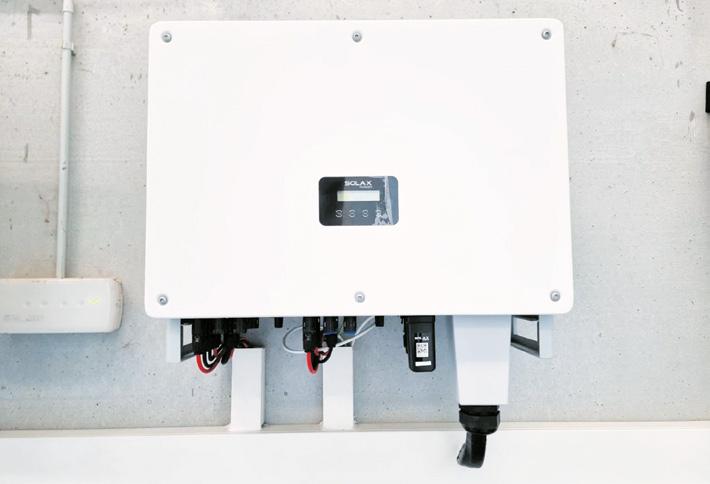 X3-MEGA G2 40kW/50kW/60kW
X3-MEGA G2 40kW/50kW/60kW
SUNPURE LAUNCHES THEIR LATEST RAILED PV CLEANING ROBOT “VENUS” AT SNEC!
Sunpure was proud to launch their 3rd generation PV railed cleaning robot “Venus” at SNEC PV Power Expo in Shanghai, China. To match the ever-changing PV cleaning requirements to address severe dust loss, Sunpure’s new robot “Venus” is designed in a lighter, smarter, and more economical way.
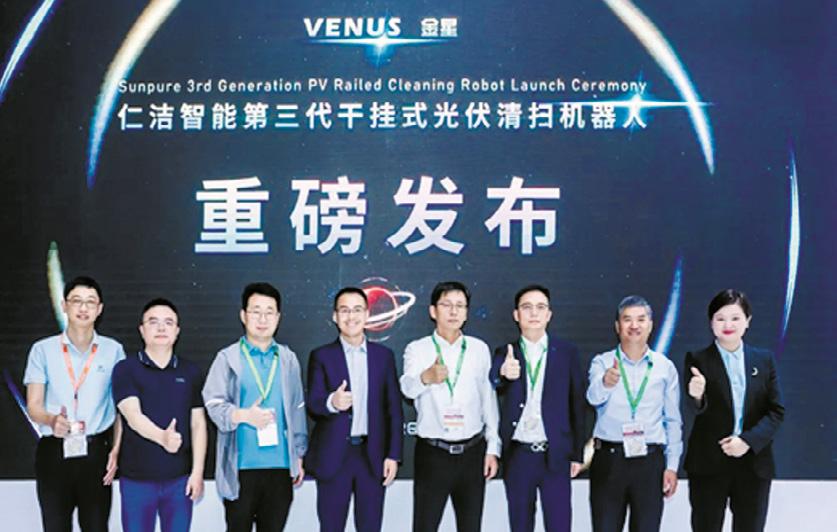
Lighter. The robot upgrades its hardware with a more dynamic and exquisite appearance. By replacing the metal-cased body with an optimized triangular force path structure, the weight has been reduced 30%, the robot is lighter and more friendly to the panels. And the twistable body is also suitable to overcome difficult terrains especially for plants equipped with trackers. Smarter. The robot hits a new level of intelligence since it is able to analyze and make decisions by itself. Through the equipped intelligent control system, the robot can adjust its operation strategies such as active attitude adjustment, positioning through multi-mode, and instant recognition of road conditions. Manual intervention is reduced to a minimum and O&M is easier.
More economical... “Venus” is more flexible in customization due to the modular design. On one hand, wider version of robots improves the ability of gap-crossing, thereby significantly reducing the requirements of engineering materials such as bridges between panels; on the other hand, installation and maintenance are also faster and cheaper, bringing a new cleaning experience for PV power plants.


By increasing R&D investment to adapt to the various industry requirements & trends, Sunpure has developed a full range of intelligent PV cleaning robot products which are operational in all terrains. This robot is our milestone in technology and our sincerity to the market and will empower PV plants to achieve higher output,” cited by Ms. Zoe Hu, Chairman & CEO of Sunpure.

10 EQ MAY 2023 www.EQMagPro.com
PRODUCT REVIEW
PRODUCT REVIEW
SolaX Launched New Hybrid Inverter - LV

SolaX Power, a global leader in solar inverter manufacturing, recently launched its newest innovation, X1-Hybrid LV, at a live product launch event held on April 25. Designed to provide high efficiency for low-voltage solar PV systems, X1-Hybrid LV is a valuable addition to SolaX's solar products portfolio and boasts many impressive features that are sure to impress customers.
As a single-phase low-voltage hybrid inverter for residential applications, X1-Hybrid LV 3-6kW is able to operate at a much lower voltage compared to traditional inverters. With two MPPTs and a maximum MPPT current of 16A, it supports high-power solar panels. It delivers a 200% PV oversizing input, up to 110% overloading output, and a 200% peak EPS apparent power for up to 10s, making it a reliable backup power solution. Moreover, it can be connected in parallel with up to 10 inverters for both on-grid and off-grid operations.
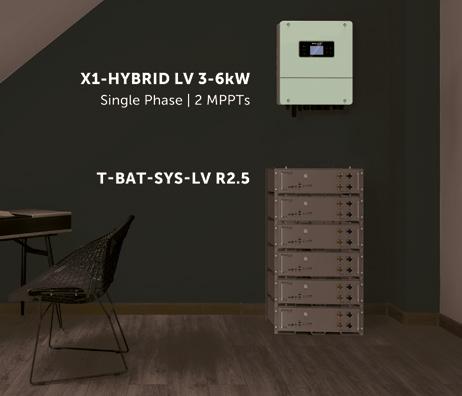

Another striking feature of X1-Hybrid LV is its fresh design that comes in various vibrant and eye-catching shell color options, complete with a full-color LCD touchscreen and a user-friendly interface for easy operation and control.
Safety is always a top priority for SolaX, so X1-Hybrid LV is designed to be robust and secure. Its IP65 protection degree allows it to work smoothly even in harsh environments. It is equipped with integrated SPD and optional AFCI protection, ensuring the safety of the system and its users. SolaX has built a reputation for providing high-quality solar solutions, and
As a low-voltage hybrid inverter, X1-Hybrid LV supports a nominal battery voltage of 48V and is compatible with multiple battery solutions, including lithium, lead-acid, gel, and lead-carbon batteries. Its performance is enhanced when used together with SolaX batteries, such as T-BAT-SYS-LV R2.5 and T-BAT-SYS-LV R3.6. which has a stackable design. This enables customers to expand their energy storage capacity and have access to backup power during blackouts or periods of low solar power generation. With SolaX Cloud, customers can achieve smart energy management for one-stop monitoring of PV panels, batteries, generators, etc.
the launch of X1-Hybrid LV emphasizes SolaX's commitment to innovation and continuous improvement to meet the needs of its customers. With its ultra-efficiency, fresh design, flexible adaptability, and solid safety features, X1Hybrid LV is sure to be a popular choice for customers looking for an efficient and reliable solar solution.
www.EQMagPro.com 11 EQ MAY 2023
PRODUCT REVIEW
SINENG ELECTRIC SHINES AT SNEC 2023 WITH ALL-SCENARIO PV AND ENERGY STORAGE SOLUTIONS, EMPOWERING A GREEN FUTURE
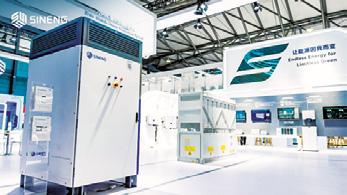

Sineng Electric, the global leading inverter and energy storage system solution supplier, is in the spotlight during SNEC PV Power Expo by unveiling the latest product portfolio for photovoltaic (PV) and energy storage applications. The impressive product line-up also demonstrates Sineng's incessant exploration to deliver energy-efficient solutions that redefine the power supply landscape.
Advancing C&I Applications: SN125PT String Inverter...
Featuring maximum efficiency of up to 99.0%, it ensures higher yields of PV systems, propelling businesses towards a future of limitless possibilities while optimizing the return on investment. With an input current of 60A per MPPT, it offers seamless compatibility with all mainstream solar modules. Furthermore, the inverter provides the comprehensive protection, encompassing smart switch-disconnectors, AFCI, Type II SPD and I/V curve scanning and diagnosis functions, effectively enhancing the overall reliability and safety of the system.
Unleashing the Power of Utility PV Systems: EP-4400-HA-UD
Central Inverter...
Amidst the exhibition's vibrant atmosphere, Sineng Electric brings the game-changing solution - the 4.4MW central inverter, tailor-made for utility-scale PV systems. By delivering higher power output and accommodating larger block sizes, the inverter guarantees more power generation. Its modular design at the component level, along with four Maximum Power Point Tracking (MPPTs), leads to an extraordinary fusion of flexibility and premium performance. Due to the multi-layered protection capability, including IP65 protection and the C5 anti-corrosion rating, the 4.4MW central inverter adapts to various harsh environments. Moreover, with reactive response within 30ms and the ability to withstand continuous low voltage ride through (LVRT) and high voltage ride through (HVRT) conditions, the central inverter shows exceptional stability, even in weak power grids.
Forging a Path of Energy Storage Innovation: EH Series 2MW

Central PCS
Sineng takes pride in our latest energy storage innovation - the 1520V 2MW Power Conversion System (PCS), which captivated industry experts, investors, and clean energy enthusiasts with cutting-edge technologies. Engineered to smoothly integrate with batteries above 306Ah, it ensures superior consistency and charging capacity. With efficiency surpassing 98.5% at rated power (1000VDC to 1500VDC), the PCS reigns supreme in maximizing energy conversion efficiency. Its modular design simplifies maintenance and improves system availability. Moreover, the enhanced power density and smaller footprint result in a remarkable reduction in initial investment for energy storage power plants, offering cost-effective solutions that pave the way towards a smart energy world.
In addition to the aforementioned products, Sineng Electric also presents a range of SN series products designed for residential applications. With the exceptional efficiency, advanced safety features, and smart O&M, the series emerges as the preferred choice for users who prioritize a stable and reliable power supply. "We are honored to showcase our product portfolio, which caters to a wide range of scenarios including residential, commercial and industrial (C&I), and utility applications. Thanks to the prestigious SNEC Expo, we have successfully shared insights into the latest trends, technologies, breakthroughs, and achievements in the everevolving renewable energy sector," proclaimed Viktor Duan, CEO of Sineng Electric, at Sineng's booth N4-310. "As always, Sineng remains at the forefront of exploring state-of-the-art solutions that drive sustainability and stacks up to new industry benchmarks," he added.

12 EQ MAY 2023 www.EQMagPro.com
SOLIS LAUNCHES S6 ADVANCED POWER HYBRID INVERTER WITH IMPRESSIVE FEATURES AND FUNCTIONALITY
Solis, a global leading manufacturer of solar & energy storage solutions, has announced the launch of their latest product, the S6 Advanced Power Hybrid Inverter. With an emphasis on generator connectivity and multiple input methods, the S6 offers automatic UPS switching and up to 10 seconds of 200% surge power backup overload capability.
One of the unique features of the S6 is its support for both 1-phase and 3-phase flexible connection with a maximum of 48kW in parallel. Additionally, the S6 can handle up to 190A max charge/discharge current and comes equipped with six customizable charge/discharge time settings. The inverter is compatible with both lead-acid and lithium batteries, offering multiple battery protection features. The S6 also supports peak shaving control in both “self-use” and “generator” modes, making it a versatile solution for any solar energy system. With Solis’ dedication to research and development, the S6 is the product of years of innovation and hard work. Solis Technologies was established in 2005 and has since become one of the leading providers of string inverters worldwide, with a strong emphasis on research and development to keep pace with the high demands and pace of change in the renewable energy sector. The company is committed to a global vision built on product-centered engineering and putting customers at the center of their most critical decisions.

Solis Technologies has set up global offices and technical after-sales service centers in multiple locations around the world, including the United Kingdom, the United States, Australia, Brazil, South Africa, India, Mexico, Spain, Netherlands, Romania, and others. Solis’ products have been used in high-profile locations and projects worldwide, including the Shanghai Expo in China and on the Eiffel Tower in France, among other leading domestic and commercial projects. Solis has achieved rapid growth in revenue and profit for many years in a row due to its leading technology and dedication to product quality. Solis ranked No.3 in global PV
inverter shipment, No.2 in global single-phase, and No.3 in global three-phase string market share by shipments. The launch of the S6 Advanced Power Hybrid Inverter further cements Solis’ position as a leader in the renewable energy sector. With its advanced features and compatibility with multiple battery types, the S6 is sure to be a popular choice for those looking to transition to clean energy.

www.EQMagPro.com 13 EQ MAY 2023
PRODUCT
REVIEW
SOLAX ENERGY STORAGE SOLUTION, YOUR BEST INVESTMENT FOR NEXT DECADE
As load shedding occurs more frequently than ever, all sectors of South African society have been dramatically impacted. With no end in sight to the outages, homeowners are increasingly opting for solar energy storage solutions as a reliable backup power source and SolaX stand out as a leading choice. With SolaX, you can take control of your energy supply and no longer suffer from sudden power outages.
SolaX provides various hybrid inverters and storage batteries, as well as an all-in-one energy storage system, X-ESS G4, for a more worry-free solution. With its 10-year warranty and complete after-sales support, you can be confident that SolaX will be there to assist you while you use these products.
HYBRID INVERTER
Available in single-phase ranging from 3-7.5kW and three-phase ranging from 5-15kW, SolaX hybrid inverters can support up to 10 inverters in parallel for a maximum power of 150 kW. They boast an integrated shading management function, as well as an emergency power output, with a switching time of less than 10ms.


STORAGE BATTERY X-ESS G4

SolaX storage batteries utilize safe LFP cells with a longer cycle life of over 6,000 cycles. This provides superior durability and reliability. Further, SolaX batteries feature remote troubleshooting, upgrades, and maintenance to guarantee smooth system management and operation.
SolaX X-ESS G4 is an intelligent all-in-one energy storage system, you get a complete inverter and battery package, making installation quick and easy. In the daytime, X -ESS G4 harnesses free, clean solar energy to generate electricity for your home, simultaneously charging the battery when the background loads are met. During load shedding or other times of high demand, the system will seamlessly transition to supply your home with stored energy, which means you can enjoy uninterrupted power even when the grid is down.
14 EQ MAY 2023 www.EQMagPro.com
PRODUCT REVIEW
REVIEW
SOFAR POWERMASTER: A GAME CHANGER FOR UTILITY ESS WITH PIONEERING POWER OF TECHNOLOGY
The global leading supplier of PV & ESS solutions, unveils its latest utility ESS innovation SOFAR PowerMaster embodied with state-of-the-art technological breakthroughs at SNEC 2023.
The launch of the fully self-developed PowerMaster marks a milestone of the company’s comprehensive range of PV & ESS solutions for all scenarios. It can be seen as a portfolio of 5 key revolutionary breakthroughs pioneering in utility ESS sector, able to tackle key pain-points through increasing power yields at a lower cost, and safe and operation around the clock.
Industry-leading Hybrid Cooling System...

The innovative combination of air and liquid cooling system provides intelligent monitoring which can reduce heat dissipation loss by about 30% and avoid condensation in battery compartments, thus realizing efficient and consistent cooling. Apart from this, the system comes with a lower battery temperature difference≤2.50C, able to maintain battery cells within the optimal temperature range and help extend the battery lifetime by 14%.
Ultimate Proven Safety...
Upholding strict safety priorities, SOFAR PowerMaster is equipped with 3+2 safety systems including triple FFS (fire suppression system), flammable gas emission and explosion-proof design to prevent secondary combustion. Meanwhile, the built-in safety design effectively protects the cells against high voltage or current short circuits, ensuring the stable operation around the clock.
Flexible Expansion...

The modular design is highly adaptive and capable of expanding single chamber storage capacity up to 3.93MWh, which is ideal for flexible needs of capacity expansion. Furthermore, the smart rack-level management increase system discharge capacity by 7%. By virtue of three-level topology and 99% maximum conversion efficiency, the system maintains less losses and optimal power performance.

Optimized Costs with Lower LCOS...
The highly-integrated design and refined management further improve power yields and offers lower LCOS for investors compared to traditional energy storage systems. Compatible with 320Ah cells, it minimizes the initial investment cost and enables higher energy density. Therefore, SOFAR PowerMaster is expected to be one of the most prudent choices for energy storage in the utility sector.
Smart Control...
In order to streamline the management process, SOFAR PowerMaster adopts the real-time automatic coordination control which guarantees PCS operating at full power. In addition, smart control algorithms make flexible and adjustable system capacity possible.
Yu Feng, Vice President of SOFAR, points out that SOFAR PowerMaster is expected to inspire a technological revolution in utility ESS sector, for being fully self-developed on the basis of ten years of R&D strength accumulation. “As a leading player in global energy storage market, SOFAR has been recognized by customers worldwide. Furthermore, in collaboration with TÜVRheinland, we have embarked on the development of the utility ESS white paper. We are excited for what is to come while focusing on delivering advanced technological breakthroughs to build up a more sustainable society for all,” he added.
www.EQMagPro.com 15 EQ MAY 2023
PRODUCT
SOFAR FORGES AHEAD TO A NET-ZERO FUTURE WITH BLOCKBUSTER PV & ESS INNOVATIONS AT SNEC
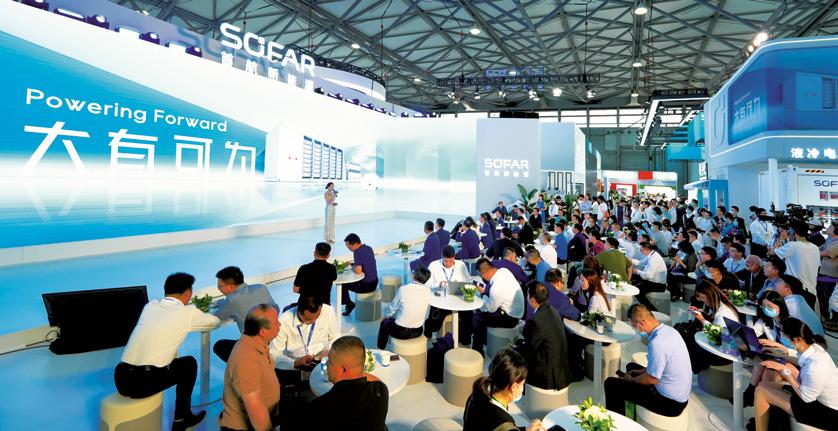


The global leading supplier of PV & ESS solutions, released multiple, competitive solar and energy storage innovations globally at SNEC 2023, fueling an accelerating clean transition to carbon neutrality.
Optimized for utility-scale energy storage plants, SOFAR has their latest flagship PowerMaster on display, which is an industry-leading integrated solution embodied with cutting-edge technologies. As a safe, reliable and sustainable solution to ensure grid resilience amidst demanding market operating conditions, PowerMaster is a combination of an innovative air and liquid hybrid cooling system, 3+2 safety systems, modular design, lower LCOS and smart control. The result of ten years of exploration and independent R&D, SOFAR PowerMaster has won recognition from industry partners since its release. During the Powering Forward New Product Launch, SOFAR signed MoUs with Hongyuan New Energy, Huaqing New Energy and Xiaoju New Energy, further solidifying its prevailing presence in the energy storage market.
In the meantime, SOFAR has launched another new product 320kW string inverter PowerMega tailored for utility PV. This highcurrent inverter made an impressive debut at
SNEC by solving traditional sore points and combining efficiency, safety and user-friendly all in one. With a max. efficiency up to 99.05% and 20A input current per MPPT, the inverter is compatible with 210/182mm modules and enables higher power yields. Featuring IP66 and C5-M anti-corrosion, it manages to survive harsh environments with a wide range of working temperature from -300C to 600C.
In addition, it supports I-V scanning which allows to pinpoint faulty strings thus maintaining stable operation around the clock. By virtue of the proven competitiveness of PowerMega, SOFAR also signed MoUs with Guohong Energy Group, Sichuan Shangwei and Tianlun New Energy, highlighting its strength and influence in utility sector and marking a crucial chapter of the company’s journey towards net-zero ambition.
As countries worldwide steadily decarbonizing their energy sources and phasing out reliance on coal power, we see great potential in renewable energy as it shows a positive impact on building a more sustainable and low-carbon planet. SOFAR will work relentlessly to bring forth all-scenario solutions for scaling-up demands, making renewables accessible and available for more countries, said Guy Rong, Senior Vice President of SOFAR.
16 EQ MAY 2023 www.EQMagPro.com DECARBONISATION
ORIANA POWER SUCCESSFULLY COMMISSIONS A 2.7 MWP SINGLE ROOFTOP SOLAR POWER PLANT IN HARYANA

• Located at the Indian Oil Corporation Ltd (IOCL) refinery in Panipat, the plant is commissioned for Indian Synthetic Rubber Private Limited, a joint venture between the IOCL and Trimurti Holding Corporation.

• It is among the largest single-rooftop solar power plants to be commissioned in Haryana.
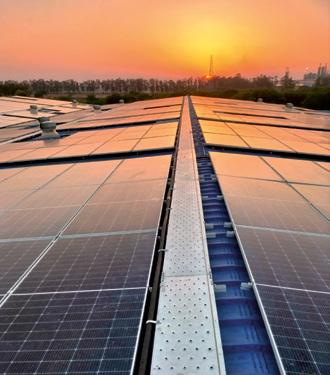
• The contract was worth around usd 1.85 million and was successfully commissioned within a record time of three months.
Oriana Power, among India’s fastest-growing solar energy solution providers, has announced the successful commissioning of a 2.7 MWp single rooftop solar power plant at the Indian Oil Corporation Ltd (IOCL) refinery in Panipat, Haryana, making it one of the largest projects in the state. The project has been commissioned for Indian Synthetic Rubber Private Limited (ISRPL), a joint venture between the IOCL and Trimurti Holding Corporation. It has been completed in a record time of three months. The IOCL refinery rooftop solar power plant will generate approximately 3.8 million units of clean electricity annually and support the State Government’s plan to harness the potential of renewable energies systematically. Spread over an area of 19000 sq. metre and powered by ~5500 solar panels, the project will generate enough green power to avoid 3,232 tons of CO2 emissions annually (equivalent to planting 3.9 lac trees annually).
With nearly 330 sunny days in a year, Haryana has great potential for solar energy production, making it one of the fastest growing states when it comes to solar energy production in North India. Harnessing the untapped and inexhaustible solar energy potential would be ushering in the required ‘energy mix’ and reduce the emission of CO2 and other toxic gases significantly, adding, “Through this project, we are not only helping the Government of Haryana meet its renewable energy targets but are also contributing towards reducing the carbon footprint and promoting sustainable development in the state. The project is expected to increase energy efficiency in the state and create employment opportunities within the local communities, thereby contributing to the local economy and livelihood. We want to thank IOCL for choosing us as their preferred partner on a mission to increase the renewable energy footprint in the total power mix and reduce carbon emissions on account of power generated from fossil fuel-based power plants,” said Anirudh Saraswat, Cofounder & Chief Business Officer, Oriana Power.

This is the 8th project by Oriana Power in the state, following the completion of ESI hospital, Ajeet industries , sledgehammer oil tools, Modern Delhi public school and NGK Spark plugs in the past couple of years. The project scope included engineering, procurement and construction of the floating solar power plant and a two-year contract for operation and maintenance services. Last month, Oriana Power successfully commissioned a novel 800kW AC/1MWp DC floating solar power plant at Dabok Mines of Udaipur, Rajasthan, making it the first such plant in the state. The project has been commissioned for Udaipur Cement Works Limited (UCWL), a subsidiary of JK Lakshmi Cement.
The Indian solar energy market is expected to record a CAGR of more than 8% during 2023-28. According to a recent report, India’s solar energy capacity has grown from 6.76 GW in 2016 to an impressive 54 GW in 2022, with a compound annual growth rate (CAGR) of 41.39%. This significant growth demonstrates India’s commitment to clean energy and its potential as a leader in the global fight against climate change.
www.EQMagPro.com 17 EQ MAY 2023 ROOFTOP SOLAR
COMPARISON OF ENCAPSULANTS AKSHAY AGARWAL, DIRECTOR, NAVITAS
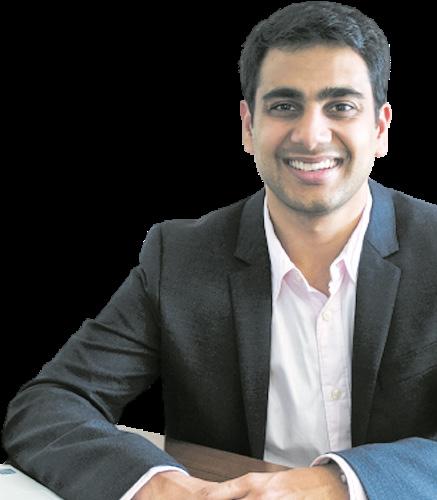
ALPHA RENEWABLES PVT. LTD. (NARPL)
There are different solar encapsulants available in the industry. In this article, we shall try to compare different encapsulants like EVA, POE, TPO, PVB, and silicone. All are made of different material compositions and used in various industries for different applications.
Here's an overview of each material:
1. EVA (Ethylene-Vinyl Acetate): EVA is a copolymer of ethylene and vinyl acetate. It is known for its flexibility, transparency, and excellent impact resistance. EVA is commonly used in indus tries such as packaging, footwear, sports equipment, and so lar cell encapsulation. It is often used as a foam material for cushioning and shock absorption purposes.
2. POE (Polyolefin Elastomer): POE is a type of elasto mer that belongs to the polyolefin family. It offers excel lent flexibility, low-temperature resistance, and good electrical insulation properties. POE is commonly used in applications such as automotive parts, wires and cables, medical devices, and con sumer goods.
3. TPO (Thermoplastic Olefin): TPO is a blend of polypropylene (PP) and ethylene-propylene rubber (EPR). It combines the benefits of both materials, including high impact strength, weather resistance, and good chemical resistance. TPO is widely used in the automotive industry for manufacturing bumpers, exterior trim, and interior components.
4. PVB (Polyvinyl Butyral): PVB is a thermoplastic resin known for its high transparency, adhesion, and toughness. It is commonly used as an interlayer in laminated glass applications, such as automotive windshields and architectural glazing. PVB provides safety benefits by holding broken glass pieces together when shattered.

5. Silicone: Silicone is a synthetic polymer made of silicon, oxygen, carbon, and hydrogen. It is known for its excellent heat resistance, electrical insulation properties, and flexibility over a wide temperature range. Silicone is used in various industries, including automotive, electronics, medical, and construction. It is commonly found in sealants, adhesives, lubricants, electrical insulation, and medical implants.
Each of these materials has its unique properties and applications, and their suitability depends on specific requirements and conditions in different industries and use cases. It's important to consider factors such as mechanical properties, chemical resistance, temperature stability, and cost when choosing the appropriate material for a particular application.
EVA (Ethylene Vinyl Acetate) and POE (Polyolefin Elastomer) are both popular materials used in various industries due to their unique properties.
18 EQ MAY 2023 www.EQMagPro.com
OPINION
OPINION
While they share some similarities, there are significant differences between the two materials. Here’s brief comparison between EVA & POE:
Category EVA POE
Composition

Flexibility and Softness
Density
Hardness
Chemical Resistance
It is a copolymer of ethylene and vinyl acetate. It is a polyolefin-based elastomer (blend of different polyolefin polymers).
It is Soft and flexible by nature. It can withstand repeated flexing and bending without losing its shape.
EVA generally has a higher density compared to POE. The density of EVA can range from 0.91 to 0.96 g/cm³.
EVA can be manufactured with various levels of hardness, ranging from very soft and sponge-like to harder and more rigid forms.
EVA has good resistance to many chemicals, including acids, alkalis, and polar solvents. However, it may not be suitable for exposure to certain oils and hydrocarbons.
It possesses flexibility and softness characteristics, making it suitable for applications that require high elongation and impact resistance.
POE has a lower density, typically around 0.86 to 0.89 g/cm³which means that EVA is slightly heavier than POE.
POE typically exhibits a softer and more rubber-like hardness, making it suitable for applications requiring a higher level of flexibility.
POE generally exhibits better chemical resistance, including resistance to oils and hydrocarbons.
Processing
EVA can be easily processed using common manufacturing techniques such as injection moulding, extrusion, and blow moulding. However, due to its lower melting point, EVA is generally easier to process and requires less energy during manufacturing.
POE can be processed using common manufacturing techniques such as injection moulding, extrusion, and blow moulding.
Applications
EVA is commonly used in footwear, sports equipment, packaging, solar modules and automotive parts. It is also used in the production of foam materials such as yoga mats and padding.
It's important to note that the specific properties and characteristics of EVA and POE can vary based on the composition and additives used in their formulation. Therefore, it's always advisable to consult the material specifications or consult with manufacturers to ensure the suitability of the material for a particular application.
POE is often used in wire and cable insulation, automotive components, seals and gaskets, and medical devices.
Navitas Alpha Renewables Pvt. Ltd. (solar encapsulant manufacturing company with the manufacturing capacity of 1.5 GW p.a.), a backward integration of Navitas Solar, provides the finest EVA & POE in India. Navitas Alpha has a dedicated research team that continuously works to improve the quality of its products and develop new ones as per industry’s needs.

www.EQMagPro.com 19 EQ MAY 2023
OPINION
LONGi Founder & President Li Zhenguo emphasizes COLLABORATIVE INNOVATION FOR ZERO-CARBON WORLD
The 16th (2023) International Solar Photovoltaics and Smart Energy (Shanghai) Conference and Exhibition (SNEC) kicked off at Kerry Center in Pudong, Shanghai. Li Zhenguo, Founder and President of LONGi, who was invited to attend the opening ceremony, delivered a keynote speech titled "Building collaborative innovation ecosystem to create a zero-carbon world".
Speaking at the ceremony, Li said it is the mission and responsibility of the entire industry to make photovoltaic cheaper to use. The continuous advancement of technology is the biggest driving force for cost reduction of photovoltaic power generation. At present, LONGi is actively developing an open innovation system, aiming to establish strong collaborations with educational institutions, industry peers and partners across the supply chain. The company is dedicated to advancing photovoltaic conversion efficiency in the near future while simultaneously driving down electricity costs.
Four methodologies to explain LONGi's innovation history
Innovation is the soul of LONGi and the endogenous driving force for the continuous development of the photovoltaic industry. Li Zhenguo has conducted a comprehensive review of LONGi's technological innovation process since its inception and has distilled it into what he refers to as "LONGi's four innovation methodologies."
1. Technological innovation adheres to "First principle" and consistently strives to enhance efficiency, placing it at the forefront of progress;

2. Prioritizing customers, creating value for customers, and always providing customers with a product reliability guarantee with leading standards, reliable quality and excellent user experience;

3. Stable and reliable corporate values, with a strong emphasis on product reliability and cost-effectiveness, and customer value improvement serving as the driving force to provide long-term value for photovoltaic power plants;

4. Adherence to an open mindset and commitment to investing in scientific and technological research and development to cultivate an open cooperation ecosystem that not only empowers ourselves but also our partners and the industry as a whole. By leading the way in innovation and industry transformation, we strive to achieve success for all stakeholders involved.
LONGi has a long history of innovation. Since 2014, LONGi has been at the forefront of overcoming key challenges in the solar industry. They pioneered the industrialization of RCz single crystal growth technology and successfully addressed the initial light attenuation issue of monocrystalline PERC in 2015. In 2017, LONGi introduced diamond wire-cutting technology for the slicing process and incorporated double-sided power generation technology into both cell and module production. Through these remarkable advancements and ongoing technological innovation, LONGi has maintained its leadership position in driving continuous cost reductions within the industry. "Thanks to technological innovation, the cost of photovoltaic electricity has dropped from 4 yuan to less than 0.5 yuan, which not only supports future development but also makes photovoltaics a supporting force for 'carbon neutrality'," Li Zhenguo said.
Building an open innovation ecosystem to create a zero-carbon world...
With the world reaching a consensus on "carbon neutrality", the global energy transition to renewable energy has become the general trend.
During his keynote speech, Li Zhenguo expressed LONGi's commitment to maintaining an open mindset, fostering a collaborative innovation ecosystem, and jointly building a zero-carbon world. In addition to continuously increasing investment in R&D, LONGi will spare no effort in seeking wider and deeper exchanges and cooperation around the world.
Just as a single tree cannot form a forest, it is the convergence of hundreds of rivers that create vast seas. LONGi, with its unwavering commitment to open innovation, has successfully harnessed the power of the entire industry chain through numerous instances of technological innovation leadership.
Speaking with the media, Li Zhenguo said the technology that will change or even subvert the photovoltaic industry in the future may not be in the photovoltaic industry itself, but in a certain field that seems to be "out of reach".
To this end, LONGi specially held a launch conference for its “STAR Innovative Ecological Cooperation Platform” during this year’s SNEC. According to the company, the platform will build a global leading green energy ecosystem with the mission of transmitting innovation trends, collecting global ideas, integrating solutions, docking high-quality resources and promoting technological innovation in the global photovoltaic industry.
20 EQ MAY 2023 www.EQMagPro.com
875 MW! SUNPURE INKS PROJECT WITH SAMSUNG C&T FOR LARGEST SOLAR PROJECT IN QATAR
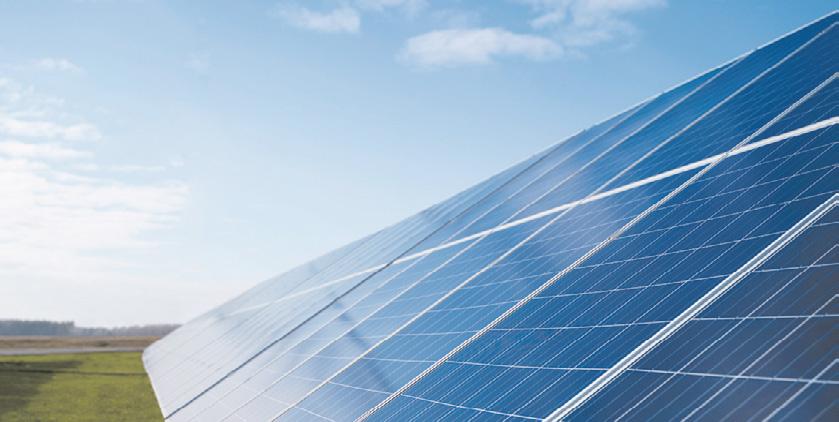

The agreement was signed by Ms. Zoe Hu (Chairman and CEO of Sunpure), and Mr. J.Y.Kim (Vice President of Samsung C&T).
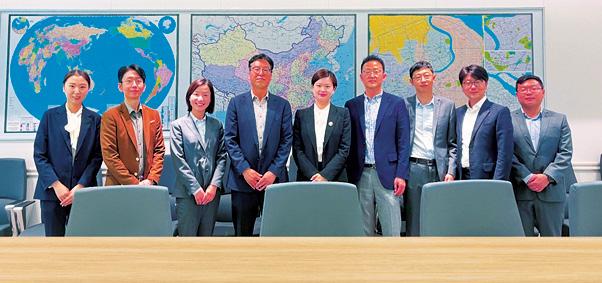
Sunpure Technology CO., LTD., a global leading PV robotic cleaning solution provider, signed an 875MW intelligent PV cleaning robots supply contract with Samsung C&T Corporation -Engineering & Construction Group (hereinafter “Samsung C&T”), for Qatar’s largest solar plant — the industrial cities solar power project (IC Solar).
The contract requires Sunpure to provide intelligent PV cleaning robots for two solar PV plants, with 875 MW of capacity. Both projects are expected to reach Commercial Operation at the end of 2024. This is the second large-scale PV project in Qatar which applies PV cleaning robots solutions. Sunpure will develop PV intelligent cleaning robots and supporting services based on its expertise, high quality and high efficiency for IC Solar projects, and provide higher value to clients with lower LCOE.
Samsung C&T is engaged in residential, office, industrial building and infrastructure construction, including the world’s tallest 828-metre Burj Khalifa in Dubai, the Petronas Towers in Malaysia, and notable civil projects such as the Mersey Gateway in the United Kingdom, the Riyadh Metro in Saudi Arabia.
RENEWABLE ENERGY
L&T ROPES IN GREEN ENERGY STALWARTS TO FORM GREEN ENERGY COUNCIL


Green Energy Council Formed to Bolster L&T's Resolute Commitment to Carbon Neutrality by 2040.
Formation of council in line with company’s commitment to play a meaningful role in building India’s green energy future.
Larsen & Toubro (L&T), an Indian multinational engaged in Infrastructure, Hi-Tech Manufacturing and Services, announced the formation of L&T Green Energy Council, a think-tank comprising of eminent thought leaders, in a significant step towards building a global green energy business. The council will be responsible for identifying technology trends in green energy, analysing the evolving global policy developments, evaluate emerging business models and advise on collaborations.
We are delighted to announce the establishment of the L&T Green Energy Council, which brings together renowned thought leaders who are at the forefront of driving global advancements in green energy. This council will serve as a powerhouse of expertise and strategic guidance as we strengthen our commitment to build a worldclass green energy business. With our country aiming to achieve energy independence by 2047 and reach Net Zero by 2070, we are confident in our ability to make significant contributions to India's transition towards a sustainable and carbon-neutral future, said Mr. S.N. Subrahmanyan – CEO & MD, L&T.
The four eminent Industry stalwarts forming the L&T Green Energy Council comprise of:

Prof. Eicke R. Weber, a global authority on renewable energy technologies, currently serves as the Co-President of the European Solar Manufacturing Council. Additionally, he holds the honorary position of President of the German Energy Storage Association.
Mr. Bart Biebuyck is one of the leading global thought leaders in the green hydrogen economy. Until recently, he held the position of Executive Director of the Clean Hydrogen Partnership, a prestigious public-private partnership between the European Commission, Hydrogen Europe, and Hydrogen Europe Research. Now he helps to realize various huge hydrogen production facilities around the world as well as supporting countries to get to their decarbonization targets through building hydrogen ecosystems.
Prof. Christopher Hebling is the director of Hydrogen Technologies at the Fraunhofer Institute for Solar Energy Systems ISE, one of the leading global research institutes on renewable energy technologies in Germany. Additionally, he is the delegate on behalf of Germany in the Executive Committee of the Technology Collaboration Program (TCP) for the Generation and Utilization of Hydrogen of the International Energy Agency, IEA. Furthermore, he is the Co-Chair of the board of the National Organization Hydrogen and Fuel Cells, NOW.
Prof. Patrice Simon is one of the world's foremost technology leaders in the field of electrochemical materials. He currently holds the position of Distinguished Professor at the Université Paul Sabatier, and he is a member of French Academy of Sciences. He also leads the French program on batteries for CNRS. Prof. Simon was the former Director of European Research Institute ‘Alistore ERI’.
Speaking on the occasion, Mr. Subramanian Sarma, Whole Time Director & Sr. Executive Vice President (Energy), L&T, stated, "The establishment of the L&T Green Energy Council with world-class global experts is a testament to L&T's commitment to the green transition in India, and the council's guidance will be instrumental in building a top-tier green energy business."
As the world strives towards a Net-Zero economy, India assumes a pivotal role in the fight against climate change. The imperative to innovate and scale cutting-edge clean energy technologies becomes paramount in the mission to significantly reduce atmospheric emissions and curb pollutants in cities. Leveraging robust capabilities in the energy sector, L&T is firmly dedicated to playing a substantial part in shaping India's green energy future. With a resolute commitment to achieving carbon neutrality by 2040, L&T has already embarked on initiatives encompassing green hydrogen project development/EPC, electrolyser manufacturing, and battery cell manufacturing.
www.larsentoubro.com



22 EQ MAY 2023 www.EQMagPro.com RENEWABLE ENERGY
LONGI SELECTED ON THE 2023 FORTUNE CHINA ESG IMPACT LIST
1. The China renewable energy giant made the ESG impact list for 2 consecutive years.
2. FORTUNE China: LONGi has helped boost the world low-carbon energy transition with its PV products & solutions.
3. LONGi to build an industry-leading sustainable development management system.
LONGi Green Energy Technology, a global leading renewable energy company, was recognized in the 2023 FORTUNE China ESG Impact List for its long-term commitment and dedication on the ESG-related efforts. LONGi was among 40 top companies from various sectors in China that were recognized by FORTUNE China.
This is the second time for LONGi, a renewable energy giant, that has made to the FORTUNE China ESG Impact List. FORTUNE China says “LONGi, as a world-leading company in the PV sector, has helped boost the low-carbon energy transition of the world economy with its monocystalline PV products and solutions.”
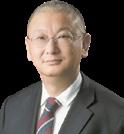
“The 40 Chinese companies that are included in the FORTUNE China ESG Impact List have all made outstanding efforts in improving environment, protection employees and supporting communities. They all have been exploring a growth path that is sustainable and inclusive,” says FORTUNE China.
LONGi is the only Chinese company that has joined all four initiative related to climate change, that include the RE100, EP100 and EV100 by the Climate Group and SBTi (Science Based Targets initiative). Over the years, LONGi has been firmly fulfilling its commitments and continuously promoting the implementation of these initiatives. In 2022, LONGi has established a greenhouse gas emission accounting system. The company has promised to achieve 100% clean energy use for its global operations by 2028.
By 2030, LONGi promises to reduce its greenhouse gas emission by 60%, and to work with its suppliers to reduce the carbonemission intensity by 20% for the polycystalline silicon materials, PV cells and glass it procures. In 2022, LONGi initiated the “Supply Chain Green Partners Empowerment Plan”, and has empowered over 480 suppliers. LONGi’s Zero-carbon Factory in Baoshan of China’s southwestern Yunnan Province has achieved 99.09% green energy use, with energy-conservation and technology innovation projects undergoing.
The company has launched a comprehensive training system that covers business leadership, professional skills, internationalization, and corporate culture, with a special focus to employees that LONGi enrolled among university graduates. In 2022, LONGi has offered over 290,000 times of training sessions to its global staff.
Li Zhenguo, Founder and President of LONGi says, “As a responsible global green energy technology company, LONGi is committed to becoming an advocate, practitioner and leader for the sustainable development of the global clean energy sector. LONGi will build an industry-leading sustainable development management system and continue its ESG best practices, in order to make PV solar power the clean energy that is affordable to mankind.”
AMP

ENERGY INDIA



EMERGES THE LOWEST BIDDER
IN CESC’S 150MW WIND-SOLAR HYBRID AUCTION
Amp Energy India, a leading renewable energy transition platform in the country through its subsidiary Amp Green Energy Private Ltd has won CESC’s 150MW Wind-Solar Hybrid auction at an attractive tariff of ₹3.07 per unit. The tariff discovered was the lowest tariff in the bid.
The contracted capacity of the project will be 150MW and would require a ~250 MWp of Wind & Solar capacity installation. The project shall be connected to ISTS network. The Power Purchase Agreement for this project will be executed with CESC Limited which is a leading private discom (A rated) in Eastern India and India’s first fully integrated electrical utility company ever since 1899, generating and distributing power to customers in Kolkata and other areas in the country. With this bid, Amp Energy India has won back-to-back wind-solar hybrid bids and reinforces its position as a market leader in providing diversified utility scale renewable energy solutions to its customers. This win takes Amp Energy India’s Utility Portfolio to 1.75 GWp+ diversified into niche segment with world class off-takers and total portfolio of projects to ~3GWp including C&I off-takers. Amp Energy India is committed to contribute significantly to the country’s renewable capacity in alignment with the government’s ambitious target of achieving 500 GW by 2030.
Winning these back-to-back bids clearly demonstrates our ability to provide diversified solutions at the best price and shows our commitment to harnessing the power of renewables to lead India’s renewable energy transition. By combining wind and solar energy in a single project, we can optimize land use, improve power generation, and reduce intermittency of the system. We are also happy to provide green power to the heart of eastern India through CESC, one of India’s leading integrated utility companies, said Mr. Pinaki Bhattacharyya, MD and CEO, Amp Energy India.
www.EQMagPro.com 23 EQ MAY 2023
BUSINESS & FINANCE
SERENTICA RENEWABLES SECURES ADDITIONAL $250 MILLION INVESTMENT FROM KKR LATEST INVESTMENT BUILDS ON THE $400 MILLION COMMITTED BY KKR LAST YEAR
Serentica Renewables (“Serentica” or the “Company”), a decarbonization platform that seeks to enable the energy transition by providing complex clean energy solutions for energy-intensive, hard-to-abate industries, announced the signing of definitive agreements under which leading global investment firm KKR will invest an additional $250 million in the Company.
This latest investment builds on the $400 million investment from KKR in November 2022. With this, the company is gearing up to install 4000MW of renewable energy capacity that will aid clean energy delivery to large-scale industrial customers. Serentica has recently signed a new set of Power Delivery Agreements (PDAs) to deliver round-the-clock green energy to some of the leading industrial customers in India. Currently, it is in the process of developing solar and wind power projects across Karnataka, Rajasthan, and Maharashtra. Once commissioned, these projects will supply 9 billion units of green energy every year, using the inter-state transmission network, thereby decarbonising a large portion of the electricity consumption of the large-scale industrial customers. Serentica’s vision is to supply over 40 billion units of clean energy annually in the medium term and displace 50 million tonnes of CO2 emissions.





Commenting on the transaction, Pratik Agarwal, Director, Serentica Renewables, said, “We are excited to deepen our collaboration with a like-minded strategic partner like KKR.

This investment will enable us to further accelerate largescale decarbonization of the power-guzzling commercial and industrial segment. Our unwavering commitment to reversing climate change through the delivery of clean energy has been further reinforced by this investment, giving us greater confidence in our capabilities to achieve this vision.”
Hardik Shah, Partner at KKR, said, “As India continues to develop at pace, clean energy solutions will play a growing and important role in meeting the country’s energy demands, especially in the industrial and hard-to-abate industries that Serentica looks to support. We are pleased to extend our relationship with Serentica to support their growth and propel their mission to enable India’s energy transition.”


GOLDI SOLAR TIES UP WITH YES BANK TO FINANCE SOLAR PROJECTS FOR MSME CUSTOMERS
Goldi Solar, India's most quality-conscious solar brand, has partnered with YES BANK to finance solar projects for its Micro, Small and Medium Enterprises (MSME) customers, through YES BANK’s YES KIRAN programme. Under this programme, the Bank will offer financial assistance to MSME manufacturers, who wish to install solar panels at their premises.
The platform will process all the loan applications for solar projects sourced from across the country for installation by business entities such as commercial institutions, industries, resorts, hotels, manufacturing units, and warehouses that can utilize this secured financing instrument to switch to solar power. Also, consumers can receive technical assistance at their doorstep and get loan approvals faster.
Speaking on the partnership, Capt. Ishver Dholakiya, Founder & Managing Director of Goldi Solar, said, "Over the past few years, we've seen a significant behaviour shift in the Indian MSMEs towards green energy solutions. We anticipate that more small businesses will adopt solar power, increasing their competitiveness in domestic

and international markets and contributing to India's energy security and the decarbonization of power. With our partnership with Yes Bank, we're excited to offer a financing solution to help MSMEs save on electricity costs and improve access to green energy."
Bharat Bhut, Co-Founder and Director of Goldi Solar, stated, "Borrowers can use a digital platform to process a seamless application for their solar project loans. Through the Solar Finance Scheme, consumers from MSME industries can obtain loans of up to INR 30 million. Our partner, Yes Bank, will provide end-to-end service and hassle-free journey to the loan applicants to finance solar projects."
24 EQ MAY 2023 www.EQMagPro.com
BUSINESS & FINANCE
SINENG ELECTRIC SIGNED THE CONTRACT WITH LARSEN & TOUBRO TO POWER A 700MW PV PROJECT IN SAUDI ARABIA

Sineng Electric, the global leading inverter solution supplier, signed a contract with Larsen & Toubro (L&T), an Indian multinational engaged in EPC projects, hi-tech manufacturing and services. The contract aims to supply Sineng’s 1500V 6.25MW Turnkey Stations to power the 700MW Ar Rass solar photovoltaic independent power plant (IPP), which is one of the largest PV projects that has been tendered as part of Saudi Arabia's National Renewable Energy Program (NREP). The project is being developed by a consortium led by ACWA Power, which has signed a 25-year Power Purchase Agreement with the Saudi Power Procurement Company (SPPC).
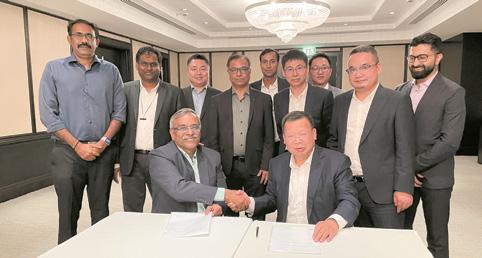

The National Renewable Energy Program, overseen by the Kingdom’s Ministry of Energy, Industry and Mineral Resources (MEIM), is a strategic initiative under Saudi Vision 2030 and the King Salman Renewable Energy Initiative. It is launched to maximize renewable energy share, diversify energy sources, and decarbonize the local economy. Installed in the Al Qassim desert area of Saudi Arabia, the inverters have to withstand high temperatures and sandstorms while the advanced safety designs like IP65 and forced-air cooling will ensure its stable operation and ongoing security. In addition, characterized as high efficiency, high energy density, convenient transportation, and easy installation, the inverters can help achieve lower LCOE as well as increase return on investment.
Sineng Electric will make a concentrated effort to provide support for the project and guarantee its smooth running with high-quality products and services. We look forward to mutual trust and win-win partnerships to create greater value for customers! Wu Qiang, chairman of Sineng, said at the signing ceremony.
The 700MW Ar Rass PV IPP will contribute to Saudi Vision 2030 by powering approximately 132,000 households in central Saudi Arabia with clean energy. And the cooperation also demonstrates the strength of Sineng and the recognition from the Middle East market. In the future, Sineng Electric will continue taking advantage of its advanced technologies to build a zero-carbon world.

www.EQMagPro.com 25 EQ MAY 2023
BUSINESS & FINANCE
VIBRANT ENERGY PLACES AN ORDER FOR C.149 MW WITH ENVISION ENERGY




Vibrant Energy (Vibrant), a leading corporate renewable energy solutions provider has placed an order totalling c.149 MW with Envision Energy (Envision). The order consists of 45 wind turbines with a capacity of 3.3 MW each, with delivery expected to commence from Q3FY24 onwards.
new green energy system and an enabler of a new green industrial system. In 2022, Envision achieved global operational carbon neutrality. I believe this collaboration will make a significant impact to the regions’ decarbonisation.”
Mr. Srinivasan Viswanathan, CEO, Vibrant Energy, said, "We are pleased to announce our partnership with Envision Energy for our upcoming wind-solar hybrid project. We look forward to delivering on our mission to decarbonize corporate customers through active support from Envision Energy for our future pipeline of projects.”


Mr. Kane Xu, Global Vice President of Envision Energy and Chairman of Envision Energy India, said, “Vibrant Energy is taking actions to help its clients attain a sustainable and lowcost energy future. We are very happy to have a partnership with Vibrant Energy, with aligned goals. Envision is both a builder of a

Mr. RPV Prasad, CEO, Envision Wind Power Technologies India said, “We are honoured to have been selected by Vibrant Energy as a trusted Net Zero Tech Partner for their forthcoming renewable energy project. As an organisation we have been dedicated to push the boundaries of renewable energy in India by accelerating adoption of wind energy in the country. We take pride in manufacturing 45 state-of-theart wind turbine generators for this prestigious project in India and contributing to Vibrant Energy's visionary pursuit of creating a sustainable future for all.”

26 EQ MAY 2023 www.EQMagPro.com
BUSINESS & FINANCE
AYANA RENEWABLE POWER TO PROVIDE 300MW OF ROUND-THE-CLOCK (RTC) RENEWABLE ENERGY TO REMCL A JOINT-VENTURE COMPANY OF MINISTRY OF RAILWAYS AND RITES LTD.
Project Nine Renewable Energy a fully owned subsidiary of Ayana Renewable Power won the capacity in reverse bid auction recently. The project will add approximately 1 GW of renewable capacity through solar and wind to Ayana’s portfolio and take it close to 5GW of cumulative capacity in operation, maintenance, and development.



National Investment and Infrastructure Fund (NIIF) backed Ayana Renewable Power Private Limited (Ayana) has bagged the tender on BOO basis to provide round-theclock supply of renewable energy to REMCL a Joint Venture company of Ministry of Railways and RITES Ltd. The 300MW capacity is won by its subsidiary, Project Nine Renewable Energy, in the competitive bidding process. The project is a first-of-its-kind, with a high degree of availability and dispatchability, and will add installed capacity of approximately 1 GW of renewables through solar, wind to Ayana's portfolio with third party storage arrangements. This takes Ayana's cumulative capacity in operation, maintenance, and development to over 5GW positioning it as one of the largest IPPs (Independent Power Producer) in India.
With an annual availability of over 85%, the project will provide firm renewable energy for 25 years and showcases the potential of RTC to enable baseload, rather than managing peak-load as has been traditionally done. Shivanand Nimbargi, MD & CEO of Ayana Renewable Power, commented, "RTC is the future of renewables, and we are proud to be first in the country to undertake the challenge of this tender which has stringent requirements on availability and dispatchability along with a 15min block settlement, making it a truly unique tender, and breaking new ground on reliable and firm renewable power. It also showcases the farsightedness of our government and policy makers who are ready to take up the challenge of RTC and a sign of a maturing industry and market that India now is, setting not only national but global benchmarks.”

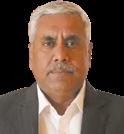
SAINT-GOBAIN SIGNS A MAJOR RENEWABLE ELECTRICITY SUPPLY AGREEMENT IN INDIA
Saint-Gobain has signed a Power Purchase Agreement (PPA) in India with Vibrant Energy – a portfolio company of Macquarie Asset Management's Green Investment Group (MAM-GIG) – to provide wind-solar electricity to 6 local Saint-Gobain sites.

The 20-year PPA will begin delivery in 2024 and bring the renewable electricity share in India to 65% in 2025. Under the agreement, Vibrant Energy will provide Saint-Gobain with 189 GWh of renewable electricity (solar and wind) per year, thus reducing SaintGobain’s CO2 emissions in India by around 120,000 tons per year. Through wide-ranging initiatives such as the replacement of fossil fuels with biomass, waste heat recovery and reuse, and circularity actions, Saint-Gobain is well on its way to achieving 100% renewable electricity in India by 2030.
Speaking on the partnership, Mr. B. Santhanam, CEO – Asia Pacific and India Region, Chairman at Saint-Gobain India, said, “The PPA is a significant step forward to not only meet the country’s 500GW renewable energy target but also increase the use of renewable energy sources in the manufacturing sector. Our commitment towards sustainability is at the core of our business strategy, and this partnership is a significant step towards achieving our goal of 100% renewable energy by 2030.”
This agreement, in addition to those previously signed by the Group in North America, Spain and Poland, is part of the Group's overall trajectory to achieve carbon neutrality by 2050.
www.EQMagPro.com 27 EQ MAY 2023
BUSINESS & FINANCE
SINGULUS TECHNOLOGIES EXPANDS PORTFOLIO WITH APPLICATIONS FOR THE GROWTH MARKET OF HYDROGEN TECHNOLOGY
SINGULUS TECHNOLOGIES successfully entered the expanding hydrogen market with the further development of suitable coating processes as well as the corresponding adaptation of its machine technology. Thanks to the company's core competence in vacuum coating technology (PVD sputtering) efficient solutions for various applications, such as the production of bipolar plates, can be provided.
SINGULUS TECHNOLOGIES works intensively with partners on the development and optimization of coatings for metallic bipolar plates used in fuel cells and electrolyzers. The modular inline sputtering system GENERIS PVD from SINGULUS TECHNOLOGIES enables the variable deposition of different layer systems and offers the possibility to sputter bipolar plates in all common sizes with a flexible substrate carrier system. The dynamic inline vacuum PVD sputtering enables high-quality and cost-efficient production.
Dr.-Ing. Stefan Rinck, CEO Singulus Technologies, "For the application in the production of fuel cells we are working on the development and optimization of the sputter process and the equipment technology for the deposition of metallic bipolar plates with suitable nitride and carbide protective layers as well as other innovative processes."

The modularly designed GENERIS PVD inline coating system can be used to deposit different coating systems. With its flexible substrate carrier system, the GENERIS PVD offers the possibility of coating bipolar plates in all common sizes. Dr. Stefan Rinck adds: "In cooperation with leading European institutes, we are working on optimizing the coating processes and results in the field of hydrogen technology. We are convinced that the use of green hydrogen makes ecological sense and that the market will grow at an above-average rate." Green hydrogen is produced by electrolysis of water, using only electricity from renewable sources such as solar, wind or hydropower for the electrolysis. Regardless of the electrolysis technology chosen, the production of hydrogen in this case is CO2-free, as the electricity used comes 100% from renewable sources and is therefore CO2-neutral.
MARKET FOR HYDROGEN GROWING STRONGLY
The direct or indirect use of hydrogen offers high potential for the electrolysis, industrial and transport sectors, and in the long term also in power generation. It is becoming increasingly clear that hydrogen will play a central role in greenhouse gas neutrality. Water electrolysis will become a critical industrial policy component.
The projected demand for green hydrogen electrolysis plants far exceeds the current supply. According to a study by the German Academy of Science and Engineering, there is a need for at least 20 GW of installed electrolysis capacity for the production of hydrogen in 2030 for industry in Germany alone. The German government's National Hydrogen Strategy assumes a hydrogen demand of approximately 90 to 110 TWh per year by 2030 and aims to build an electrolysis capacity of at least 10 GW by 2030. For example, in the study "Hydrogen-based Industry in Germany and Europe" (2021), Enervis Energy Advisors assumes a hydrogen demand for Germany of 110 TWh in 2030, 260 TWh in 2040 and 450 TWh in 2050. With the GENERIS PVD inline coating machine SINGULUS TECHNOLOGIES makes a significant contribution to efficient and cost-effective hydrogen production.
BACKGROUND ELECTROLYSIS
Several electrolysis processes compete on the market with their respective advantages and disadvantages depending on the field of application: alkaline, PEM or high-temperature electrolysis. The first two processes use steel or titanium bipolar plates stacked together with a membrane and gas-conducting elements. High-temperature electrolysis is based on a ceramic solid membrane. A very promising process for hydrogen production for non-uniform operation, i.e., renewable energy sources, is PEM electrolysis (PEM: Proton Exchange Membrane). Due to the expected market for electrolyzers, inline cathode sputtering plants with their large throughput are ideally suited here for PEM as well as for alkaline electrolysis.
SINGULUS TECHNOLOGIES – THIN-FILM TECHNOLOGY AND SURFACE TREATMENT

SINGULUS TECHNOLOGIES develops and builds innovative machines and equipment for efficient production processes in thin-film technology and surface treatment, which are utilized world-wide in the markets of photovoltaics, semiconductors, medical technology, packaging, glass & automotive as well as batteries & hydrogen. The company’s core competencies include processes of coating technology, surface treatment as well as wet-chemical and thermal production processes. SINGULUS TECHNOLOGIES views sustainability as an opportunity to position itself with innovative products.

28 EQ MAY 2023 www.EQMagPro.com
HYDROGEN
THERMAX GROUP POSTS QUARTERLY AND ANNUAL PAT GROWTH OF 51% & 45% YOY RESPECTIVELY
Thermax Limited, a leading energy and environment solutions provider, reported its results for the fourth quarter ended March 31, 2023. In keeping with its robust performance over the past three quarters, the company posted a consolidated operating revenue of Rs. 2,311 crore (Rs. 1,992 crore), up 16%. Profit after tax (PAT) stood at Rs. 156 crore, up 51% as compared to Rs. 103 crore in the corresponding quarter of FY ‘22. The order booking for the quarter was 34% lower at Rs. 2,254 crore (Rs. 3,396 crore). In the last quarter of the previous year, a significant order of Rs. 1,176 crore was booked for a sulphur recovery block, and an order of Rs. 546 crore was received for a flue gas desulphurisation (FGD) system.

Key Highlights
• Board recommends a dividend of Rs. 10 per share.
• Thermax regrouped its business segments.

On a standalone basis, Thermax Limited posted an operating revenue of Rs. 1,490 crore during the quarter, 16% higher as compared to Rs. 1,281 crore in the corresponding quarter, last year. Profit after tax for the quarter was Rs. 122 crore (Rs. 71 crore), up by 72%. Order booking for the quarter was 49% lower at Rs. 1,483 crore (Rs. 2,927 crore). For the financial year 2022-23, Thermax Group posted a consolidated operating revenue of Rs. 8,090 crore, up 32% as compared to Rs. 6,128 crore in the previous year. Profit after tax for the year stood at Rs. 451 crore (Rs. 312 crore), up 45%. Order booking for the year at a consolidated level stood at Rs. 8,788 crore as compared to Rs. 9,410 crore in FY ‘22, down 7%. Thermax Group had an order balance of Rs. 9,752 crore (Rs. 8,812 crore), up 11%. The Board recommended a dividend of Rs. 10 per share for 2022-23.
In FY 2022-23, Thermax has taken a strategic decision to realign the disclosure related to Ind AS 108 ‘Operating Segment’, formerly Energy, Environment, and Chemicals, into four distinct categories: Industrial Products, Industrial Infra, Green Solutions and Chemical. This is to align the disclosures in line with the allocation of resources and assessment of business performance by the Managing Director and CEO. This aims to disclose the new energy solutions businesses such as Thermax Onsite Energy Solutions Limited (TOESL) and First Energy Private Limited (FEPL), under the buildown-operate model for industrial energy & utility. The reclassification of businesses under each segment is based on several factors, including nature of the business offer, customer base, capital employed, and risk to name a few. This strategic step aligns with Thermax's future priorities and the changing energy and environment requirements to provide sustainable solutions for a better tomorrow.
www.EQMagPro.com 29 EQ MAY 2023 QUARTER
RESULT
GOVERNMENT TO LAUNCH NEW SCHEME FOR LIVELIHOOD


APPLICATIONS OF DISTRIBUTED RENEWABLE ENERGY: UNION MINISTER RK SINGH


– Clean tech can impact 37 million livelihoods in India's agri & textile sectors, present INR 4 lakh crore opportunity – 70% of women and farmers using clean technology reported an income increase – Union Minister R. K. Singh also launched ‘Suraj ka Gola’, India’s solar energy anthem
Our government is coming out with a new scheme for distributed applications of renewable energy (RE). There is already a lot of work happening on the ground and our scheme could benefit lakhs of families across the country. We will, however, need large scale-manufacturing and standardising of distributed applications of RE to lower prices and expand the sector. We have seen the potential of grid-scale solar power, India will scale up distributed applications of renewable energy for livelihoods. Just like we have a large programme on rooftop solar and solar irrigation, we will create a large programme for DRE livelihoods, said Shri R. K. Singh, Union Minister for Power, and New & Renewable Energy, at the 'National Summit on Powering Sustainable Livelihoods' organised by the Council on Energy, Environment and Water (CEEW) and Villgro Innovations Foundation's Powering Livelihoods initiative.

“The government plans to make DRE livelihood equipment affordable. One aspect of this will be tying up with banks. If a family wants to own a solar dryer, they should be able to get financing from the banks – we will work towards it. Manufacturers and users of DRE for livelihoods are pioneers and now the government will scale it up to the next level,” he added.
Union minister R. K. Singh released two new reports by CEEW and Villgro, which show that clean technologies have the potential to impact 37 million livelihoods in India's agriculture and textile sectors and translate into a market opportunity worth almost INR 4 lakh crore (about USD 50 billion). Further, 70 per cent of women and farmers using clean technology reported an income increase, typically by 35 per cent. They use clean-energy powered products such as solar-powered silk reeling machines, multi-food processors, micro solar pumps, solar vertical fodder grow units, among others, to enhance and diversify their income.
Shri R. K. Singh also launched ‘Suraj ka Gola’ — a solar anthem produced by CEEW and Villgro. Created in collaboration with the band Maati Baani and Ashish Kulkarni of Indian Idol fame, the song celebrates how solar energy is transforming lives and livelihoods in rural India.
In India, solar-powered pumps—higher capacity and micropumps—have the maximum deployment potential, followed by solar-powered vertical fodder growing units and solar dryers. Collectively, these four technologies alone can impact around 27 million livelihoods. Unsurprisingly, solar pumps are the most mature among these technologies due to the government programmes supporting them since 2015.
Abhishek Jain, Fellow and Director –Powering Livelihoods, CEEW, said, “India is among the global leaders in clean energy transition. With a programme like Powering Livelihoods, we are taking this clean energy transition to the masses and contributing to their incomes and livelihoods. By deploying more than 11,000 such technologies across India since the pandemic, we have shown the impact of clean-energy-powered livelihood technologies on enhancing and diversifying people’s incomes. In a country where a million youth reaches the working-age population every month, we need to aggressively support jobs and livelihoods.”
The reports found that clean-tech-powered technologies have the greatest impact opportunity in Uttar Pradesh, followed by West Bengal, Bihar, Gujarat, Maharashtra, Madhya Pradesh, and Karnataka. But the relative market for each livelihood technology varies across states. For example, micro solar pumps have the highest market in West Bengal, whereas solar dryers have the highest market in Maharashtra. Further, the CEEW-Villgro analysis highlighted that women form the majority of these clean tech users currently. Out of the 767 users surveyed across 19 states, 74 per cent of respondents were women. The clean technologies deployed brought out several social impacts as well.
30 EQ MAY 2023 www.EQMagPro.com FEATURED
Ananth Aravamundan, Sector Lead – Climate Action, Villgro, said, “Through Powering Livelihoods, we have supported social entrepreneurs who are trying to create lakhs of livelihoods in rural India by harnessing renewable energy, using scalable and replicable business models. Over a 15-year investment horizon, the clean tech product variants become more attractive than their grid alternatives. We hope that the evidence generated by this programme will motivate policymakers, financiers and manufacturers to extend support to mainstream such livelihood products.”

However, to unlock the full potential of clean tech in rural India, on-ground challenges will need to be solved too. The use of these technologies is often constrained by raw material unavailability, limited earnings due to poor market linkages, and a lack of service support in rural areas. A concerted effort is required by stakeholders to commercialise these technologies through enhanced capital support to manufacturers and affordable credit to end-users.

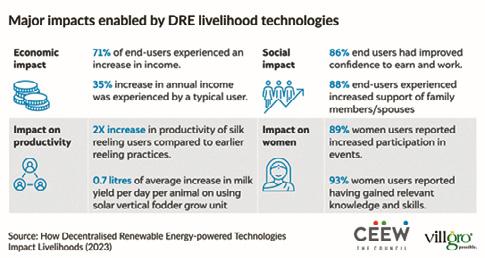


www.EQMagPro.com 31 EQ MAY 2023 FEATURED
FEATURED
SolarSpace (Jiangsu Zhongrun Solar Technology Development Co.,Ltd.), a leading global manufacturer of solar cells and modules, announced on 15 May that its initial public offering (IPO) has been accepted by the Shenzhen Stock Exchange (SZSE).
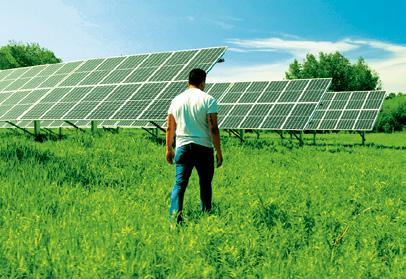

According to the announcement, SolarSpace plans to raise 4 billion yuan through the IPO. 2 billion yuan of the funds raised will be used for the construction of the second phase of its 8GW high-efficiency solar cell production project, with a total investment of 2.659 billion yuan. A further 2 billion yuan will be used for capital replenishment. The financial support is expected to reduce SolarSpace’s need for debt financing and reduce its debt burden. In addition, SolarSpace’s solar cell production capacity has reached 24GW by the end of 2022 and is expected to increase to over 50GW by the end of 2023. Meanwhile, its conversion efficiency of monocrystalline PERC cells had exceeded 23.5% in 2022, while the cost of non-silica material had dropped to 0.14 yuan/W. And in early 2023, SolarSpace’s TOPCon cell achieved a conversion efficiency of more than 25%. Furthermore, SolarSpace’s operating revenue continued to grow, reaching 2,532,929,100 yuan, 5,088,906,000 yuan and 12,552,063,900 yuan in the last three years, with a compounded growth rate of 122.61%. And its net profit attributable to equity holders of the parent was 830,057,300 yuan in 2022, up from 112,203,600 yuan in 2020.

4 BILLION YUAN! SOLARSPACE’S IPO ACCEPTED BY SHENZHEN STOCK EXCHANGE SOLPLANET PARTNERS WITH POWER N SUN TO DISTRIBUTE SOLAR ENERGY SOLUTIONS
Solplanet is pleased to announce its partnership with Power n Sun, a leading provider of distributed solar energy solutions in India, to provide efficient and cost-effective solar energy solutions to customers across the globe.
The partnership between Solplanet and Power n Sun will enable customers to benefit from the latest developments in solar energy technology, including high efficiency solar inverters, advanced monitoring systems, and innovative storage solutions. Solplanet and Power n Sun are committed to increasing access to renewable energy and providing customers with the best products and services available.The partnership will see Solplanet providing a comprehensive range of solar inverter solutions, including single or three phase on-grid inverters, hybrid inverters, EV chargers and connect & monitoring solutions. Power n Sun will provide the necessary expertise and resources to ensure that customers have access to the latest technologies and products, as well as comprehensive support for installation and maintenance. We are committed to providing our customers with the best possible solar energy solutions. Solplanet and Power n Sun combined experience and expertise in the industry will allow us to deliver cutting-edge products and services, such as solar inverters, batteries, and energy monitoring systems, to our customers.
32 EQ MAY 2023 www.EQMagPro.com
MR. RAHUL SHARMA
a prominent and emerging leader, Director & CEO-VNT

EQ: Kindly enlighten our readers about all your offerings, products, and verticals
RS: VNT offers solutions ranging from highly efficient telecom power systems and power management systems, to wireless solar string monitoring solutions, earthing and lightning protections, and state-of-the-art fire protection solutions.
VNT is connecting India through its telecom solutions. Our Super High-Efficiency SMPS is powering the telecom towers in remote areas, enabling telecom connectivity for the end-user and enriching their lives. We empower solar farms with an array of energy-efficient and sustainable solar solutions. Solar String Combiner Boxes with Monitoring from VNT are a plugand-play solution for solar installations that makes supervision easy. We develop accessible power generation resources and assist with utility-scale and rooftop projects for businesses in India and abroad by leveraging our ingenuity, portfolio, and commitment. Aligned with the UN SDGs, our Sustainable Development Agenda is to pioneer solutions that aid in the utilisation of renewable energy in the domains of telecommunication, fire safety, asset monitoring, and lightning and surge protection. VNT is contributing to India’s goal of becoming carbon neutral by 2070. Our vision is "To simplify and provide innovative and efficient energy systems" and our mission is "To help the world become greener, connected, and protected." In line with our vision and mission, we are currently focused on four verticals: telecom, solar, fire and safety, and EV. In the Climate Change Space, we see strong emergence of e-Mobility, Energy Storage.
I completed my bachelor's degree in Electronics & Communications in 1997 and embarked on a career in the consumer electronics industry. With a wealth of experience gained across various departments, I transitioned into the telecom sector and later ventured into the renewable energy field. Throughout my journey, I was at Country Head positions in different capacities, shouldering responsibilities for P&L across multiple organizations nationwide. Currently, I proudly serve as the CEO of VNT (Vrinda Nano Technologies), leading a team of over 400 dedicated professionals. Our unwavering passion for harnessing innovative technologies has propelled us to spearhead the delivery of cutting-edge solutions. At VNT, we are fully committed to meeting your present needs while strategically planning for future business endeavours. With an unwavering focus on safety and quality control, we strive to provide unmatched solutions that cater to the ever-evolving requirements of the critical sectors we support. Integrity and a strong dedication to serving others form the cornerstone of our holistic approach. We prioritize addressing critical priorities and developing comprehensive strategies that align with your business objectives. As we continue on this path, we remain steadfast in our mission to deliver unparalleled solutions that expand horizons and elevate business utility. Join us as we embark on an exciting journey of technological advancement, anticipating your needs and paving the way for a successful future..Our enthusiasm for leveraging innovative technologies has bolstered us in spearheading the delivery of solutions by harnessing technological advancement. We are committed to increasing business utility by anticipating your present needs and planning future business strategies. We deliver unparalleled solutions in their scope of expandability to cater to the ever-challenging needs of the critical sectors we support, with safety and quality control as our highest priorities. Our integrity and willingness to serve underpin our holistic approach to addressing critical priorities and developing comprehensive strategies.
EQ: What is your market share of string monitoring boxes and string combiner boxes in India?
RS: VNT has been manufacturing string combiner boxes and string monitoring boxes for a little over a decade now, We have supplied more than 25 GW of solar power plants in PAN India, and have approx. 50% market share as of today’s date. We strive to acquire 80–90% market share in 2–3 years.
EQ: You have been in the market for a long time and are growing a lot. What has been your strategy for growth and success?
RS: We are glad to inform that Vrinda Nano Technologies has supplied power management solutions to more than a 100,000 telecom sites and supplied combiner boxes, monitoring devices in more than 25 GW of solar power plants, and EV charger solutions for various sectors. We have started various new verticals catering to consumer, industrial, railway, and defense sectors, and developed new high efficiency rectifiers and SMPS for telecom. VNT was incorporated in 2003 with the vision of providing reliable solutions and comprehensive services of the highest quality in order to ensure customer satisfaction. The company brings decades of expertise to its clients' businesses through its integrated approach that meets stringent expectations for power management solutions, energy conservation, fire safety, lightning and surge protection, and asset monitoring. In the ever-challenging business sectors such as telecommunications, renewable energy, defense, railways, and others, the company constantly seeks new and innovative ways to make every operation reliable, flexible, safe, and sustainable. It focuses on enhancing business utility and intervention to work for a client, anticipating client needs today, and preparing business strategies for tomorrow. With a dedicated team of technical experts and certified professionals, our maintenance services allow businesses to manage unforeseen risks. We place a high value on comprehensive earthing audits, electrical health and safety audits, energy audits, and more, from visual inspections to comprehensive risk consulting. Our long-term vision and commitments put the resilience and reliability of our services to the test.
EQ: What are your plans for overseas expansion? Currently, you are operating in all markets; what’s the future plan?
RS: We have started our operations in the Philippines, UAE, Indonesia, and Saudi Arabia. We will soon be entering in the North American market. We are always committed to providing world-class products with an aspiration of Indian roots and a global mindset.
EQ: What are your views on the same, and how do you plan to tap this growing opportunity.
RS: VNT is taking a bold step into the flourishing EV market in India, recognising the tremendous potential of the EV ecosystem. With electric vehicle sales in India predicted to hit a whopping 1.7 million units in FY 2023 and sales surging at an impressive rate of 130 percent YoY and a projected 153 percent growth in FY 2023, VNT has already bagged many orders for EV charger solutions and is confident of growing the EV vertical in line with the growth of e-mobility in the country.

www.EQMagPro.com 33 EQ MAY 2023 EXCLUSIVE
GET LUXURY E-BUSES FINANCED BY BANKS FOR INTER-CITY SERVICE, PAY DAILY EMI FROM REVENUE: GADKARI TO STATES

This model can effectively address the issue of procuring expensive buses, solve connectivity woes and make the state transport corporations profitable, Gadkari reportedly said.
Union Minister of Road Transport and Highways Nitin Gadkari, in his recent meeting with the state transport ministers, shared a new model for increasing the fleet of luxury electric buses, a report said on April 24. Gadkari advised them to get the high-standard e-buses financed from banks or financial institutions, and pay the equated monthly installments (EMIs) on daily basis using the revenue mopped up through operating them, the Times of India report said. The e-buses should be deployed for inter-city connectivity, the minister reportedly suggested. Gadkari told the state ministers that this model can effectively address the issue of procuring expensive buses, solve connectivity woes and make the state transport corporations profitable, sources privy to the development told the newspaper. Some of the state ministers showed interest in Gadkari’s suggestion, and would consider procuring the e-buses through the model he recommended, the sources added.
“The state transport corporations are not in good shape to procure buses. So, they can get such buses financed and pay back the instalments daily, weekly or monthly,” an official aware of the discussions was quoted as saying. Moneycontrol could not independently verify the news. E-buses, which are environment-friendly and also considered to be cost-effective, are increasingly being used by state governments across the country. As per the Centre’s National Electric Bus Programme, the plan is to deploy 50,000 e-buses nationwide, in tranches over the next four-to-five years, at an estimated cost of $12 billion.
Source: PTI
UNEECOPS TECHNOLOGIES TO SET UP INDIA’S FIRST GREEN HYDROGEN MICROGRID PROJECT IN LEH REGION

Delhi-based green hydrogen and solar developer, Uneecops Technologies Ltd, has announced that it will set up the First Green Hydrogen Microgrid Project in Leh Region for one of India’s major hydro-power companies. The company will help in the engineering, procurement, and construction (EPC) for putting up a green hydrogen-based fuel cell microgrid 25kWe for the guest home at Power Station, Alchi, Leh.


This innovative project, the first of its kind in the world, will be developed at a very high altitude of 3200 feet and represents a significant advancement in sustainable energy. The microgrid project aims to demonstrate the viability of green hydrogen-based fuel cells as a reliable source of energy for remote and off-grid locations, making it a sustainable and cost-effective solution. Uneecops Technologies will provide three years of Operations & Maintenance service, ensuring smooth and uninterrupted operation of the microgrid. The company is committed to promoting the use of sustainable energy solutions to help mitigate the impacts of climate change. The project will be completed by Uneecops Technologies, who will be responsible for the design, procurement, and building of the microgrid using the latest technology and equipment to assure the highest levels of efficiency and dependability.
We are happy to be the first firm in India to build up the First Green Hydrogen Microgrid Project in Leh Region and are excited to display our green hydrogen-based fuel cell technology at one of the most demanding regions in India. We at Uneecops Technologies are very proud to be at the forefront of this revolutionary technology, said Mr. Piyush Jain, Chairman, Uneecops Technologies.
The project is anticipated to be finished by the end of 2023 and will give the large hydro-power company’s guest home at Power Station, Alchi, Leh, a dependable supply of electricity for many years to come. Uneecops Technologies is dedicated to creating ground-breaking technologies that contribute to building a better, more sustainable world.
Source: PTI
34 EQ MAY 2023 www.EQMagPro.com
Source:
PTI
CENTRE ASKS STATES TO POOL TARIFFS OF OLDER POWER PLANTS
The new scheme, according to them, aims to use the capacity of more than 25-year-old power plants that are still technically fit to operate.
AIRTEL TEAMS UP WITH SECURE METERS TO DEPLOY 1.3 MN NB-IOT POWERED SMART METERS IN BIHAR
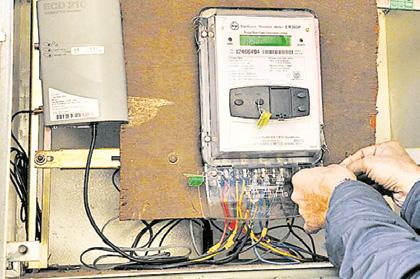
Airtel’s NB-IoT platform is future-ready and is scalable to 5G, the telco said in a release. Telecom operator Bharti Airtel announced its partnership with Secure Meters for deploying Narrow Band-Internet of Things (NB-IoT) services to power 1.3 million homes in Bihar via a smart meter solution.
The telco said this deployment will be India’s first NB-IoT solution on a narrow band with a fall-back option that will work on 2G and 4G, and ensure real-time connectivity and uninterrupted transfer of critical data. NB-IoT is a lowpower, wide area, radio network technology which enables a wide variety of IoT devices and services, including smart meters. Airtel’s NB-IoT platform is future-ready and is scalable to 5G, the telco said in a release.


Ajay Chitkara, Director and CEO of Airtel Business, informed that IoT is one of the fastest-growing business segments for Airtel Business. “This venture into NB-IoT strengthens our credentials as the largest cellular IoT player in the country and places us firmly as a partner of choice for Discoms looking to invest in smart meters. We look forward to being an active player in India’s energy transition,” Chitkara said.

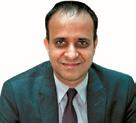
The Centre has asked all states to implement the proposed scheme of pooling tariffs of older thermal and gas-based power plants whose power purchase agreements (PPAs) have ended, people aware of the development said. The states have been asked to comply with the order by July 1. The new scheme, according to them, aims to use the capacity of more than 25-year-old power plants that are still technically fit to operate.
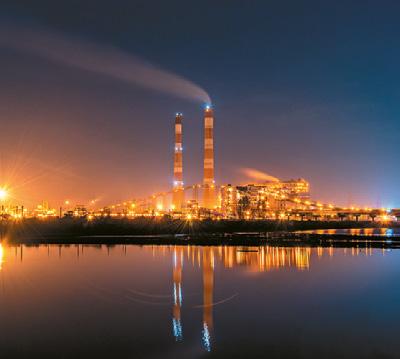
“The ministry of power has issued a notification in this regard, and we will soon identify the plants that can fit in the new scheme,” a senior energy department official said. “As the stations of over 25 years have their capex recovered and are fully depreciated, debt free… power at competitive tariffs from these stations can be made available to beneficiaries,” said the notification.
Ananya Singhal, Joint MD – Secure Meters, said: “With Airtel’s support, we were able to seamlessly connect and monitor our meters, resulting in greater efficiency and cost savings for secure and for our customers in North Bihar.
“Accordingly, to utilize these capacities, it has been decided to pool power from all Central Generating Station (CGSs) whose PPAs have expired, and such pooled power shall be made available to willing beneficiaries,” the notification added. The willing beneficiaries will have to enter PPA for a duration of a minimum of five years. Discoms not finding value in pooling will be able to opt out from the pool after five years. “The measure will ensure availability of adequate resources in the grid for peaking, balancing, and flexing, and re-distributing benefits such as reliability and cost-effectiveness for beneficiaries,” it pointed out.
Source: PTI Source: PTI
www.EQMagPro.com 35 EQ MAY 2023 INDIA
DISCOVERY OF BIGGEST DEPOSIT OF LITHIUM IN J&K WILL BE HISTORIC MILESTONE IN ATMANIRBHAR BHARAT: ARJUN RAM MEGHWAL

The Minister said that Lithium deposits will not only give fillip and boost to the industrial sector in India but will give further push to the country to become ‘Vishwa Guru’ under the leadership of Prime Minis ter Narendra Modi. Meghwal was speaking to investors and industrial ists at a conclave organised by Laghu Udhyog Bharati. “Go to any show room, you will now get electric vehicles. One can get it fast. But there was a problem. It can run on a Lithium-based battery. Where can we get Lithium? It is imported from China and Brazil. “But now with the blessings of Mata Vaishnodevi Devi, we got Lithium un der her feet (Reasi district of Jammu and Kashmir). It is the biggest deposit in the world. It is not a small thing. It is going to be a historic milestone in AtmaNirbhar Bharat”, Meghwal told PTI.
The government is focussing on electric vehicles and hybrid model of transport and Lithium discovery will give this in dustry a huge jump. “We have got Lith ium here. It will not only give a great boost (to the economy of) Jammu and Kashmir but to the entire country as well. The industry will have a jump as we have got a huge deposit of Lithium,” he said. “Now we are having electric buses and trucks. We also gave fillip to hybrid setup. Any trucker can use the hybrid method by using petrol till he gets his vehicle charged. They can charge it to the next charging point and that too in the fast mode”, he said. He said PM Modi has set a target of a five trillion economy for the country. “Now we are close to a three trillion economy. This will make India a Vishwa Guru”, he said.
TORRENT POWER FORMS SUBSIDIARY FOR POWER GENERATION, TRANSMISSION BIZ

Torrent Power Ltd has incorporated a wholly-owned subsidiary for generating and transmission of power.
“TU10 is incorporated with an objective to carry on the business of generation, transmission,
distribution, purchase, procurement, sale, trading, import, export or otherwise deal in all forms of electrical power and energy including non-conventional and renewable sources of energy,” it said.

36 EQ MAY 2023 www.EQMagPro.com INDIA
The discovery of biggest Lithium deposits in the foothills of Mata Vaishnodevi in Jammu and Kashmir’s Reasi district is going to be a historic milestone in AtmaNirbhar Bharat, Union minister Arjun Ram Meghwal said
The subsidiary, Torrent Urja Pvt 10 (TU10), was registered in Ahmedabad on April 21, 2023, and is yet to commence its business operations, Torrent Power said in a regulatory filing
Source: PTI
JSW ENERGY ARM
COMMISSIONS 51 MW WIND PROJECT IN TAMIL NADU

RWAS SWITCH ON SOLAR POWER TO BRING DOWN ELECTRICITY CHARGES IN HYDERABAD


Solar power systems are now a go-to method for an increasing number of residential welfare associations (RWAs) in Hyderabad to reduce their monthly electricity bill.
Case in point: Six RWAs in Dayanand Nagar Colony near Safilguda have installed solar power panels in recent times, with a few more gated communities and stand-alone apartments here showing keen interest in the systems. “RWAs are struggling to keep a tab on rising electricity bills owing to increased power consumption and the latest tariff revision,” BT Srinivasan, secretary of the United Federation of RWAs (UFERWAS), told TOI. RWAs are now going for solar power systems with a capacity of 1kW to 3 kW encouraged by central government’s subsidy. Source: PTI
Until recently, flat owners of an apartment at Devi Nagar Colony in Neredmet had been paying upwards of 3,000 a month as their individual electricity charges. The bill also included charges for shared electrical utilities such as water pumps, lift and common area lighting. The apartment has now installed rooftop solar power panels with 3kW capacity and residents are expecting a significant reduction in electricity charges. Solar panels are a one-time investment and the system can last as much as two decades with proper maintenance, said Srinivasan. More than 160 residential colonies across the city have installed small-capacity rooftop solar power systems in recent years, said SK Raju, secretary All-India Renewable Energy Association for Telangana and Andhra Pradesh and UFERWAS advisor. The cost of installing a solar power system of 2kW to 3 kW is between 1.7 lakh and lakh, said Raju, who also supplies the systems. He said there has been a surge in demand for solar power in Madhapur and surrounding areas and he has been receiving enquiries on a daily basis.
JSW Renew Energy Two Limited has commissioned 51 MW of wind power capacity under phase-wise commissioning of 450 MW ISTS-connected wind power project awarded under SECI tranche X in Tamil Nadu,” JSW Energy said in a regulatory filing. Subsequent to this, the total current installed capacity of the company has reached 6,615 MW while the under-construction capacity stands at 2,855 MW, which is likely to be commissioned in phases over the next 12-18 months, it said. JSW Energy has a target to reach 20 GW capacity by 2030 and a nearterm target of 10 GW by 2025. The company has also made a foray into energy storage space and currently locked in 3.4 GWh of energy storage capacity by means of battery energy storage system and hydro-pumped storage plant.
www.EQMagPro.com 37 EQ MAY 2023 INDIA
JSW Energy announced the commissioning of a 51-megawatt (MW) wind energy project in Tamil Nadu by one of its step-down subsidiaries.
MUMBAI: BMC SETS UP SOLAR POWER PLANT ATOP ASIA’S LARGEST SEWAGE PUMPING STATION AT MAHIM
The BMC, in a press release, said the 230 kw capacity solar power plant has been generating more than 30,000 units of power every month, bringing savings of Rs 2.40 lakh for the civic body
The Brihanmumbai Municipal Corporation (BMC) said that it has set up a solar power generation plant atop Asia’s largest sewage pumping station at Mahim causeway. The BMC, in a press release, said the 230 kw capacity solar power plant has been generating more than 30,000 units of power every month, bringing savings of Rs 2.40 lakh for the civic body. The plant, set up with Rs 1.5 crore cost, has a life of 25 years and the expense incurred on it will be recovered in the next 6 years, said the release.
“The project will help curb more than 7,000 tonnes of carbon dioxide emissions over the next 25 years. Its environmental impact is equal to planting 11,000 trees,” the BMC stated.
The Mahim Causeway-based solid waste pumping station, touted to be Asia’s largest, was built in 2003. Sewage from the city, its western and eastern suburbs is pumped from the facility which has eight pumps.
Source: PTI
INDIA EYES GREEN HYDROGEN BUNKERING AT MAJOR PORTS BY 2035
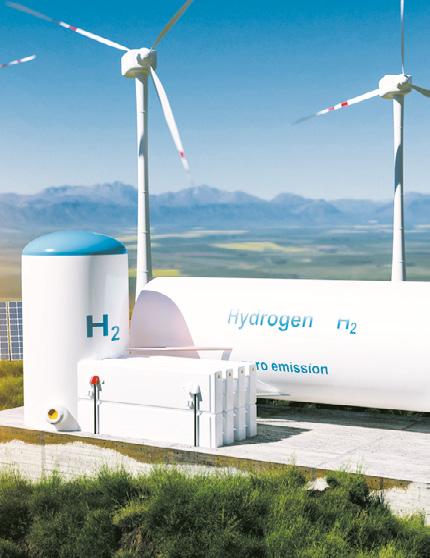
India has set a deadline of 2035 to establish green hydrogen bunkering and refuelling facilities at major ports in the drive to cut its carbon footprint, the shipping ministry said in guidelines issued. One of the world’s biggest emitters of greenhouse gases, India aims to cut emissions to net zero by 2070, and the shipping minister said three of its ports would initially have bunker facilities for green hydrogen and ammonia.
Our target is to cover all 12 major parts with a green hydrogen bunkering facility by 2035, Shipping Minister Sarbananda Sonowal told Reuters. The initial ports in the effort are to be Paradip in the east, Kandla in the west, and Tuticorin in the south. “Financing required to turn these ports into green ports is under consideration,” Sonowal added.


More than 200 ports dot India’s coastline, which stretches 7,500 km (4,660 miles), in addition to the 12 major ones, all together accounting for 95% of its trade by volume and 65% by value. Authorities want electricity to power at least half the vehicle and equipment needs of major ports by 2030, rather than diesel, and raise that figure further to 90% by 2047. “Whatever initiative we are taking aims to meet the 2070 goal of being a net-zero carbon nation,” Sonowal said. To meet the net-zero goal, at least 40% of India’s electricity will have to come from renewables. To that end, the new shipping guidelines require ports to satisfy at least 60% of electricity needs through renewables by 2030 and 90% by 2047. Also, by 2030, all ports must achieve cuts of more than a fifth in energy consumption on each tonne of cargo versus 2023, the guidelines show. To boost use of gas, the shipping ministry wants ports to set up at least one liquefied natural gas (LNG) bunkering station by 2030 and electric vehicle charging stations in and around port areas by 2025.
Source: PTI
38 EQ MAY 2023 www.EQMagPro.com INDIA
CHENNAI BEACHGOERS TAKE PART IN GREEN PLEDGE AND SIGNATURE CAMPAIGN AGAINST LITTERING AND THE NEED TO LIVE IN HARMONY WITH NATURE

Earthen Water Feeder for Birds hanged in Swai Madhopur, Rajasthan promoting eco friendly LiFEstyle. World Environment Day (June 5) is an occasion which brings together millions of people across the country for awareness and action for the environment. This year, the Ministry of Environment, Forest and Climate Change, Government of India envisages to celebrate the World Environment Day 2023 with a thrust on the Mission LiFE. The concept of LiFE, i.e., Lifestyle for Environment was introduced by the Hon’ble Prime Minister, at the World Leaders’ Summit in Glasgow at the 2021 UNFCCC COP26, when he gave a clarion call to rekindle a global pursuit to adopt sustainable lifestyle and practices. Mass mobilisation across the country on LiFE are being organized in the run-up to the celebrations.
NATIONAL MUSEUM OF NATURAL HISTORY (NMNH)
National Museum of Natural History in collaboration with National Zoological Park organised mass mobilization of MISSION LIFE in which 283 participants involved in tree hugging, enumeration and pledged to care for the environment to live a more sustainable LiFE. RMNH, Bhubaneswar organised Nest watching programme for 88 students of Aspire college, Bhubaneswar under Meri LiFE: Lifestyle For Environment today. RMNH, Mysore conducted Signature Campaign Activity on 07.05.2023 as part of MISSION LiFE (LIFESTYLE FOR ENVIRONMENT). 121 students and General public took part and learnt on the need for Eco-friendly LiFEstyle along with Interaction/Green Talk on LiFE Mission. RGRMNH, Sawai Madhopur organised Bird Water Feeder Hanging Programme in which 75 Students, Parents and Visitors actively participated and hanged Earthen Water Feeder for Birds.
NATIONAL CENTRE FOR SUSTAINABLE COASTAL MANAGEMENT (NCSCM)
In continuation of the public outreach on the Lifestyle for the Environment (LiFE) movement, NCSCM and Suzhal Arivom, an environmental organisation, organised a nature walk in Pallikaranai wetland, a marsh, an urban wetland, and a Ramsar site in Chennai city. As a part of this event, scientists from NCSCM and Suzhal Arivom members explained about the wetland ecosystem and the ecosystem services it provides. Further, they emphasised the need for conservation of the wetland. About 100 students from various schools in Chennai and 40 joggers participated in this event, which provided different learning experiences for the participants. Further, students and joggers took part in nature walks, which offer an opportunity to observe and learn about a diverse range of flora and fauna. This event trained children and the public in a simple manner about their environment, habitat, and the need to live in harmony with nature. As a part of this event, students and joggers took part in a green pledge against littering and the reduction of plastic pollution. Placards, pamphlets, and LiFE mascots were displayed on the wetland as part of this event. NCSCM scientists explained the importance of Mission LiFE to participants. As part of the mass mobilisation of the Lifestyle for the Environment (LiFE) movement, NCSCM organised an awareness programme on the ban of single-use plastics and the use of eco alternatives at Besant Nagar Beach, Chennai. As a part of this event, beachgoers took part in a green pledge and signature campaign against littering and the need to live in harmony with nature. Placards, pamphlets, and LiFE mascots were displayed on the beach as part of this event. Scientists explained the importance of Mission Life to over 200 beachgoers. The importance and need for coastal conservation and the reduction of plastic pollution were highlighted. In this campaign, the focus is on educating the public on the need for an ecofriendly lifestyle to reduce their carbon footprint.
ZOOLOGICAL SURVEY OF INDIA
Zoological Survey of India organised a blood donation camp in Canning, Sundarbans, West Bengal as part of the mass mobilisation of the Lifestyle for Environment (LiFE) movement to spread awareness among the rural people to adopt Healthy lifestyle under Mission LiFE. ZSI, Canning Centre in Sundarbans, West Bengal in collaboration with Bhandhumahal Association, Canning Government Hospital jointly organised the Blood Donation Camp in Canning, in which around 120 participants from the nearby villages and 68 blood doners took part in the program. Dr. Yogesh Kumar, Scientistin-Charge of ZSI, Canning gave a talk to the rural people of Sundarbans on the objectives of Mission LiFE and make them aware of the importance of adopting healthy lifestyle and choose LiFE for protection of their fragile Environment.
www.EQMagPro.com 39 EQ MAY 2023 INDIA
TESLA APPROACHED INDIAN GOVERNMENT: OFFICIAL
Prime Minister also likely to meet Elon Musk in his visit to US next month: Sources
Global electric vehicle (EV) giant Tesla is revisiting its plans to set up a factory in India, for both domestic and exports and it has not asked the Indian government to also consider a duty cut, sources privy to the development said. A senior leadership team from Tesla has met the top government officials here, but the company did not discuss lowering import tax on electric cars, the sources said.
“They had approached for a meeting, and it was largely around meeting of the Prime Minister Narendra Modi’s visit to the US next month, in which Tesla founder Elon Musk is also likely to meet him,” a senior government official told businessline.

The Prime Minister will go to the US on a State visit on June 22 following an invitation from President Joe Biden and First Lady Jill Biden. The US President and the First Lady will also host PM Modi to a state dinner. The US and India last month announced an initiative on critical and emerging technology, a plan to share advanced defence and computing technology, including the joint production of General Electric jet engines. The Indian government has not accepted Tesla’s earlier proposal of seeking duty cuts, to promote domestic manufacturing. “Now, we do not know whether they are coming with the same proposal or bringing another proposal,” the official said. Last year, Musk had said that the company, which was earlier seeking a reduction in import duties to sell its EVs in India, would not manufacture its products unless it is allowed to first sell and service its cars in the country. The company, which also accepted pre-bookings from customers in India for its Model 3 in 2016, with a booking amount of $1,000, had to drop the plan because India has the highest import duties in the world. Currently, India imposes 100 per cent import duty on fully imported cars with CIF (Cost, Insurance and Freight) value more than $40,000 and 70 per cent on those costing less than the amount. Road Transport and Highways Minister Nitin Gadkari had also said that if Tesla was ready to manufacture its EVs in India, there was ‘no problem’, but the company must not import cars from China.
Source: PTI
HIMACHAL TO FRAME NEW ENERGY POLICY: CHIEF MINISTER
While presiding over a meeting of the Energy Department here late last evening, Chief Minister Thakur Sukhvinder Singh Sukhu said that the State Government mulls to frame a new Energy Policy, aiming at providing more share to Himachal Pradesh in various hydropower projects.
The Chief Minister said that under the new policy, the provision of deferment of free power royalty will be completely abolished in future and consider abolishing the relaxation given earlier. He said that there would be a provision to give 15 per cent share to the state government for the first 12 years, 20 per cent for the next 18 years and 30 per cent for the next 10 years. So far, there is a provision of 12 percent for the first 12 years, 18 percent for the next 18 years and 30 percent for the next 10 years, he added.

“Efforts would be made to increase the State’s share in those projects which have recovered its cost, for which correspondence would be initiated with the Central Government and other PSUs,” said Sh. Sukhu and adding that for all upcoming hydel power projects, the land would be given for forty years lease as per the policy of the government. The Chief Minister took a serious note of central PSUs for not signing pre-implementation and implementation agreements to set up hydro power projects and directed the Energy department to issue notices. Apart from this, he also directed to simplify the process of providing NOCs for the construction of hydro power projects. Sh. Sukhu said that 172 hydropower projects of 11149.50 MW capacity have been commissioned in the State, while 58 projects of 2454 MW capacity were under construction. He said that there should not be unnecessary delay in the hydro power projects being constructed through various Undertakings of the State Government and the Energy Department should develop a mechanism to monitor them. He said that delay in construction of projects causes financial loss to the State coffers. The Directorate of Energy would be strengthened and artificial intelligence would also be used to improve the functioning of the department, he added.
The Chief Minister said that many hydro power projects have not started construction work despite taking one time amnesty, in such a situation, the allotment of these projects should be cancelled immediately and a fresh advertisement should be published. He emphasized that power generation was the main source of income for the State Government and would not be compromised by any loss to the State exchequer. The Chief Minister also reviewed the construction of solar projects being set-up in the State and directed to speed up the construction work. He said that the State Government has set a target of starting 500 MW solar power projects this year and the department should work earnestly in this direction. Industries Minister, Harshwardhan Chauhan, Principal Advisor to the Chief Minister, Ram Subhag Singh, Chief Secretary, Prabodh Saxena, Principal Secretary to Chief Minister, Bharat Khera, Secretary MPP & Power, Rajeev Sharma, OSD to the Chief Minister, Gopal Sharma, Director Energy Department, Harikesh Meena and other senior officers were present in the meeting amongst others.
Source: himachalpr
40 EQ MAY 2023 www.EQMagPro.com INDIA
INDIA SAYS 50 LAKH PEOPLE DIRECTLY DEPENDENT ON COAL MINING; WILL PRESS FOR ‘JUST ENERGY TRANSITION’ AT G20
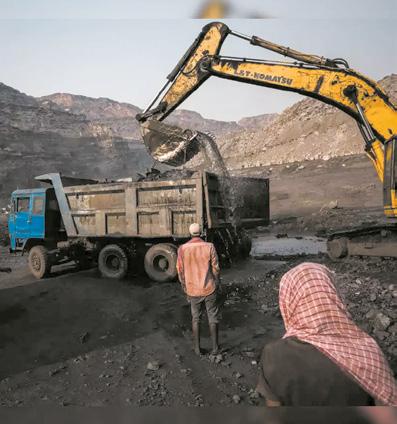
Union coal secretary Amrit Lal Meena said questions surrounding livelihoods of these 50 lakh people, alternate vocations, skulking, healthcare and education have to be considered while charting the way forward.
India will press for a “just energy transition” at the G-20 parleys, a top government official said, pointing out that 50 lakh people are directly dependent on coal mining. The country, which is keen to up its pace of development to take care of an increasingly aspirational population, has chosen a path of climate justice and aims to pursue a balanced growth model based on the principles of Common but Differentiated Responsibilities and Respective Capabilities, Union coal secretary Amrit Lal Meena told reporters here.
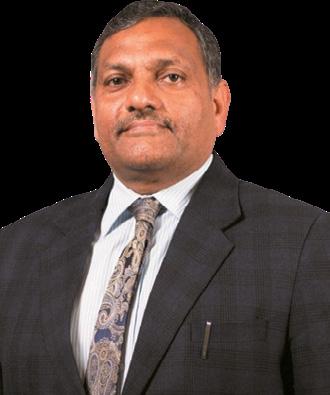
“As per our estimation, about 50 lakh people are engaged directly or indirectly in coal mining activities, especially in eastern Indian states. So, just transition has to cater to that challenge,” he said.
Meena said questions surrounding livelihoods of these 50 lakh people, alternate vocations, skulking, healthcare and education have to be considered while charting the way forward. He did not answer a question on what would be India’s specific agenda during the third meeting of the G-20 energy transitions working group, which began in the financial capital, or the consensus which the country is seeking to achieve. A query on the challenges he foresees from the delegates, especially nations pressing hard for more action from India to help limit the impact of climate change, was also not answered. He said India has identified 30 mines where the coal mining has been over and coal companies have started a 2-3 year exercise of closure. Apart from that, India is also putting the de-coaled land to environmental friendly use, which may include creating forests by putting fly ash or using it for agricultural purposes, Meena said. The country needs coal to help achieve the economic growth targets, and the government is also pushing forward with the agenda of higher private sector involvement in the coal mining, he said. The aim is to get up to a fourth of the overall coal extracted by private enterprises by 2030, Meena said, adding that response from the private sector for the seventh round of coal mine auctions has been “encouraging”.
So far, 87 mines have been allotted to private sector companies since 2020 in six rounds of auction, and the target is to have private installed capacity of 500 million tonnes at peak rate capacity, Meena said, adding that it takes up to four years for a mine to start production after it is allotted. Meena said four of the 87 mines have already started production, and a majority of the rest will start production by FY25. He said the country is targeting an increase in overall coal production to 1,012 million tonnes in FY24, up from the 892 million tonnes in FY23. The coal production will keep climbing up and hit a peak in 2040, after which it will plateau as the country will start relying more on renewable sources, he said. When asked about the impact of the power ministry’s plan to not add any new thermal power plant beyond the ones which are already under construction, Meena said “we now have the capacity to supply adequate coal to the power plants”. At present, the coal ministry is also focused on ensuring that wherever possible, “we can reduce the coal imports” and within two years, the “substitutable” one will be done. However, India will continue to import coking coal used in steel plants because there is no local production of it at all, he added.
www.EQMagPro.com 41 EQ MAY 2023 INDIA
Source: PTI
INDIA EYES CLEAN ENERGY SOURCES TO TACKLE TARIFFS
The government is considering revising its industrial electrification strategy to prioritize adopting cleaner energy sources, such as green hydrogen and battery storage, over fossil fuels amid the need to meet net-zero targets and the potential imposition of taxes on products based on their carbon emissions by developed nations.
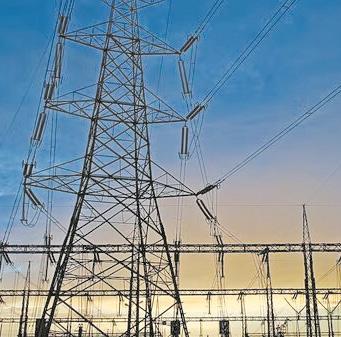
The government plans to develop a longterm strategy to transition industries that use fossil fuels to cleaner energy sources. The move comes as the steel and aluminium sectors, which predominantly use gas and captive coal-based power plants, will need to shift to cleaner fuels like green hydrogen to align with India’s net-zero goals and global mandates like the European Union’s Carbon Border Adjustment Mechanism (CBAM).
“The strategy is being looked at, as round-the-clock reliable power cannot be assured for all the industries, and industries like steel need 24/7 power. Further, even if they get connected to the grid, most of the supply would be through coal-based power, and only some of it would be through solar, which does not help these businesses on the decarbonization front. When storage comes up, they will be able to take it from open access, but storage cost would come down only gradually,” said one of the people aware of the developments.
The focus on electrification may now be further narrowed down to renewable energy. Given the increasing investments in green hydrogen, industries will be provided with more alternatives to transition away from using fossil fuels, another person aware of the development said. “Green hydrogen would be a different play; both electrification and hydrogen would be competitive with each other,” said the second person. The government is also considering establishing a timeline to transition to cleaner fuels to avoid business disruptions. “Industries have just recovered from the pandemic’s effect. Therefore, there is no intention to cause a disruption,” the person added.
Iron and steel consume the highest amount of electricity at 24% of the total industrial electricity consumption in India, followed by chemical and petrochemical (17%), non-metallic minerals (9%), and other industries (48%), according to data from the ministry of statistics and programme implementation (Mospi). The MSME sector has a high penetration of electrification, with approximately 76% of the energy demand. The consumption of electricity by the industry sector has doubled in the past decade. Mospi data showed that consumption of electricity by the industrial sector rose to 5,51,362 GWh in 2019-20 from 2,72,589 GWh in 2010-11. In 2020, the Indian manufacturing sector’s primary sources of energy was coal (29%), followed by oil (20%), electricity (22%), natural gas (19%), renewables (6%) and heat (4%), data from International Energy Agency shows. The review of the strategy is significant given that Indian producers of carbon-intensive products such as steel are expected to be heavily impacted by the EU’s proposed carbon tariffs. India is also likely to counter the EU’s carbon tariff as well as prepare the domestic industry to conform with the new mechanism that comes into force in its transitional phase on 1 October. The permanent system will take effect in 2026.
A person familiar with the development said that India is in talks with Europe to recognize carbon trading certificates that companies in the country would get under the newly planned carbon market.

Energy transition is key for steel companies both from the domestic and international perspectives. Along with working in tandem with India’s net zero target, they would also need to move towards greener options due to European Union’s Carbon Border Adjustment Mechanism (CBAM). The emission of carbon dioxide per tonne of steel produced in India is higher than in several other countries. So, Indian steel companies, given their significant exports to Europe, may be among the affected players due to CBAM, said Jayanta Roy, group head of corporate sector ratings at ICRA Ltd.
Indian companies need to cope with the energy transition requirements as other developed countries and blocs might also follow the EU’s path and come up with similar tariffs on carbon-intensive products, he said. Queries sent to the spokespeople for the ministries of power and commerce remained unanswered.

42 EQ MAY 2023 www.EQMagPro.com INDIA
Source: livemint
CHANDIGARH: FREE INSTALLATION OF ROOFTOP SOLAR PLANTS TO BEGIN IN JUNE
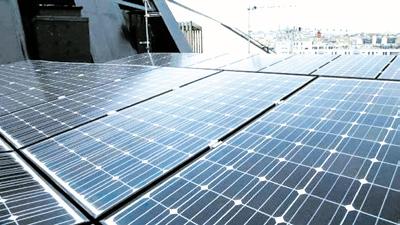
HThe Chandigarh administration, in May 2016, had made installation of rooftop solar plants mandatory in residential units measuring 500 square yards and above, and group housing societies aving received around 1,100 applications for free installation of rooftop solar plants, the Chandigarh Renewable Energy Science and Technology Promotion Society (CREST) is planning to launch the work from June 15. In January, the Joint Electricity Regulatory Commission had allowed installation of grid connected rooftop solar systems in Chandigarh under the Renewable Energy Service Company (RESCO) model. As part of the model, a private firm will be responsible for developing, installing, financing and operating the rooftop solar power plant for a limited build-operate-transfer (BOT) period, mostly likely for 15 years. During this period, the homeowner will be entitled to electricity at a uniform rate of ₹3.23 per unit and on the period’s completion, the plant’s ownership will be handed over to the consumer without any further charges. As the system’s expected life is nearly 25 years, the beneficiary will enjoy free solar power for nearly 10 years. At present, domestic consumers pay ₹2.75 per unit for 0-151 units, ₹4.25 per unit for 151400 units and ₹4.65 per unit for over 400 units.
Tenders have already been floated and installations are expected to begin from June 15. Before installation, a quadripartite agreement will be signed between the consumer, Chandigarh electricity department, CREST and RESCO, said Sukhwinder Singh Abrol, project director, CREST, the executing agency for city’s renewable energy projects.

He said residents can still apply for the solar plants at www.solar.chd.gov.in. The UT administration, in May 2016, had made installation of rooftop solar plants mandatory in residential units measuring 500 square yards and above, and group housing societies. However, despite the provision of 30% subsidy (before April 2023), over six years later, only 3,125 of the total 7,200 eligible houses opted for the plants. The cost to get a 1 kWp plant installed was ₹60,000, but with subsidy, it came down to ₹42,000. Meanwhile, several residents who did switch to solar power after footing the ₹42,000 installation cost, complain that they have not received any subsidy from the administration. Notably, the Union ministry of new and renewable energy had enhanced the city’s solar power generation target from 69 MWp (mega watt peak) to be achieved by 2022 to 75MWp to be met by August 15, 2023. UT has, so far, achieved generation of around 55MWp and aims to meet the final target by August with the installation of rooftop solar plants for domestic consumers.
Source: PTI
ODISHA APPROVES 11 PROJECTS WORTH RS 2,841 CR
TThe Odisha government has approved 11 projects with a total investment outlay of Rs 2,841 crore, a senior official said. he projects, which will be set up in Bolangir, Ganjam, Jagatsinghpur, Khurda, Mayurbhanj, Rayagada, Sambalpur and Sundargarh districts, are expected to generate employment for 3,721 people. Chief Secretary P K Jena said the approval was accorded during the State Level Single Window Clearance Authority (SLSWCA) meeting held. Of the 11 projects, nine were proposed by firms which attended the Make in Odisha conclave in December last year. The projects range from aluminium to steel, chemicals, plastics, food processing and packaging, textiles and apparel, tourism and renewable energy, another official said. The approved projects include an Rs 896.98 crore steel plant of the RCR Steel Works Private Limited to be set up at Jamda in Mayurbhanj district. It is expected to generate employment for 750 people.
The committee also approved the proposal for expansion of the Utkal Alumina International Limited in Rayagada district and Hindalco Industries Limited at Lapanga in Sambalpur. Investment of nearly Rs 1,000 crore and generation of employment for 500 people are expected in these projects.
The SLSWCA also approved the project proposal of Mahindra Holidays and Resorts India Limited, which will set up a resort at Somolo Island of Chilika Lake in Ganjam district for Rs 228.45 crore. The committee approved a project of Ion Exchange (India) Limited to set up a manufacturing unit in Paradip with an investment of Rs 303 crore. It will generate employment for 150 people. The Indian Stitches Private Limited will set up a fabric processing plant at Rs 100 crore. The project is expected to generate employment for 1,000 people.

www.EQMagPro.com 43 EQ MAY 2023 INDIA
Source: PTI
HPL ELECTRIC AND POWER LTD SECURES INR 204 CRORE SMART METER ORDERS
Leading Indian electric equipment manufacturer HPL Electric and Power Ltd. (HPL) declared that it has received smart meter orders worth INR 204 crore from clients with a presence across the country. The company has been operating and providing at an increased pace in alignment with the roll-out of government-led programs for smart metering thanks to a strong pipeline of pending orders.
ith a discernible increase in demand, the company’s strategic focus on the smart meter industry is showing promise. The actions of the government and the widespread use of smart metering technologies are to blame for this success. At this time, the company’s order book totals more than Rs. 1250 crore. An important competitive edge over its competitors in gaining these contracts was HPL Electric and Power Ltd.’s dedication to R&D and significant investments in it. An order book that is rapidly expanding is a testament to the company’s ongoing efforts to improve product innovation and technological breakthroughs. With a solid R&D base, HPL is well-positioned to meet the changing demands of the industry and spur additional growth. HPL Electric & Power Ltd. has been carefully enhancing its operational effectiveness and infrastructure in line with its strategy for modernization and process automation. The company has increased productivity levels while decreasing reliance on manual labor by utilizing cutting-edge technologies and automating crucial procedures. Through this modernization-focused approach, operations are streamlined, cost-effectiveness is increased, and customer satisfaction is raised. The robust demand for smart meters and our dedication to technical excellence are the main drivers of our continued growth, said Mr. Gautam Seth, Joint Managing Director of HPL Electric and Power Ltd. “The adoption of government initiatives has greatly benefited the sector, and we are seeing real benefits. We are well-positioned for sustainable growth and ongoing market leadership thanks to our significant backlog of pending orders, together with our R&D and process automation activities.
HPL is still committed to offering cuttingedge, superior smart meter solutions and actively participating in power industry modernization initiatives. With an emphasis on effectiveness, dependability, and customer happiness, the company is well-positioned to seize new possibilities and solidify its leadership position within India’s smart metering revolution. In India, HPL is a wellknown manufacturer of electrical equipment, producing a wide range of products for the consumer and institutional markets, including metering solutions, switchgear, lighting equipment, and wires and cables. During the same year, HPL had the largest market share in the Indian market for electricity energy meters, one of the most complete portfolios of meters in India, and the fifth largest market share for LED lamps. The vast sales and distribution network of HPL, which is present throughout India, supports its industrial capabilities. Under the umbrella trademark “HPL,” which has been registered in India since 1975, HPL today manufactures and markets its goods.
Source: PTI
GREEN HYDROGEN: LAND POLICY FRAMED IN GUJARAT
The state revenue department has announced its policy for allotting government wasteland to companies that intend to produce green hydrogen – hydrogen which is produced using renewable energy (RE).
The state will also extend to them all the benefits being accorded to other renewable energy (RE) projects such as wind, solar and wind-solar hybrid. The Gujarat government has already signed MoUs with five top corporate entities for allotment of sizable pieces of government wasteland for upcoming green hydrogen projects. Government wasteland will be leased to such companies for a period of 40 years. They will have to pay an annual rent of Rs 15,000 per hectare with a 15% increase every three years. Other conditions stipulated are that these companies will need to complete lease agreement procedures within six months of approval, and 50% of their green hydrogen production capacity must be reached within five years of commissioning the plant and 100% within eight years.
Companies that apply for green hydrogen projects will get “deemed NA status”, meaning they will not have to convert the land purpose from agricultural to non agriculture. Land allotted for these projects cannot be used for any other purpose. The government resolution states that tripartite agreements will be filed while setting up green hydrogen projects between the developer, the collectorate concerned and Gujarat Power Corporation Ltd (GPCL), which is the nodal agency for implementing green hydrogen projects in the state. The government also listed qualifications for companies to apply for land for such projects. They should have generated at least 1 lakh metric tonnes of green hydrogen. They must have prior experience of producing at least 500MW of renewable energy or should be a user of brown, grey or blue hydrogen.
“All policy incentives for other RE projects will be extended to these companies. The state aims to take the lead in green hydrogen production in the country and conducive policies are being chalked out,” said a government official. The Centre had earlier announced that under the Intended Nationally Determined Contributions (INDT), India aims to be a net-zero emissions country by 2070. India has also undertaken to reduce its carbon emissions by 45% by 2030, by sourcing 50% of its energy from renewable sources.
Source: PTI
44 EQ MAY 2023 www.EQMagPro.com
INDIA
W
PEAK POWER DEMAND HITS HISTORIC HIGH OF 220 GW, MAY CROSS THAT LEVEL SOON

AFigure is in sync with power ministry’s estimate that demand would top 220 Gw in Apr-June quarter t around 3 pm, India’s daily peak power demand touched 220 gigawatts (Gw)–the highest daily peak ever in the history of the country. The ministry of power in its estimates had projected country’s power demand to cross touch 220 Gw during the months of AprilJune. With a cooler April due to unseasonal rains, the peak shifted to May. As temperatures soar across the country, it is expected, the peak demand is likely to cross the 220 Gw mark as well, unless the monsoon sets in early or pre-monsoon showers give a respite. The Centre had made projections for the coal demand scenario and grid preparedness keeping in mind the 220 Gw peak this summer. According to government data, the total coal requirement to run the historic high power demand will be 222 million tonnes (MT) during April-June 2023 as thermal power will drive the supply.
The likely availability of domestic coal was expected to be around 201 MT by the Ministry of Power earlier this year as against demand of 222 MT. This shortfall is translating to a 100,000- 300,000-tonne daily deficit in the supply of domestic coal. Considering the same, the ministry of power in January this year directed all power generating companies (gencos) to mandatorily import coal up to 6 per cent of their total requirement. Close to 6 states, and Central PSU NTPC Ltd have already placed imported coal tenders. But thanks to the respite during April, domestic coal build up is healthy. The current daily (average) stock at the thermal units stands at 32 MT (including both domestic and imported). This translates to 13 days of coal stock at the end of the power units. Country’s largest power generator NTPC has a coal stock of 12-15 days currently, said an executive.
COAL RUNS THE SHOW
Data pertains to 17 of the May for every year
Data is the peak power demand for that date – the highest demand during the day
Source: Grid India (As on May 16th)
www.EQMagPro.com 45 EQ MAY 2023 INDIA
MAXIMUM PEAK POWER DEMAND MET DURING THE DAY May-17 In Gw 2023 220 (At 3PM) 2022 201 2021 153 2020 146 2019 174 2018 158 2017 151 Source: Grid
India
SOURCE-WISE
ENERGY SUPPLY In % Coal 73 Lignite 2 Hydro 8 Nuclear 2 Gas, Naptha, Diesel 2 RES* 14 RES = Solar, Wind, Biomass & Others
CONTRIBUTION TO TOTAL
UNION POWER & NRE MINISTER SHRI R. K. SINGH LAYS FOUNDATION




STONE FOR AUGMENTATION OF POWERGRID’S ARA SUB-STATION
Augmentation of Sub-Station to ensure uninterrupted power supply and give boost to economic and social development of the region through a strong power infrastructure: Shri R. K. Singh
Shri R. K. Singh, Hon’ble Union Minister of Power, New and Renewable Energy, laid the foundation stone for augmentation of 220/132 kV POWERGRID Ara Substation. Shri Bijendra Prasad Yadav, Hon’ble Energy Minister, Bihar, Shri Amrendra Pratap Singh, Hon’ble MLA, Ara, Shri Raghavendra Pratap Singh, Hon’ble MLA, Barhara, Smt. Kiran Devi, Hon’ble MLA, Sandesh, Mr. Awadhesh Narayan Singh, Hon’ble Member, Bihar Legislative Council, Smt. Indu Devi, Mayor, Ara, Smt. Poonam Devi, Deputy Mayor, Ara, Chairman and Managing Director of POWERGRID Shri K. Sreekant and senior government officials were present on the occasion.The augmentation of POWERGRID Ara sub-station will increase the total transformation capacity of the sub-station to 560 MVA.
Speaking on the occasion, Shri R. K. Singh said that the initiative will speed up the pace of development in Ara, and give boost to economic and social development of the region through a strong power infrastructure. “This initiative would facilitate meeting demand of electricity for the next 10 years in Ara. Uninterrupted power supply will lead to industrial and commercial development of the area and also improve power availability in Bhojpur, Buxar and Rohtas districts. It will further strengthen Ara’s connectivity with the national grid,” Shri Singh added.
Various works of rural development such as bathing ghat, PCC road, community hall, culvert, boundary wall, retaining wall etc. have been undertaken by POWERGRID under Corporate Social Responsibility in Bhojpur. Arrangement of bench desk in schools, high mast light and construction of toilets etc. have also been done under CSR. Apart from the core business of power transmission, POWERGRID, a Maharatna PSU of the Government of India, is playing a leading role in impacting lives through multifarious social development initiatives under the slogan of “POWERGRID – Transmitting Power, Transforming Lives”.
JK TO PUSH SOLAR ENERGY TO CUT CONSUMERS’ ELECTRICITY BILLS
Jammu and Kashmir Energy Development Agency (JAKEDA) has launched a new scheme under which consumers can reduce their electricity bills and bank their surplus energy if they install solar power plants in their homes.
We have a 20-Megawatt ‘Roof Top Solar Power Plant’ project for Jammu and Kashmir. In this scheme we are trying to cover 10,000 households, where we set up a power plant of three, five or ten-kilowatt capacity that will curtail the electricity bills of the consumers, JAKEDA Chief Executive Officer Prithvi Raj Dhar told PTI. Dhar, who inaugurated a solar power expo here, said with the installation of smart meters, which are bidirectional, the energy generated from the solar panels installed at the premises of consumers will be transferred to the grid. “The number of units generated by the solar plant will be deducted from the number of units consumed by the consumer,” he added.

“It means the cost of installing the plant will be recovered in three years and the consumer will get free energy for the rest of his life. It is also clean energy. Installing one KW solar power plant is equivalent to planting 66 trees per year. This will greatly reduce carbon emissions,” Dhar said. JAKEDA Assistant Executive Engineer Khalid Raja said in the case of consumers using less energy than what is generated by their plant, the excess energy will be banked in their account for later use.
“The government is providing subsidies on setting up the power plant which is up to 65 per cent of project cost. The consumer has to provide only 35 per cent,” he added. Afshan Reshi, a visitor at the expo, was upbeat about the new scheme. “There are a lot of benefits. It will reduce the electricity bills. Right now there is a good amount of subsidy on it. It may be reduced later or waived later,” Reshi said. JAKEDA has invited several companies which manufacture and market solar technologies to the expo so that the visitors can choose from a wide range of products.
46 EQ MAY 2023 www.EQMagPro.com INDIA
US INVESTOR VANGUARD MARKS DOWN OLA’S VALUATION BY 35% TO $4.8 BILLION
Vanguard reportedly has about 0.7 per cent stake in the ride-hailing firm. US-based investment management firm Vanguard Group has marked down the valuation of ANI Technologies, the parent company of ride-hailing firm Ola, by about 35 per cent to $4.8 billion from $7.4 billion, according to a filing.
The value of Ola’s shares held by Vanguard Group funds fell to around $203.78 as of February 28, 2023, from $311.85 in August 31, 2022. This is according to regulatory filings with the US’ Securities and Exchange Commission (SEC). Vanguard reportedly has about 0.7 per cent stake in the ride-hailing firm. In December 2021, the mobility platform raised about $139 million from a few investors, including IIFL, Edelweiss, and Sunil Munjal-led Hero Enterprise. This is according to regulatory documents sourced from business intelligence platform Tofler. Bhavish Aggarwal-led Ola had been valued at about $7.3 billion that time. The company declined to comment on its valuation being slashed by Vanguard. This is not the first time Vanguard has marked down the valuation of the Bengaluru-based firm. In 2017, Vanguard marked down Ola’s valuation by 40 per cent. This indicated a valuation of about $3 billion, down from the company’s $5 billion when it last raised $500 million in November 2015. Vanguard later marked up the valuation in subsequent months. The firm reportedly cut the value of its investment by 45 per cent between December 2019 and June 2020 and 9.5 per cent in 2021, reducing Ola’s valuation from over $6 billion to around $3 billion.

The new markdown comes at a time when Ola shut its in-cab infotainment service on November 15 last year. Last year, the company shut down its used vehicles business Ola Cars and its quick-commerce unit Ola Dash, which promised 10-minute food delivery. It repurposed the infrastructure and capabilities of Ola Cars business towards boosting the Ola Electric sales and service network. The company shut down Ola Cars within a year of its launch as it shifted focus to its electric two-wheeler and car verticals. Ola has so far shut down Ola Cafe, Food Panda, Ola Foods, and Ola Dash. Last year, the SoftBank-backed mobility platform laid off 400-500 employees in a move aimed at driving cost efficiency, according to the sources. Ola has raised a total funding of $5 billion from investors including SoftBank, Tiger Global, Sequoia Capital and Accel. Ola reported its first operating profit of Rs 89.82 crore for 2020-21, even as its revenue declined 65 per cent to Rs 689.61 crore amid Covid-induced lockdowns. ANI Technologies had reported a standalone operating profit (profit before finance cost, depreciation, amortisation and tax or EBITDA) of Rs 89.82 crore in FY21 on a standalone basis. It had registered a loss of Rs 610.18 crore in the previous financial year, according to the regulatory documents of Tofler.
Ola is among an increasing number of tech companies facing valuation mark downs. This is because it is witnessing steep losses and laying off employees amid a funding winter and macroeconomic uncertainties. US investment firm Invesco, which led Swiggy’s previous funding round, has marked down the food delivery firm’s valuation by 33 per cent from $8.2 billion to about $5.5 billion. In January last year, Swiggy raised $700 million in Invesco-led funding, which made the outfit a decacorn, almost doubling its valuation to $10.7 billion. USbased asset manager BlackRock has reportedly reduced the valuation of Byju’s by about 50 per cent to $11.5 billion. This is a sharp decrease from the $22 billion at which the edtech decacorn was valued at in 2022.
Source: PTI

www.EQMagPro.com 47 EQ MAY 2023
BUSINESS & FINANCE
MG MOTOR EXPECTS 30% OF SALES TO COME FROM EVS THIS YEAR; GEARS UP TO DRIVE IN ELECTRIC HATCH COMET
The company broke even in March, and expects EVs to comprise 30 percent of its total sales volumes. hile previewing its electric car Comet, MG Motor India revealed that it has invested around Rs 800 crore to produce the car locally at its plant in Halol, Gujarat. The company anticipates a strong response and will be gradually ramping up the production of this two-door electric car to around 3,000 units a month. With the Comet due to roll out in the coming days, this will be the second electric vehicle (EV) by the British carmaker after the ZS EV, which was launched in India in 2020. Rajeev Chaba, MG Motor India President and MD, during a round table interaction with reporters, claimed that the Comet has a range of 230 kms on a single charge and is well suited for intra-city ‘practical’ usage. In his view, the cost of ownership is going to be very economical.


If you are driving 1,000 kms a month, then you need to charge the car just five times. A single charge can do about 200 kms. Assuming that the electricity cost is Rs 6 per unit, you just need to spend Rs 500 for 1,000 kms a month. It means the cost of running this car is less than a pizza, or a PVR ticket, or two cups of coffee, emphasised Chaba. He also stated, “As per our survey, people spend Rs 5,000 a month for petrol. In addition to that, maintenance costs are also huge.”
During the product unveil, MG Motor India announced that the Comet will be equipped with a 17.3 KWH li-ion battery and can be fully charged in around seven hours. While the product’s price points were not disclosed, it is expected to be in the Rs 10-12 lakh range (ex-showroom). It will be equipped with automatic transmission, two front airbags, and reverse parking camera, among other things. Chaba that the company would not be catering to buyers who do a lot of inter-city trips, and nor will it be looking at fleet operators. “We will start taking bookings for the Comet from May 15. We are going to be very serious about not selling this car to certain categories of people. Nor are we going to reach out to fleet operators just to push volumes,” Chaba said. As reported by Autocar Professional, in order to cater to the anticipated demand for the Comet, MG Motor India will be adding a third shift at its existing plant to expand capacity to 1,20,000 units per annum. The content localisation will be about around 54 percent in the initial phase, and will be enhanced to 60 percent by the end of this year. The company has partnered with Tata AutoComp Systems (TACO) to source batteries for the car. As it gears up to introduce the Comet next month, MG Motor India says it expects 30 percent of its sales to come from the EV segment this fiscal year.
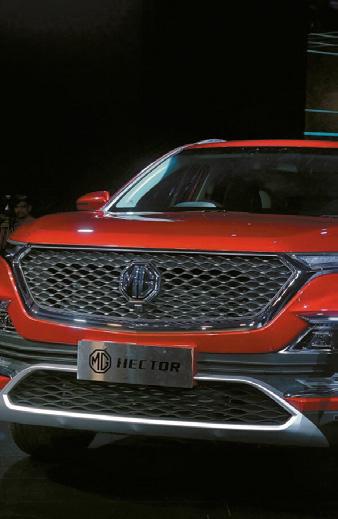
“The sale of electric passenger vehicles is set to rise dramatically in India, from around 50,000 units last year to probably around 125,000-130,000 units this year. During 2023, we expect 30 percent of our total sales of around 80,000-90,000 units to come from the two electric models,” Chaba said, adding, “If we are fortunate, we could produce between 80,000 to 1 lakh units this year and next year our output should be 1.2 lakh units.” Chaba also said that the company broke even this March. “We broke even in March and we should be able to make a little money this year if we are able to sell 80,000 to 1 lakh units.” Citing global trends, he noted that electric and plug-in hybrid vehicle sales now accounted for 30 per cent of the overall new sales in China. Similarly, EVs account for 20 percent of sales in Europe and 10 percent of the US market, Chaba said. “In India, EVs are less than 2 percent but this number will go up. For India, the tipping point would be when the penetration levels reach 10 per cent and there are more choices for consumers around the Rs 10 lakh price range,” he explained.
Source: PTI
48 EQ MAY 2023 www.EQMagPro.com BUSINESS & FINANCE
W
MAHINDRA LAST MILE MOBILITY HOLDS GROUND-BREAKING CEREMONY OF EV FACILITY IN TELANGANA
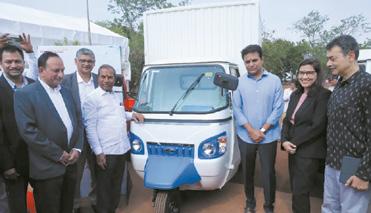
Mahindra Last Mile Mobility (LMM), a part of Mahindra & Mahindra (M&M), held a ground-breaking ceremony for a new manufacturing unit at its existing plant here. Telangana Minister for Industries K T Rama Rao was the chief guest, a press release from the automaker said. The initiative is pursuant to the announcement of the Rs 1,000 crore investment in Telangana that M&M made in February this year. With this new facility, the company aims to build a state-of-the-art battery assembly line, producing power packs and manufacture electronic as well as drivetrain components for electric 3 and 4-wheelers, it said. The facility would also create employment for 800 to 1,000 employees in the region. Rama Rao, said EVs are a focus area for the Telangana Government which is committed to develop the right infrastructure and ecosystem for promotion and adoption of electric vehicles.
This new facility will help in proliferation of EVs not just in Telangana but across India. Congratulations to M&M for the ground-breaking of their new facility. I am sure that this facility will go a long way in generating employment and sustaining livelihoods, the Minister said.
Suman Mishra, CEO, Mahindra Last Mile Mobility said, “Mahindra Last Mile Mobility is at the forefront of India’s 3-wheeler electrification journey. I would like to thank the Government of Telangana for their proactiveness and ease of doing business policies under which Zaheerabad has been developed into one of the four mega EV manufacturing clusters. This facility will allow us to access state-of-the-art infrastructure available in the region.
INDIA EXPLORES POWER LINKS WITH SAUDI ARABIA, UAE

Talks are also on with Singapore to connect grids through undersea cable.Once ready, this could cut the need for costly clean energy storage
India is considering linking its power grid to those of Saudi Arabia and the United Arab Emirates through undersea cables, with India’s power ministry circulating Cabinet notes for inter-ministerial consultation to initiate the process to expand access to reliable power and enhance the country’s energy security.
Further, India is also in talks with Singapore to link the city state with its power grid via an undersea cable link, Raj Kumar Singh, Union minister for power and new and renewable energy, said in an interview.



Once approved by the Union cabinet, bilateral agreements will be signed with Saudi Arabia and the UAE for the mega projects, which will be bid out after detailed project reports are created, Singh said, adding that the countries will assess the viability of each project before proceeding.
Source: livemint
www.EQMagPro.com 49 EQ MAY 2023 BUSINESS & FINANCE
Telangana Minister for Industries K T Rama Rao was the chief guest, a press release from the automaker said
PTC INDIA INKS PACT WITH BROOKFIELD RENEWABLES TO PURCHASE 100 MW SOLAR POWER
“PTC India has executed a Memorandum of Understanding (MoU) with Brookfield Renewables for purchase of 100 MW solar power on a long-term basis.”
Power trading solutions provider PTC India said it has signed an agreement with Brookfield Renewables for purchase of 100 MW solar power on a long term basis. Brookfield Renewables is developing a 400 MW solar power project in Bikaner solar park in Rajasthan. “PTC India has executed a Memorandum of Understanding (MoU) with Brookfield Renewables for purchase of 100 MW solar power on a long-term basis,” PTC India said in a release. The agreement includes an option to increase the power capacity to 200 MW at the time of project commissioning based on mutual confirmation by the two parties. PTC India will market the power to various utilities and commercial and industrial consumers.
Under this arrangement, PTC India will provide Brookfield Renewables with an assured tariff and payment security. “This structure, executed with Brookfield is the first of its kind in the Indian power market… We will scale this structure and replicate it in multiple transactions going forward,” PTC India CMD Rajib K Mishra said.

IIT KANPUR & INDIAN ARMY COLLABORATE TO PURSUE CARBON NEUTRALITY

The move is aimed towards supporting India’s goal of achieving net-zero emissions by 2070.
In yet another green initiative the Indian Army is now set to work towards achieving carbon neutrality in several cantonment campuses. Owing to this, the Military Engineer Services (MES) Jhansi has now signed an MoU with IIT Kanpur to achieve the zero-emission target. The move is aimed towards supporting India’s goal of achieving net-zero emissions by 2070. As part of this MoU, the institute will conduct annual sustainability audits for MES Jhansi cantonment campuses. These audits will help identify areas for improvement and develop strategies to reduce the carbon footprint of the campuses.
IIT-K to train army personnel for promoting sustainable practicies. The MoU was signed recently by Col. Akhil Singh Charak, Commander Works Engineer (CWE) and IIT-K alumnus and Prof. AR Harish, Dean of R&D, IIT Kanpur. As part of a collaboration, 5 of the MES Jhansi campuses have been targeted where work will be done towards achieving net zero carbon emissions, net zero energy consumption, net zero water usage and net zero waste production in a phased manner. In addition, IIT Kanpur will provide training to Army personnel and establish a resource pool for them through on-the-job training aimed at promoting sustainable practices.
By this initiative, the Indian army will establish a demonstrable model through a real-world example of achieving carbon neutrality, reducing greenhouse gas emissions and transitioning to a more sustainable future.
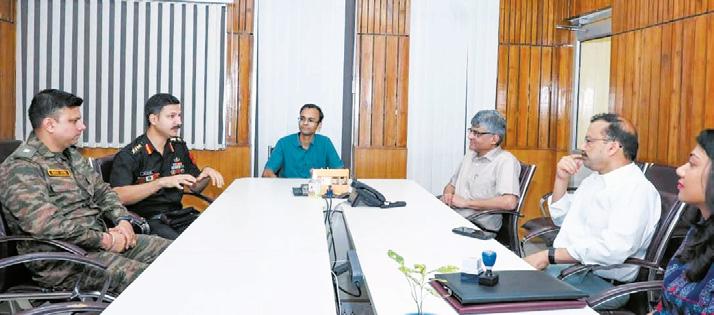
50 EQ MAY 2023 www.EQMagPro.com BUSINESS & FINANCE
Source: PTI Source: PTI
GAIL PLANS $4.9 BILLION ETHANE CRACKER IN WEST INDIA: SOURCES
Indian companies are boosting their petrochemical production capacity as the expanding economy boosts the need for goods ranging from plastics to paints and adhesives. A cracker produces ethylene, required for products such as plastics.
G
AIL (India) Ltd, the country’s top gas supplier, plans to build a 400-billion rupee ($4.89 billion) ethane cracker near its liquefied natural gas (LNG) import plant in Western India, two sources with direct knowledge of the matter said, as it seeks to meet an expected surge in demand. Indian companies are boosting their petrochemical production capacity as the expanding economy boosts the need for goods ranging from plastics to paints and adhesives. A cracker produces ethylene, required for products such as plastics. Demand for petrochemicals could nearly triple by 2040, according to estimates by top refiner Indian Oil, forcing companies to make big investments to set up new facilities across the country. GAIL is looking for land in the coastal region of Dabhol in Maharashtra state for the 1.5 million tonnes a year (mtpa) cracker project, one of the sources told Reuters. GAIL operates a 5 mtpa LNG plant at Dabhol.
The company plans to import ethane from the United States for the project, the source said. GAIL’s communications office did not immediately respond to a request for comment. “We are trying to sort out challenges around acquiring land, most likely, in or around Dabhol … we are hoping to receive financial support from the state government,” the source said.
GAIL is also exploring the possibility to acquire land in Madhya Pradesh, which neighbours Maharashtra, if a deal in Dabhol doesn’t materialise, the person said. The proposed dual-feed cracker will also have capability to crack up to 40% liquefied petroleum gas (LPG), enabling the option to switch to less expensive feedstock to maximise margins.
India’s per capita petrochemical consumption is about onethird of the global average. Asia’s third-largest economy annually consumes 25 million to 30 million tonnes of petrochemicals.
Source: PTI
RISEN ENERGY WILL INVEST RMB 8.465 BILLION TO ESTABLISH INTEGRATED ENERGY BASE WITH 10GW PER YEAR OF CRYSTAL GROWING CAPACITY IN INNER MONGOLIA
Risen Energy announced in late April that it will be building an integrated energy base in the city of Baotou in China’s Inner Mongolia Region. The base will provide renewable generation, energy storage, and power distribution. Furthermore, it will also contain 10GW per year of production capacity for monocrystalline silicon crystals. The base will be funded step by step from sources pertaining to Risen’s own capacity expansion plans, investments related to downstream demand, and investments dedicated to this project. This announcement was first picked up by other Chinese renewable energy news websites.
Once completed, the base will have 705MW of wind power, 300MW of solar PV, and 275MW/1,100MWh of energy storage. Regarding the total investment in the base, Risen has set the amount at RMB 8.465 billion, of which around RMB 6.36 billion is allocated to the utility assets and around RMB 2.10 billon is allocated to the crystal growing facility. Two of Risen’s wholly-owned local subsidiaries will be developing this project. One will be focusing on building the utility assets, while the other one will be focusing building the crystal growing facility. Risen stated the new energy base will promote the formation of a local industry cluster for solar PV and support the company’s vertical integration efforts. Risen will be able to set up a crystal growing process that is powered by renewable energy and energy storage. This, in turn, will further enhance the company’s overall competitiveness and profitability. Moreover, having a “green manufacturing process” will enable the company to increase sales and capture more global market share. All in all, the project is in line with the company’s long-term growth strategy.
Source: energytrend
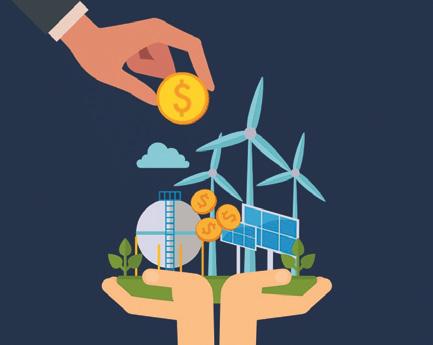
www.EQMagPro.com 51 EQ MAY 2023 BUSINESS & FINANCE
PFC APPROVES LOAN WORTH RS 633 CRORE FOR DEPLOYMENT OF 5000 EV CABS IN DELHI


To help make the Delhi-National Capital Region cleaner and greener, power sector lender PFC has sanctioned a loan worth Rs 633 crore to Gensol Engineering Ltd. The passenger EVs are being leased to BMPL to expand its fleet of ride-hailing cabs.

Blusmart Mobility Pvt Ltd (BMPL) on April 20 flagged off its first lot of electric ride-hailing cabs that were added to its fleet with the help of a loan worth Rs 633 crore sanctioned by Power Finance Corporation Ltd. To help make the Delhi-National Capital Region (NCR) cleaner and greener, power sector lender PFC has sanctioned a loan worth Rs 633 crore to Gensol Engineering Ltd (GEL) for the purchase of 5,000 passenger electric vehicles (EVs) and 1,000 cargo EVs. The first tranche of the loan has been disbursed and the first lot of EV cabs has hit the roads of Delhi. The passenger EVs are being leased to BMPL to expand its fleet of ridehailing cabs. Launched in 2019, BluSmart has the largest fleet of electric cabs and the largest network of EV fast charging stations across Delhi-NCR and Bengaluru. Touted to be the largest EV asset financing deal in India, the 5000 e4Ws funded by PFC would result in emission savings of over 1,00,000 tonnes of CO2 equivalent, the companies said in a release. This is equivalent to the amount of carbon dioxide absorbed by over five million fullygrown trees in a year.
Ravinder Singh Dhillon, CMD, PFC, said, “E-mobility adoption is going on at a fast pace in the country and we believe that there is a huge potential in this field. Through this funding, PFC has endeavoured to contribute towards India’s Nationally Determined Contributions (NDC) goals and this will go a long way for moving towards a healthy and sustainable mode of transport.”

The financing through PFC will help us deploy more EVs on the streets of our cities and help us continue to build on our vision to create a unique customer experience through electric mobility in India, said Anmol Singh Jaggi, CEO and Co-founder of BluSmart.

52 EQ MAY 2023 www.EQMagPro.com BUSINESS & FINANCE
Tata Power Delhi Distribution Limited (Tata Power-DDL), a pioneering power utility supplying electricity to a populace of over 7 million in North Delhi, won the Leadership in Energy and Environmental Design (LEED) Platinum Certification under the LEED v4.1 EBOM Rating System for its four major existing office buildings located in North Delhi – Corporate Office, NDPL House, Kingsway Camp; CENNET -Technology Centre, Pitampura; Centre for Customer Care (Cencare), Keshavpuram; and Smart Grid Lab, Rohini.
This is the highest rating given by the USGBC/ GBCI under the LEED certification system. Estate Management and Civil Department of Tata Power-DDL worked in coordination with different departments to earn the certification. The award certification was granted after a rigorous evaluation of the green building practices employed by the Discom, like energy efficiency, water conservation, sustainable practices, indoor environmental quality, and innovation in design. Tata Power-DDL transformed its four buildings by adopting multiple green building measures, including energy-efficient LED lighting, energy-efficient HVAC systems, efficient use of water, optimised use of natural resources, water conservation measures, and use of recycled and sustainable materials.
TATA POWER DELHI DISTRIBUTION LIMITED ACHIEVES LEED PLATINUM CERTIFICATION FOR FOUR MAJOR EXISTING OFFICE BUILDINGS BIJU PATNAIK AIRPORT INAUGURATES 4 MWP SOLAR PLANTS, SWITCHES TO RENEWABLE ENERGY
Speaking on the win, Mr. Subrata Das, Chief – Operations, Safety, Business Excellence (BE) & TQM at Tata Power Delhi Distribution Limited, said, “We are thrilled to receive LEED Platinum certification, which validates our ongoing efforts towards sustainability and environmental stewardship. At Tata Power Delhi Distribution Limited, we consciously make efforts to reduce our carbon footprint and promote sustainable practices, and this achievement is a testament to our commitment to the goal.”
LEED is a well-known program for green building design, construction, operation, and maintenance. The award of this certification is based on a rigorous evaluation of Tata Power-DDL’s green building practices used during the operation and maintenance of the above-mentioned buildings, such as energy efficiency, water conservation, use of sustainable materials, indoor environmental quality, and design innovation. Tata Power-DDL is committed to decreasing its environmental impact and fostering long-term growth. This accreditation demonstrates the company’s dedication to sustainability and its efforts to create a greener future.


The Biju Patnaik International Airport (BPIA), Bhubaneswar, has entirely switched to green sources for its energy consumption, making it one of India’s 100 per cent sustainable airports.
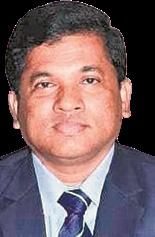
The airport has installed 4MWp Ground Mounted Solar Power Plant at Operational area that includes 10530 PV modules of 380W each over area of 13.28 Acres with a project cost of 18.75 Crore. The 4 MW Power plant was inaugurated by Bhubaneswar MP Aparajita Sarangi in presence of BPIA Director Prasanna Pradhan. Bhubaneswar airport produces around 60 per cent of the airport’s electricity requirement through its onsite solar generation and the rest 40 per cent from other green sources such as hydro energy. Ushering into a sustainable future, BPIA witnessed a rise in natural energy generation of 935963 KWH (Solar power generation) from December 2022 to April 2023 and total unit imported from grid for Airport consumption is 2719046 KWH, which is around 35 percent. and finally attained the 100 per cent utilization of renewable sources of energy in April 2023, The airport is committed to continuous reduction in energy consumption and carbon footprint through various initiatives. Moreover, BPIA initially undertook the measure of installing a 100KWp rooftop solar power plant since 28th August 2013, which the airport eventually strengthened to 4.1MW.BPIA which solely runs on green energy since April 2023, thus enabling a highly efficient and low-carbon future for aviation. This sustainable initiative undertaken by BPIA is part of the airport’s efforts that reduce its carbon footprint, which propels its journey towards ‘Net Zero’ emissions.
We are delighted to achieve this key milestone in our journey towards attaining a sustainable future for BPIA. The diligent efforts of the airport in undertaking several thoughtful initiatives have paved the way to achieve this feat. As BPIA aspires to become net-zero, this landmark event further encourages us to stay committed to enhancing the airport’s operational efficiency while operating on fully renewable energy, said BPIA Director Prasanna Pradhan.
At present, Bhubaneswar airport has certificate for Level 2 Carbon reduction awarded on 07.01.2020 and become eligible for achieving Level-3 Carbon Emission reduction.
Source: PTI
www.EQMagPro.com 53 EQ MAY 2023 FEATURED
VIBRANT ENERGY APPOINTS ANIRBAN DAS AS CHIEF INVESTMENT OFFICER


RAnirban, an MBA from IIM Ahmedabad, brings with him a rich experience of more than USD 2.5 billion of infrastructure debt funding in India enewable energy solutions provider Vibrant Energy announced the appointment of Anirban Das as its Chief Investment Officer. Vibrant Energy has announced the appointment of Anirban Das as the Chief Investment Officer (CIO) of the company, a statement said. Vibrant Energy is a portfolio company of Macquarie Asset Management’s Green Investment Group (MAM-GIG) with a mission to lead the decarbonisation initiatives for corporate renewable energy customers and help them to attain a more sustainable, resilient, and low-cost energy future.
NAVITAS SOLAR TO EXPAND



In this role, Anirban will work closely with Srinivasan Viswanathan, CEO, leading all fund raising and investment activities across the capital stack for Vibrant, it stated. Anirban, an MBA from IIM Ahmedabad, brings with him a rich experience of more than USD 2.5 billion of infrastructure debt funding in India. Headquartered in Singapore and Hyderabad, Vibrant is operating and delivering more than 2GW of renewable energy solutions for corporates. It aims to reach Green Energy asset base of about 5 GW in the medium term.
MANUFACTURING CAPACITY
Solar module manufacturing company Navitas Green Solutions (Navitas Solar) is planning to expand manufacturing capacity by another 1.2 gigawatt per annum from 500 megawatt per annum at present. The Surat-based company said that it has raised USD 5 million (about 41 crore) at an undisclosed valuation.
We are thrilled by the successful completion of our funding round as we embark on the next phase of growth. The faith shown by the investors upon us is a vindication of the strong foundation we have laid for Navitas Solar in the last ten years, said Vineet Mittal, Director & Co-Founder, Navitas Solar.
The funding will allow us to expand our manufacturing capacities and meet the growing demand for solar power projects, he told reporters here. A group of HNI investors participated in the funding round. Lead investors include promoters of Parishi Diamond Group, Lemon Emerging Ventures LLP and others, the company said in a statement. “The funds will be used for expanding manufacturing capacity by another 1.2 GW p.a. At present the manufacturing capacity is 500 MW per annum,” Mittal said.
The company is also planning to export its products to countries like the US, EU and Africa.
Navitas is the perfect partner for our investment in renewable energy. The team has proven itself and we are excited to partner with them in their next phase of growth. As socially conscious investors we are glad to participate in our Prime Minister’s vision for becoming a Net zero country by 2070, said Aaryan Shah from Parishi Diamond Group.
Source: PTI
54 EQ MAY 2023 www.EQMagPro.com FEATURED
Navitas Solar was ranked among the top 10 solar panel manufacturers by JMK Research and Analytics, it said in the release.
SUZHOU MEDICALSYSTEM BEGINS EQUIPMENT INSTALLATION AT ITS NEW SMART FACTORY FOR MANUFACTURING TOPCON CELLS
Suzhou MedicalSystem Technology announced that it had begun installing equipment at its new smart factory for PV cells in Mianyang, a city in China’s Sichuan Province. The investment for the factory amounts to RMB 10.2 billion. The equipment being installed is intended for manufacturing N-type TOPCon cells, indicating the company’s chosen technology path. Once all the necessary equipment is deployed, the factory will begin production. This announcement was first picked up by other Chinese news outlets.
S Buzhou MedicalSystem’s main business is the design and marketing of clinical informatics systems and digital hospital solutions. However, earlier this year, the company announced its entry into the solar PV industry with plans to build a factory in Mianyang for manufacturing highefficiency PV cells. Xinhao New Energy, a wholly-owned and listed subsidiary of Suzhou MedicalSystem, is in charge of the factory’s investment and construction.
Four production lines at the factory site are scheduled to finish equipment installation on May 15, with the first production line commencing calibration and initial production shortly after. Around the same time, the remaining production lines at the factory site will undergo equipment installation. Construction for the factory building is essentially complete, and the equipment move-in plus setup of other complementary infrastructure is currently in full swing. Suzhou MedicalSystem estimates that once the factory is fully operational, it could potentially reach an annual output value exceeding RMB 30 billion. Additionally, the company expects the factory to employs thousands of people. The entire project is expected to be completed June.
Source: energytrend
SINENG ELECTRIC POWERS THE 320 MW PV PROJECT IN RAJASTHAN WITH ITS INVERTER SOLUTIONS
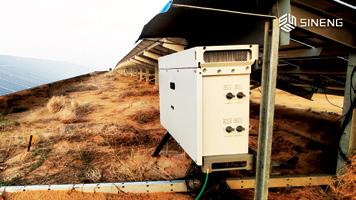

The 320 MW solar power plant in Rajasthan, India, equipped with 1657 units of Sineng’s string inverters SP-250K-INH, is running stably with performance outstripping initial expectations. As part of Bhadla Solar Park, one of the world’s largest solar farms, the project generates about 2,200,000 kWh of electricity perday andis anticipated to generate 803,000,000 KWh of electricity annually, equivalent to eliminating approximately 800,591 tons of carbon dioxide emissions each year.

y pledging to reach the net-zero target by 2070, India’s prime minister, Narendra Modi, not only set the tone for the nation’s climate action trajectory, but also called for more businesses to take prompt actions – operating in smarter, more efficient and sustainable ways. To embrace the longterm decarbonization, Sineng works to improve people’s access to clean energy and turn the vision into reality. With extensive experience gained in diverse projects and continuous innovation in technologies, Sineng’s industry-leading PV inverter solutions shine in the Indian market for their quality, efficiency, and safety. Located in Bhadla Solar Park,the “almost unlivable” environment places greater emphasis on the inverters’ reliability, for normal temperatures hovering between 46 °C and 48 °C (115 and 118 °F) and sand storms occurring frequently. Sineng’s 250kW string inverters, given their IP66 and C5 anti-corrosion protection standards, can adapt to climate extremes while ensuring the PV plant’s stable operation. Featuring maximum efficiency up to 99.0%, 12 MPPTs, I/V curve scan and diagnosis technology, the inverters optimize the LCOE and increase the return on investment.
Having shipped over 9 GW inverters in India and establishing a manufacturing facility in Bangalore of 10 GW production capacity, Sineng consolidates its dominant position in the local market by delivering trust worthy solutions and localization services. In the future, Sineng will continue to foster prosperity in the solar industry, fuel the energy transition, and uncover more opportunities for a greener future.
www.EQMagPro.com 55 EQ MAY 2023 FEATURED
RSA & GERMAN SOLAR INDUSTRY ASSOCIATION COME TOGETHER FOR BENEFIT OF STATE SOLAR MSMES
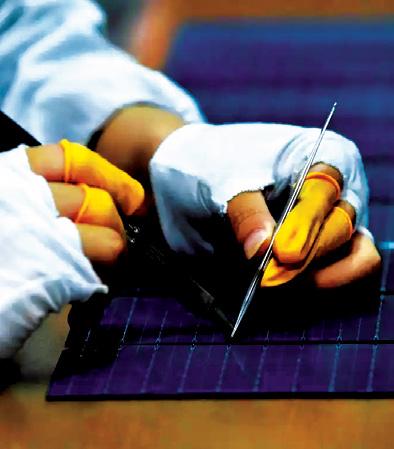
Rajasthan Solar Association (RSA) organized an on-line meeting with German Solar Industry Association on “To Discuss Workings and future perspective of solar industry in Germany for Indian MSMEs” Leading representatives from The German Solar Industry Association (Bundesverband Solarwirtschaft e.V. [BSW-Solar]) – Mr. Ronald Upmann & Mr. Ahmad Sandid from GIZ and Mr. Subrahmanyam Pulipaka from NSEFI joined the leading discussion panel.
NO PLANS TO EXTEND ALMM FOR RENEWABLE ENERGY PLAYER: OFFICIAL
The government earlier extended the ALMM by one year till March 2024 amid industry raising concerns over raw material availability and supply chain
There are no plans to further extend the Approved List of Models and Manufacturers (ALMM) of solar photovoltaic modules at the moment, a senior government official said. Lalit Bohra, Joint Secretary at the Ministry of New and Renewable Energy (MNRE), has made the remarks at the annual ‘Mercom India Renewables Summit 2023’ in the national capital. Replying to a question on plans of extension to the ALMM, he said: “ALMM was only deferred for a year. As of now, we are very clear we are not extending it”. The government earlier extended the ALMM by one year till March 2024 amid industry raising concerns over raw material availability and supply chain. ALMM was introduced to boost domestic manufacturing.
The official further said that “the ministry on a regular basis keeps on interacting with industry stakeholders and actively addresses their issues with respect to projects”. On a question related to include the ancillary and downstream industry under the production-linked incentive scheme for solar module manufacturing, he said the government evaluates any request brought to it and accordingly takes steps.

Mr. Sunil Bansal, President welcomed them. RRECL Managing Director Mr. Anil Dhaka also joined the session. He appreciated our initiative and assured full support by state government for German solar industry for working in Rajasthan. He also elaborated that further mutual opportunities should explored in field of manufacturing as well as BoS products for MSMEs. State will benefit through this.
RSA received a superb response as leading manufacture Mr. Anil Saboo, Elektrolites and Mr. Vineet Mittal, Navitas Solar module manufacturer also joined the session along with other Industry leaders like Renew & Hindustan Zinc Limited.
Mr. Roland informed that there are lot many opportunities in all sectors of solar for Indian MSMEs as they have business requirements in Rooftop, Commercial & Industrial sectors and Large scale solar projects. They also have requirements for solar module manufactures & BoS products. New business models with cooperation of RSA and state government and German industry will be developed as they are going to support in all aspects related to solar industry. RSA will plan soon to lead a delegation to Germany for exploring German solar market for state MSMEs as we will get benefitted from Different expertise of German Solar Industry (Technologies / way of implementation of Solar) as they are one of the top leaders in solar installation with 68000 MW installed. State economy is surely going to be benefitted from this advantage.
56 EQ MAY 2023 www.EQMagPro.com FEATURED
Source: PTI
TOYOTA RECEIVES ZERO-EMISSION CARB EXECUTIVE ORDER FOR HD FUEL CELL ELECTRIC POWERTRAIN KIT

TToyota plans to begin the assembly of new, more efficient fuel cell modules for hydrogen-powered, heavy-duty commercial trucks. oyota has been granted a Zero Emission Powertrain (ZEP) Executive Order from the California Air Resources Board (CARB) for its new heavy-duty fuel cell electric powertrain, the company announced. The hydrogen-fueled powertrain kit includes hydrogen fuel storage tanks, fuel cell stacks, batteries, electric motors, and transmission. It offers a viable alternative to traditional diesel powertrains used in commercial goods transportation as companies look to transition their fleets to zero-emission vehicles. The ZEP Executive Order certifies that a powertrain complies with CARB regulations for zero-emission powertrains determined to meet specific emissions standards required for sale in California. OEMs using Toyota’s certified powertrain may also be eligible for other available incentives, such as CARB’s Hybrid and Zero-Emission Truck and Bus Voucher Incentive Project (HVIP), the Clean Truck Fund (CTF) introduced last year by the Ports of Los Angeles and Long Beach and specific federal incentives.
NOW READY FOR COMMERCIALIZATION




Toyota aims to reduce or eliminate emissions for all mobility solutions, and our fuel cell electric powertrains have proven that hydrogen can play a significant role in the emissions reduction of emissions from heavy-duty transportation, said Scott Friedman, senior program manager of advanced mobility, Toyota Motor North America.
TOYOTA’S HISTORY WITH HYDROGEN-POWER
Toyota’s efforts with hydrogen-powered heavy-duty truck powertrains started with Project Portal back in 2017. Toyota has developed multiple generations of powertrain prototypes during development, such as those found in the Alpha and Beta trucks that logged nearly 14,000 miles of testing and real-world drayage operations in and around the Port of Los Angeles. Yet, it was the generation of a truck named “Ocean” that showed some of the greatest examples of how hydrogen-based powertrains with fuel cell stacks could be used in real-world applications, such as drayage, through a proof-of-concept demonstration at the Port of Los Angeles as part of the Zero-and-Near-Zero Emission Freight Facilities’ “Shore to Store” Project (ZANZEFF). For the project, Toyota worked with Kenworth to develop trucks using an updated prototype fuel cell electric powertrain and deployed 10 Kenworth T680 Class 8 trucks. The 10 trucks served real-world customers via drayage routes, with infrastructure support from Shell, hauling cargo between the Ports of Los Angeles and Long Beach and the LA Basin.
Toyota’s CARB ZEP-certified powertrain kit is now ready for commercialization, with production slated to start for customers later this year at the company’s Kentucky manufacturing plant. This newest generation of powertrain reflects key learnings and improvements in things like energy efficiency, package size, and more from extensive real-world testing and development from the company’s fuel cell development engineering team. Fuel cell electric powertrains are advantageous for heavy- and mediumduty transport when compared to other all-electric options, such as battery electric, as they are often lighter, which allows for more payload. They also offer more uptime thanks to fueling times that are much closer to conventional diesel powertrains.
We believe hydrogen will play a significant role in the emissions reduction of heavy-duty transport while not sacrificing the distance, power, or fueling times needed to keep these fleet and individual operators running, said Chris Rovik, executive program manager, advanced mobility, Toyota Motor North America. “Fuel cell technology is scalable, and we believe it will take an increasingly visible and important role in our collective fight to reduce and eliminate carbon as we move towards a hydrogen society.”
From creating one of the world’s first mass-market passenger fuel cell electric vehicles in the Mirai to applying and scaling the technology now to other applications that can benefit from zero-emissions, including heavy-duty transport, power generation systems, and others, Toyota’s research and development with hydrogen fuel cell technology span nearly 30 years.
Source: PTI
www.EQMagPro.com 57 EQ MAY 2023 FEATURED
WHAT IS APPLE MISSION FOR 2030?
Apple aims to create a sustainable future for itself and the planet.
Apple is committed to reducing its environmental impact by conserving resources, reducing its carbon footprint, and responsibly sourcing materials. Founded in 1976 by Steve Jobs, Steve Wozniak, and Ronald Wayne, Apple has since become one of the world’s largest companies, with a market capitalization of over $2 trillion as of 2021. The company’s headquarters is located in Cupertino, California, and it has offices and stores around the world. Apple Inc., an American multinational technology company headquartered in Cupertino, California has released a 2023 Environmental Progress Report which provides insight into their current goals and initiatives towards a more sustainable future. The 2023 Environmental Progress Report provides insight into the company’s current goals and initiatives towards a more sustainable future. Apple is committed to carbon neutrality, reducing emissions in the supply chain, transitioning to a circular economy, and water stewardship.
COMMITMENT TO CARBON NEUTRALITY
The world’s largest technology company by revenue, with US$394.3 billion in 2022 revenue is committed to becoming carbon neutral across its entire business, including manufacturing and transportation, by 2030. In the 2023 Environmental Progress Report, the mobile technology leader reported that they have already achieved 100% renewable electricity for their global operations, which includes their offices, retail stores, and data centers. Additionally, Apple is actively working with its suppliers to transition to renewable energy, with the goal of having 8 GW of installed clean energy generation capacity by 2030.

REDUCING EMISSIONS IN THE SUPPLY CHAIN
its suppliers to implement energy efficiency measures and transition to renewable energy sources. In the 2023 Environmental Progress Report, Apple reported that over 110 suppliers have committed to using 100% renewable energy for Apple production, and that the company has avoided over 15 million metric tons of CO2e through its Supplier Clean Energy Program since 2015.
CIRCULARITY AND MATERIALS INNOVATION
Apple, the world’s biggest company by market capitalization is committed to transitioning to a circular economy, where products are designed to be reused, refurbished, or recycled at the end of their life cycle. In the 2023 Environmental Progress Report, Apple reported that they have made progress towards this goal by designing products with recycled materials, reducing product packaging, and implementing programs for customers to recycle their old devices. Additionally, the tech innovator is investing in materials innovation to find alternatives to critical raw materials, reduce waste, and improve product durability.
WATER STEWARDSHIP
Apple which has launched the company’s first retail store in India in the financial capital Mumbai recognizes the importance of water conservation and management, particularly in areas where water scarcity is a concern. In the 2023 Environmental Progress Report, Apple reported that they are working to reduce water usage in their operations and supply chain, with the goal of conserving 5 billion gallons of water per year by 2025. Apple is also investing in water restoration projects in water-stressed regions, including a project in California to restore wetlands and improve water quality.
The supply chain contributes to a significant portion of Apple’s carbon footprint, and Apple recognizes the importance of addressing emissions in this area. The company is working with Source: PTI
58 EQ MAY 2023 www.EQMagPro.com FEATURED
ELECTRIC VEHICLE
WHAT ARE THE MOST PROMISING ENERGY STORAGE TECHNOLOGIES?
Efficient energy storage technology is needed to overcome fluctuations in renewable energy supply and decrease our reliance on fossil fuels. Here are some of the most promising technologies in the industry today.
s the world moves towards a more renewable and decentralised energy system, energy storage is becoming increasingly important. Energy storage technologies allow us to store energy when it’s available and release it when it’s needed, providing a range of benefits for the grid, businesses, and households. One of the primary reasons efficient energy storage is crucial for the green transition is the need to manage variable energy supply. Renewable energy sources like wind and solar are intermittent and don’t provide a consistent energy supply. Energy storage can help smooth out these fluctuations by storing excess energy when it’s available and releasing it when needed. As many renewable energy sources are becoming cheaper and cheaper, storing them and using them later can be very cost-efficient for society. Energy storage can also provide backup power during emergencies and help reduce peak demand, which occurs when many people use electricity simultaneously. By storing excess energy during offpeak hours and releasing it during peak hours, energy storage can help prevent blackouts and reduce the need for expensive infrastructure upgrades or reliance on fossil fuels. Improving energy storage infrastructure and overcoming the issues posed by the intermittent renewable energy supply is essential to achieve decarbonisation targets and can drastically help eliminate our fossil fuel dependence.
THERMAL ENERGY STORAGE
Thermal energy storage (TES) is an innovative technology that offers a promising solution for storing and releasing heat energy. It allows us to leverage renewable energy sources such as wind and solar by utilising the energy they generate to heat a “thermal battery” that can store the heat for several hours or even days. This stored energy can be used to generate electricity when needed, especially during periods when renewable energy sources are not readily available. This approach is a game-changer for renewable energy as it enables us to use it when it’s most cost-effective, which typically occurs during sunny or windy periods. As a result, the overall cost of electricity can be reduced, and the grid’s stability can be improved. One of the main benefits of TES is that it offers a simple approach to energy storage. Thermal batteries are typically constructed from abundant materials that are cheap to assemble and maintain and can operate for many years. For instance, a lot of TES companies, such as Antora Energy, use solid carbon, which is extremely cheap and highly accessible. The existing supply chain of solid carbon is over 30 million tons a year, 50 times the available quantity of lithium. The technology is also highly scalable, meaning it can be adapted to suit various applications, from large-scale power plants to smaller residential buildings.
PUMPED HYDROELECTRIC STORAGE
Pumped hydroelectric storage (PHS) is currently one of the most widely used forms of energy storage. PHS involves pumping water from a lower reservoir to a higher one during low electricity demand, such as at night, using excess electricity generated from renewable sources. During periods of high demand for electricity, the stored water is released to the lower reservoir which generates electricity by turning turbines. This process enables excess electrical capacity to be stored efficiently and inexpensively, allowing it to be released when it is most needed.
According to the International Energy Agency (IEA), the total installed capacity of PHS worldwide was around 160 GW in 2021, making it the most widely deployed grid-scale storage technology. Indeed, PHS accounts for over 90% of the world’s electricity storage, at approximately 8,500 GWh in 2020. The majority of PHS plants currently in operation provide daily balancing, ensuring a steady supply of electricity during peak demand. However, there is potential for PHS to be used in larger-scale applications, such as supporting the integration of intermittent renewable energy sources into the grid.The United States has the largest capacity of PHS, with many plants scattered across the country. The world’s largest PHS plant, the Bath County Pumped Storage Station, is located in Virginia, with a capacity of more than 3 GW, a 24 gigawatt-hour storage capacity, the equivalent of one year of electricity use for 6,000 homes. Despite its benefits, PHS does have some limitations, including the need for suitable topography and access to large amounts of water. Nevertheless, PHS remains a key technology for energy storage and has enormous potential to help accelerate the transition to a more sustainable energy future.
GREEN HYDROGEN
The production of green hydrogen through electrolysis powered by renewable energy sources like solar and wind offers a promising solution for long-term energy storage. Hydrogen produced from this process can be stored and converted back to electricity when needed, providing balancing power for the grid. Most importantly, it can be burned when required without releasing any GHG emissions. One of the significant advantages of hydrogen is its ability to be stored for months without losing power through discharge, making it an attractive option for long-term energy storage. In comparison, lithium-ion batteries can only store energy for a couple of hours. On the other hand, the “power-to-gas-to-power” process required by green hydrogen has a high energy storage capacity, but it is less efficient and more expensive than other storage technologies. Indeed, converting the power to gas and back to power has an efficiency of 18%-46%, according to the Massachusetts Institute of Technology. To put that into perspective, pumped-storage hydropower has an efficiency closer to 70%-85% Despite being a promising option for energy storage, the logistics and infrastructure to scale up its production are not yet developed enough. Bringing production costs down and at a larger scale could provide a significant step towards reducing carbon dioxide emissions and even creating a circular economy. Many projects are already in the works as more industry leaders, such as John Ketchum at NextEra Energy Resources, see green hydrogen as a “really long-term solution.” NextEra is already working on 50 potential green hydrogen projects. In the EU, many projects have been implemented, such as the Green Skills for Hydrogen, an EU-backed skill conversion and training program aimed at equipping workers with the necessary tools and skills to adapt to the new technology.
www.EQMagPro.com 59 EQ MAY 2023
A
ELECTRIC VEHICLE
IIT-INDORE MAY WORK ON ELECTRIC VEHICLE ECOSYSTEM WITH FIRMS & FOREIGN VARSITIES
The Indian Institute of Technology (IIT), Indore, is contemplating to partner with industries and foreign universities to give a thrust to electric vehicle (EV) ecosystem and create a skilled talent pool in the segment. IIT-I is working on various projects in the EV segment aimed at addressing challenges and streamline adaptation of the EV technology.
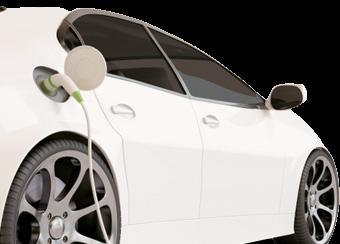

There are no plans to further extend the Approved List of Models and Manufacturers (ALMM) of solar photovoltaic modules at the moment, a senior government official said. Lalit Bohra, Joint Secretary at the Ministry of New and Renewable Energy (MNRE), has made the remarks at the annual ‘Mercom India Renewables Summit 2023’ in the national capital. Replying to a question on plans of extension to the ALMM, he said: “ALMM was only deferred for a year. As of now, we are very clear we are not extending it”. The government earlier extended the ALMM by one year till March 2024 amid industry raising concerns over raw material availability and supply chain. ALMM was introduced to boost domestic manufacturing.
The institute said smooth electricity supply and adapting the EV technology in the Indian environmental conditions are major challenges to EV in India. “The main challenge in EV can be electricity supply and adapting EV technology under Indian environmental conditions. To address these challenges, there are aggressive steps taken by the government and the private sector to in-
To contribute to the EV ecosystem, the institute is researching effect of EV charging on the grid, sensors related to EV, battery energy storage system, charges, and power electronics related to EV among others. IIT-I electrical department professor and Centre for Electric Vehicle and Intelligent Transport Systems prof-in-charge Amod Umarikar said, “IIT-I is working on a number of projects in EV and looking to collaborate with industries and foreign universities to give a boost to the ongoing activities. We are in discussion with industries which are working in EV technology and some universities from abroad to collaborate on research and address challenges in the EV segment.”
The institute also stressed on developing a talent pool for the EV segment and has designed training programmes for industries. Umarikar said, “Apart from training industry, we also run a MTech programme in EV technology from 2021 to give train

ELECTRIC VEHICLE CHARGER AIMS FOR 15% MARKET SHARE, DELTA SHOWCASES COMPLETE EV INFRASTRUCTURE


Delta Electronics has been operating in the electric vehicle (EV) field for 15 years and their business in EVs is now thriving. The company combined transportation and infrastructure for the first time at 2035 E-Mobility Taiwan, integrating key components and power systems for both four-wheel and two-wheel EVs and creating comprehensive EV charging infrastructure solutions.
Shan-shan Guo, Delta’s Chief Brand Officer, stated that EVs are one of the main driving forces behind Delta’s double-digit growth target for the next five years. Currently, the company has already shipped 2 million units of EV chargers globally. At the exhibition, Delta showcased an ultra-fast 350 kW DC charger that enables EV owners to travel between Taipei and Kaoshiung in just 20 to 30 minutes. Six more highway service stations are slated for construction in the second half of the year, and a total of 22 new 350 kW fast chargers will be introduced.
Delta also showcased several other EV charging solutions at the exhibition, including a 50 kW DC Wallbox for commercial buildings, and a lightweight AC MAX charging pile. Rui-yuan Xu, deputy manager of Delta’s EV charging business, said that over 200 communities, commercial buildings, charging stations, and highway service areas in Taiwan have already opted for Delta’s EV charging infrastructure solutions. Delta’s current market share of onboard chargers for EVs stands at 4%; the company has set a future goal of achieving a 15% market share. Delta points out that the accelerated development of fast-charging stations in various countries is in response to the growing power capacities of EVs and their increasing popularity. This accelerated development is essential to reassuring consumers who purchase EVs. The exhibition featured a range of electric two-wheeled vehicle power systems, such as e-scooters and e-bikes, as well as charging and power modules. A newly developed e-bike mid-drive motor with a compact design (Ø 11 x 9 cm) that weighs roughly 2.9 kg is expected to be mass-produced in the first quarter of 2024 and is suitable for use in e-Trekking bikes, e-MTBs, and eCargo bikes. Yu-sheng Huang, project manager of Delta’s Drive Products Division, noted that most e-Bike motors currently come from Europe, and as such this presents an opportunity for Taiwan in the future.
Delta further showcased its EV power control and drive systems, which include traction motors, traction inverters, integrated DC power modules, bi-directional on-board chargers (referred to as combo on-board chargers) and battery power adapters (also known as battery junction boxes). The exhibition also showcased high-efficiency lightweight fans and thermal management solutions that are tailored to meet vehicle requirements. These solutions cover the main systems of the entire vehicle, including battery management (BMS), autonomous driving (AD), advanced driver assistance systems (ADAS), LED headlights and lighting, intelligent cockpits, and automotive HVAC and climate seats. In the future, newly constructed charging stations for public and mass use are expected to primarily utilize fast-charging technology. The European and American markets show significant potential for the growth of fast-charging stations. Delta points out that their most important factories are currently located in Thailand, Wujiang (China), and Slovakia. However, they will also establish factories in Dallas (USA) and Hungary to address the localization needs of different countries; the Dallas factory will cater to Delta’s overall demand, while the Hungarian factory will primarily focus on on-board equipment production.
www.EQMagPro.com 61 EQ MAY 2023 ELECTRIC VEHICLE
The ultra-fast 350 kW DC charger has a maximum charging current of up to 540 amps and features dual-output charging connectors.
Source: energytrend
BUSINESSES RUSH TO INSTALL ELECTRIC VEHICLE CHARGING TO KEEP TOURISTS COMING BACK
EV-driving tourists visiting the New South Wales South Coast are already increasing, raising concerns a lack of charging stations may force them to go elsewhere. In summer, some EV drivers reported waiting an hour or more to use one of three public fast chargers in Batemans Bay, and further south the only public fast charger in the Bega Shire was under maintenance for weeks at a time. Katherine Maxwell from the South Coast Health and Sustainability Alliance is one of a growing number of people worried tourists will start looking elsewhere for a holiday. “We had queues lining up four or five deep over summer,” Ms Maxwell said. “Imagine showing up in a petrol car and you had to wait an hour and a half to fill up your car. You just wouldn’t do it.”
CANBERRANS LEAD EV CHARGE
The South Coast is heavily dependent on tourism, with an estimated 40 per cent of money spent in the Eurobodalla Shire coming from visitors — the vast majority of them Canberrans. The ACT has the highest uptake of EVs in the country and is forecast to have up to 42,000 of them by 2030. Already, 10 per cent of all new cars sold in the ACT are eletric. In New South Wales, that number is sitting around 4 per cet and rapidly rising. On the South Coast, the Eurobodalla Shire Council has released a draft strategy for EV infrastructure that includes doubling the amount of public fast chargers by 2027. Even with those plans in place, figures from the NRMA show the rate at which new public chargers are being built is not keeping up with the number of new EVs on the road.
ADDING VALUE WITH FAST CHARGERS

It is a gap that has created an opportunity for business owners like publican Matt Irving in Moruya. About four months ago he installed two electric vehicle chargers at the back of his hotel with assistance from a federal government rebate scheme and said he was already noticing a difference in patronage. “We rely so heavily on Sydney and Canberra … because of the uptake of electric vehicles in Canberra, we know we had to be part of that and do something about it,” Mr Irving said. “It’s really added value to the business. We have people coming in saying they’re using our service.” The chargers run at almost no cost to the hotel during the day thanks to solar panels. And even at night, the cost is minimal. Mr Irving said it had given him an edge over other pubs on the same street. “We know that there is going to be a massive uptake of EVs, we know they want to come from Canberra, they want to come from afar,” he said. “They want to come to the coast and they didn’t have many options.”
CONSUMERS DRIVE CHANGE
Peter Campbell lives in Canberra and frequents the South Coast. In his long-range EV he easily makes the trip on one charge but, for longer trips, the availability of chargers plays a part in deciding where to stop. “It makes a difference to have destination charging at a pub, cafe, winery, or overnight accommodation,” Mr Campbell said. “If we’re thinking of staying in accommodation in a town somewhere the shortlist will be which places offer charging overnight.” He said the absence of a public charger in Braidwood, halfway between the coast and Canberra, had a large impact on those wth low-range EVs. Ms Maxwell said the South Coast was currently considered an EV black spot, with most new chargers being built along the Hume Highway, far from the coastal route. She said the council and state government must prioritise building more fast chargers before it was too late. “We’ve got to keep up with the momentum,” she said. “We’re behind at the moment. We need a number of [these chargers] going in every year.”
62 EQ MAY 2023 www.EQMagPro.com
ELECTRIC VEHICLE
Source: abc
With more than 10 per cent of new cars sold in the ACT now running on electricity, popular coastal getaway towns are struggling with the infrastructure needed to keep the tourism trade fully charged.
ELECTRIC VEHICLE
TOYOTA INDIA STARTS EXPORTING EV COMPONENTS TO JAPAN
TKAP has started exporting the e-Drive (a key part of the electrified powertrain) to Japan, and to Indonesia and Thailand. The fact that Toyota India is exporting the e-Drive to Japan is a shot in the arm for the Make in India initiative, considering that quality standards of Japan are so tough to meet.
In a case of local manufacturing excellence, Bengaluru-based Toyota Kirloskar Auto Parts (TKAP) has started exporting the e-Drive (a key part of the electrified powertrain) to Japan, in addition to markets such as Indonesia and Thailand. The e-Drive is an advanced automotive technology used in hybrid electric vehicles (HEVs) such as Toyota Urban Cruiser Hyryder and Toyota Innova Hycross, as well as in Maruti Suzuki Grand Vitara, which Toyota Kirlorkar Motor (TKM) manufactures for Maruti Suzuki, under the ToyotaSuzuki global tie-up. The particular e-Drive being exported is the one used in the Urban Cruiser Hyryder and the Grand Vitara (the one used in the Innova Hycross is bigger in size and is still being imported). While in simple words the e-Drive can be defined as a set of components and systems that convert electricity into power in the drive system of an HEV, the technology is all but simple.
“The e-Drive is a very complex technology, mastering which requires years of planning and months of execution,” a senior member of the Society of Automotive Engineers India told FE. “The fact that Toyota India is exporting it to Japan is a shot in the arm for the Make in India initiative, especially considering that the quality standards of the Japanese market are the toughest to meet in the world.”
Sudeep Dalvi, senior vice-president & director, and chief communication officer at TKM, told FE that while Toyota is taking the hybrid route to electrification of mobility, it’s taking a business sustainability route towards localisation of parts needed for that electrification. “Whichever technology we introduce in India, our aim is to localise that and develop a vendor base for the same,” he said. “We aim to reach carbon neutrality by empowering our vendors.”
This e-Drive, however, isn’t fully localised yet. A TKAP official told FE that localisation levels in value terms are a little over 50%, as certain subcomponents have very stringent quality requirements, for which the company is working with local suppliers (to raise their quality standards).

SOPS FOR AUTO PLI WILL BOOST LOCAL MANUFACTURING

KN Prasad, the managing director of TKAP, has said that the standard operating procedures (SOPs) for the Auto Sector Production Linked Incentive (PLI) scheme will go a long way towards boosting the local manufacturing sector and reducing dependence on imports. “The SOPs consist of simplified procedures with minimum paperwork,” he said. “This will help speed up the overall process of application and approval process.” On April 27, the Ministry of Heavy Industries had released SOPs under the PLI Auto scheme to testing agencies.
With this, applicants under the scheme can submit applications for testing and certification of advanced automotive technology (AAT) products, which will help them qualify for incentives under the PLI Auto scheme. Bengaluru-based TKAP, a JV between Toyota Motor Corp, Japan, Aisin Seiki Co, Japan, and Kirloskar Systems Ltd, India, manufactures axles, propeller shafts and transmissions for vehicles and supplies these to Toyota in India and globally, even as certain parts for Toyota cars are still being imported.
Prasad added that currently most of the advanced automotive technology components are being imported because of an almost non-existent supply chain base in India. “One of the key factors to get incentives under this PLI scheme is minimum domestic value addition criteria, and this will encourage more localisation, boost domestic manufacturing sector and reduce dependence on imports, thereby creating more job opportunities,” he said. “It would also enhance India’s export capabilities in the high-end automotive technology components.”

www.EQMagPro.com 63 EQ MAY 2023
ELECTRIC VEHICLE
AUDI INTRODUCES ‘CHARGE MY AUDI’ ON MYAUDICONNECT APP FOR ENHANCED EV CHARGING EXPERIENCE
Audi, the German luxury car manufacturer, announced the introduction of ‘Charge my Audi’ on the myAudiConnect app – a one-stop solution that gives Audi e-tron customers access to multiple electric vehicle charging partners, all on one app. Charge my Audi is an industry-first initiative that enhances convenience for customers. The application currently includes five charging partners – Aargo EV Smart, Charge Zone, Relux Electric, LionCharge and Zeon Charging that are powered by the Numocity Technologies eMSP roaming solution. Audi e-tron customers benefit from complimentary charging across the network till August 2023.
Charge my Audi allows customers to efficiently plan their drive route, identify charging stations along the way, check the availability of charging terminals, start and stop charging and also pay for the service via one single payment gateway. Currently, 750+ charge points are available to Audi e-tron owners on Charge my Audi with more to be added over the next few weeks and months.
Commenting on the occasion, Mr Christian Cahn von Seelen, Executive Director of Volkswagen Group Sales India, Member of the Board, “As a group, we are committed to electric mobility and are continuously evaluating electric vehicles and developing the charging ecosystem. The luxury electric segment is witnessing good demand and initiatives like these for customers only strengthen the overall practicality in terms of ownership experience.”

Commenting on the announcement, Mr Balbir Singh Dhillon, Head of Audi India, said, “Audi India is focused on customer centricity. We are continuously evaluating and introducing solutions for our customers that make the ownership experience hassle-free. ‘Charge my Audi’ is a one-of-a-kind, industry-first initiative that maximizes customer convenience. Ever since we introduced e-tron to India, we have focused on building a comprehensive ecosystem to support the transition to electric mobility.”

Mr Dhillon further added, “Along with our partners, we have an extensive charging network to alleviate range anxiety and help customers experience the true joy of owning an e-tron. There are 750+ charge points currently available to e-tron owners and we will grow this number exponentially.”




Commenting on the partnership, Mr Kartikey Hariyani, Founder and CEO of, CHARGE+ZONE said, “We are thrilled to partner with Audi India and provide a comprehensive charging solution for Audi e-tron owners through our ‘ChargemyAudi’ program. Leveraging the network charging technology OCPI (Open Charge Point Protocol), at CHARGE+ZONE, we are committed to supporting the growth of electric mobility in India, and this collaboration allows us to offer convenient and accessible charging infrastructure to Audi owners in India. By integrating our network operating system ChargeCloud as well as our network of high-speed charging stations into the ‘myAudiConnect’ app, we aim to enhance the ownership experience and contribute to the wider adoption of sustainable transportation. This is the first step in the next phase of growth for CHARGE+ZONE where we are working towards making India an EV-friendly country and providing easy availability to customers hence driving the growth of EVs in the market. By partnering with OEMs, we are ensuring that their users are aware of the chargers in close vicinity when in need as we rapidly expand to electrify the Indian State and National highways.”

Charge my Audi eliminates the hassle of downloading multiple applications. Audi e-tron customers can initiate the charging process using the ‘myAudiConnect App’ while automated identification and billing processes run simultaneously. The technology and roaming platform have been powered by Numocity Technology’s eMSP platform. Audi India currently sells the Audi e-tron 50, Audi e-tron 55, Audi e-tron Sportback 55, Audi e-tron GT and Audi RS e-tron GT. The brand will launch the new Audi Q8 e-tron in India, later this year.
Source: PTI
64 EQ MAY 2023 www.EQMagPro.com
TATA TIAGO EV ACHIEVES 10,000-UNIT SALES MILESTONE
The Mumbai-headquartered company said that it also made it the fastest electric vehicle to achieve this milestone in less than four months. The Tiago EV is the ‘fastest booked EV in India’ receiving 10,000 bookings in just 24 hours and 20,000 bookings by December 2022.
utomobile firm Tata Motors has announced that it has achieved the 10,000-unit sales milestone for its Tiago EV since its deliveries commenced. The Mumbaiheadquartered company said it also made it the fastest electric vehicle to achieve this milestone in less than four months. The Tiago EV is the ‘fastest booked EV in India’, receiving 10,000 bookings in just 24 hours and 20,000 bookings by December 2022. The company said the EV has successfully made its way to 491 cities, covering a total of 11.2 million km and saving 1.6 million grams of carbon dioxide from emitting into the atmosphere. The Tiago has not only become a segment disrupter that offers “premiums, safety and technology features and an ecofriendly footprint” but it is also a fun electric trendsetter that provides its users with a superior driving experience, according to a statement from Tata Motors. Tata Motors in another statement said it would hold its board meeting on May 12. It will be the first time since FY16 that the company can declare a dividend.


Vivek Srivatsa, Head, Marketing, Sales and Service Strategy, at Tata Passenger Electric Mobility Ltd., said, “The Tiago EV since its launch has been creating milestones. From becoming the ‘Fastest Booked EV in India’ to becoming the fastest EV in India to achieve the 10,000 delivery mark, this electric hatch has left no stone unturned.”

He said that the Tiago EV was launched to democratise the EV experience. “It was a result of our ambition to fast forward the ongoing evolution towards the future of mobility by introducing a car that would encourage the rapid adoption of EVs. And, we are so happy to see our vision realised as 10,000 families said yes to Go.ev with the Tiago EV,” Vivek Srivatsa said.
Source: PTI
ROYAL ENFIELD TO PUMP IN RS 1000 CRORE IN TN, PLANS TO ROLL OUT ELECTRIC VEHICLES
In a bid to cater to the growing demand for Royal Enfield motorcycles, parent company Eicher Motors intends to invest over Rs 1,000 crore in FY24. Royal Enfield posted its highest ever sales of 8,34,895 motorcycles in FY23, up 38.4 percent from 6,02,268 units in FY22. During the year, Royal Enfield also crossed the 1 lakh export shipments milestone for the first time. Siddhartha Lal, MD of Eicher Motors said he is upbeat about RE’s future, with the international markets hitting an inflection point by crossing 1 lakh units.
ROYAL ENFIELD’S ELECTRIFICATION PLAN
Lal says while the shift towards electric vehicles is gathering pace, the internal combustion engine is here to stay for the next decade at least. There is strong traction for EVs for short-distance city commutes, but for long distances, internal combustion engines will continue to remain at the core till the time-weight and cost equation remains high. On Royal Enfield’s own EV plans, Lal said the company is working day and night on EVs, “We are not chilling, there is a crazy amount of pace on EV development. Our process does take more time since our testing and validation process is better than the best in the world and that is where we take more time and effort.” Given the rapid change of pace on the electrification front – Royal Enfield’s new product development process is agile, assured Lal, citing that if certain technologies like batteries or motors evolve faster, those components can be upgraded in a shorter span of time.
NEW ROYAL ENFIELDS IN THE OFFING
On the mainstream two-wheeler front, the company says the newly launched Hunter 350 has already crossed the 1 lakh sales milestone and a majority of the buyers were non-Royal Enfield intenders. To build the momentum further, the company will be relying on its J platform to come out with a slew of new offerings in the coming year.
Lot of new motorcycles are coming, says R Govindarajan, CEO, Royal Enfield, “We also have a very well thought through line-up in the coming year. We will continue to develop our products and are very focused on what customers are looking for – pure motorcycle experience. Hence we offer apparels, accessories and the focus has always been on the motorcycling experience and community building.
Source: PTI

www.EQMagPro.com 65 EQ MAY 2023 ELECTRIC VEHICLE
This investment will focus on bringing new Royal Enfield bikes to the market, both petrol and electric.
A
TACKLING THE HEATING CRISIS: CIRCULAR DESIGN AND THE FUTURE OF HOME ENERGY STORAGE
As the environmental and financial costs of gas and oil boilers escalate, electric heat pumps have emerged as a promising eco-friendly heating solution – but they only go so far
We must integrate heat pumps with renewable energy sources and energy storage technology, creating a smart, adaptable and sustainable home energy system. This shift hinges on contractors, architects, housebuilders, designers, manufacturers and policymakers prioritising home energy storage with sustainable design, maintenance and innovation within the circular economy industry, ultimately paving the way for a cleaner, greener future for all.
Cleaner, cheaper home energy systems are top of mind for consumers, policymakers and the construction industry. Heating homes is responsible for around 14% of carbon emissions in the UK and nearly 80% of UK residents used gas to keep warm last winter, while facing gas price rises by nearly 120% in the 12 months up to February 2023 (according to the Institute for Government and the Office for National Statistics). Such heavy reliance on expensive fossil fuel heating is far out of step with the UK’s aim of net zero by 2050. As UK builders, developers and architects phase out gas boilers in new homes by 2025, the search for a viable, sustainable and long-term alternative heating system is underway. Heat pumps, which can reduce carbon footprint by two-thirds or more, are the most talked about alternative today. There are clear economic and environmental advantages to heat pumps but they are not a “one-size-fits-all” solution and may not be suitable for every home. Like all appliances consuming significant electricity, an air source heat pump will require much more energy when stressed and their varied and fluctuating requirement for electricity must be addressed.
COMBINING RENEWABLE ENERGY AT HOME WITH ENERGY STORAGE TECHNOLOGIES
To meet the growing demand for electricity due to the adoption of heat pumps, our current power systems must adapt. To minimise carbon emissions and lower energy costs for consumers, a transition to renewable energy sources is essential for homes. Energy storage acts as a clean technology enhancer and complements heat pumps. It helps address increased electricity demand and costs while providing a smart, flexible, and reliable home energy system to support the operation of the heat pump. Combining renewable technology with a battery energy storage system (BESS) is a highly efficient method for accessing clean energy that offers flexibility in terms of power supply, regardless of the availability of sunlight. By simply connecting the BESS to solar panels, the system is capable of storing solar energy as electricity, ready to power the heat pump or other low-carbon heating alternatives such as electric heaters, for much colder months. A BESS’s independence from the grid has obvious advantages for rural locations but for the majority of properties, being able to connect has added benefits. Surplus clean energy can be sold back to the grid, helping to recover installation costs more quickly and reducing overall carbon emissions. Importantly, scheduling recharging
during off-peak hours enables the system to take advantage of lower electricity tariffs. By utilising renewable energy sources and optimising the use of mains electricity during lowcost tariff periods, users can substantially lower operating expenses and decrease carbon emissions for themselves and the UK’s power grid.
NOT ALL HOME ENERGY STORAGE TECHNOLOGIES ARE CREATED EQUAL
Energy storage is an incredibly important and often overlooked component of sustainable and affordable heating systems, but it must be recognised that increased battery waste is its own, significant threat to the environment.
Shifting the global primary energy storage from hydrocarbons to batteries without a well-considered plan for what happens when they are depleted is not a strategy to stand on; it’s tomorrow’s environmental disaster.” Dr. Amrit Chandan, Co-Founder and CEO of Aceleron


As the UK and the world transition to clean energy sources, and demand for batteries and energy storage systems increase, we risk creating a battery waste crisis. The mounting issue of battery waste endangers the environment and human health, as toxic substances infiltrate our air, soil and water. Depletion of valuable resources exacerbates the problem, while fragile ecosystems teeter on the brink of disruption. The answer is long-lasting solutions, based on circular economy principles. BESSs must be maintained, serviced, scaled and upgraded over time without unnecessary landfill disposal. Aceleron’s Offgen is the first energy storage system designed to support a sustainable model. Instead of permanent assembly methods, Offgen uses patented compression technology, enabling the batteries to be taken apart, down to a single cell, for repair, maintenance and upgrade, facilitating a resilient battery system. Serviced batteries can match the wear of solar PV panels – giving an extended lifespan of over 20 years rather than 4-5 for normal batteries. And when finally at the end of use, the components can be separated and reused or recycled to reduce waste. Scalability and flexibility offer users great value for their money. They can easily add more cabinets for larger capacity and if they move, the all-in-one system can be disconnected and taken with owners to their new home, becoming a convenient and long-lasting solution for home heating.
Policymakers and businesses need to take action... Suppliers must consider how their products are designed and maintained for years of use and then managed for safer end-of-engineered life. Repairable, long-life products bring down costs for the user and our planet.
66 EQ MAY 2023 www.EQMagPro.com ENERGY STORAGE
TODAY’S ENERGY LANDSCAPE AND HEAT PUMPS
THE ROLE OF BATTERIES IN GRID-SCALE ENERGY STORAGE
As the world shifts towards greener energy production, there is a growing need for grid-level energy storage systems to balance power generation and consumption. One solution to this challenge is using batteries in grid-scale energy storage systems. In this article, we will explore the role of batteries in grid-scale energy storage and their potential applications for improving grid management.
IMPORTANCE OF GRID-SCALE ENERGY STORAGE
Grid-scale energy storage has the potential to revolutionize the electric grid by making it more adaptable and capable of accommodating intermittent and variable renewable energy sources. In addition, it provides significant system services such as short-term balancing, grid stability ancillary services, establishing a sustainable low-carbon electric pattern, long-term energy storage, and restoring grid operations following a blackout. Researchers have explored various energy storage systems, such as hydroelectric power, flywheels, capacitors, and electric batteries, to facilitate the operation of the power grid. Electric batteries have emerged as the most viable option because of their rapid response time, flexibility, and short construction cycles. However, when integrating them into grid-level energy storage systems, the capacity, lifetime, energy efficiency, power, and energy densities must be considered.
TYPES OF BATTERIES USED IN GRID-SCALE ENERGY STORAGE
Lithium-ion batteries are preferred for their high energy efficiency, density, and long cycle life. They are currently the primary battery technology for stabilizing the grid in the United States, with 77% of electrical power storage systems relying on them. Flow batteries offer a promising alternative to Li-ion batteries for grid-scale energy storage due to their scalability, ability to increase duration without compromising power density, and use of a wider range of materials. They also have a longer lifespan (100,000 cycles over a 20-year lifespan) and pose fewer risks of explosion or fire. New options based on organic metal-free materials, vanadium, zinc, and other alternatives are emerging, making flow batteries an exciting area of research for grid-scale energy storage. The Role and Potential Applications of Batteries in Grid-Scale Energy Storage
GRID MONITORING AND CONTROL
Renewable energy sources like wind and solar are intermittent, and old rotating generators can’t entirely compensate for the fluctuation in their output. Therefore, batteries are used to balance the power more quickly without involving heavy mechanical parts that wear out quickly. Batteries are also good at providing a quick response and scalability, making them suitable for managing power. Li-ion batteries are particularly useful in managing peak loads for up to four hours and can replace gas-fired power plants. Also, batteries can provide flexibility to the transmission grid, maintaining stable system operation even during contingency events.
POWER BACKUP SYSTEM
Batteries are essential for maintaining power backup systems and ensuring grid stability. They possess flexibility and can be adjusted in terms of location and scale as needed. Batteries can also absorb energy and function as a fast-acting load, which helps manage the balance between power supply and demand. In addition, their deployment increases the operational capacity of existing transmission lines without additional towers or lines.
PEAK SHAVING
Battery systems in electric grids are designed to provide energy during high peak demands and recharge during off-peak electricity hours. Lithium-ion batteries are a promising option for such applications due to their high energy density and round-trip efficiency. These batteries help maintain frequency and voltage stability in islanded applications and large-scale deployment, especially when there is a disparity between power generation and consumption.
OPERATING RESERVES AND ANCILLARY SERVICES
Maintaining a stable power system requires generation to match the demand for electricity at all times, which requires various operating reserves and ancillary services operating on different timescales. Batteries are well-suited for short-term reliability services, such as primary frequency response and regulation, due to their rapid charging and discharging capabilities, which are faster than traditional thermal plants. Additionally, appropriately sized battery systems can provide longer-duration services, such as ramping and load-following, to ensure a stable electricity supply meets demand.
RECENT DEVELOPMENT
Giving Electric Vehicle Batteries a Second Life: 1300 Recycled EV Batteries Power Grid-Scale Storage System. Electric vehicle (EV) batteries that no longer meet standards for EV use can still retain up to 80% of their total usable capacity. B2U has built a 25 MWh stationary storage system using 1,300 recycled EV batteries from Honda and Nissan and tested Tesla Model 3 batteries for grid-scale energy storage. In addition, the company’s patented EV pack storage system significantly reduces the storage cost and automatically disconnects batteries if they deviate from operating specifications.
The system charges from a connected solar farm and provides grid services to California’s wholesale grid market 24/7. In addition, the technology increases grid storage capacity and allows end-of-life EV batteries to be taken to recycling facilities. A study suggests that end-of-vehicle-life EV batteries plus in-use vehicleto-grid could supply the world’s short-term grid energy storage requirements by 2030 and up to 32-62 terawatt-hours of short-term storage globally by 2050.
MIT MODELING FRAMEWORK ACCELERATES DEVELOPMENT OF FLOW BATTERIES FOR GRID-SCALE ENERGY STORAGE
Flow batteries are a more efficient and safer alternative to Li-ion batteries in grid-scale energy storage systems. However, current flow battery technology predominantly relies on vanadium as its active material, and scientists are exploring alternative chemistries due to concerns over its reliability and availability. MIT researchers have developed a techno-economic modeling framework that estimates the “levelized cost of storage” for different chemistries and provides general guidelines for choosing between finite-lifetime and infinite-lifetime materials. While there is no clear winner among the different chemistries, the framework allows for the estimation of capital and operating costs over the system’s lifetime, helping to make informed decisions on which option to pursue. The modeling framework provides a valuable tool for assessing the economic viability of new and emerging energy technologies for flow batteries. This will be crucial for grid-scale energy storage, requiring long-duration, large-scale electricity storage to support renewable energy sources.
Source: azom
www.EQMagPro.com 67 EQ MAY 2023 ENERGY STORAGE
G7 VOWS TO STEP UP MOVES TO RENEWABLE ENERGY, ZERO CARBON
Energy and environment ministers of the Group of Seven wealthy nations vowed to work to hasten the shift toward cleaner, renewable energy, but set no timetable for phasing out coal-fired power plants as they wrapped up two days of talks in the northern Japanese city of Sapporo.
The officials issued a 36-page communique laying out their commitments ahead of a G-7 summit in Hiroshima in May. Japan won endorsements from fellow G-7 countries for its own national strategy emphasizing so-called clean coal, hydrogen and nuclear energy to help ensure its energy security. “Recognizing the current global energy crisis and economic disruptions, we reaffirm our commitment to accelerating the clean energy transition to net-zero greenhouse gas (GHG) emissions by 2050 at the latest,” the communique says. “We call on and will work with other countries to end new unabated coal-fired power generation projects globally as soon as possible to accelerate the clean energy transition in a just manner,” the document says. The leaders reiterated the need to urgently reduce carbon emissions and achieve a “predominantly decarbonized power sector” by 2035. They also stressed the importance of ensuring supplies of critical minerals, used in many high-tech products, are stable and conform to high social and environmental standards.
I believe that we were able to demonstrate to the international community that our commitment to climate change and environmental issues is unwavering, even in the context of the situation in Ukraine,” Akihiro Nishimura, Japan’s environment minister, said after the talks ended.

The stipulation that countries rely on “predominantly” clean energy by 2035 leaves room for continuation of fossil-fuel fired power. But the ministers agreed to prioritize steps toward phasing out “unabated” coal power generation — plants that do not employ mechanisms to capture emissions and prevent them from escaping into the atmosphere.
U.S. Special Presidential Envoy for Climate John Kerry said the meetings were “really constructive.” “I think the unity for the goal that was expressed of phasing out unabated fossil fuels is a very important statement,” Kerry said in an interview with The Associated Press.




The call to action comes as China and other developing countries step up demands for more help in phasing out fossil fuels and stabilizing energy prices and supplies amid disruptions from Russia’s war on Ukraine. The issue of setting a timeline for phasing out coal-fired power plants is a longstanding sticking point. Japan relies on coal for nearly one-third of its power generation and is also promoting the use of so-called clean coal, using technology to capture carbon emissions, to produce hydrogen — which produces only water when used as fuel. The G-7 nations account for 40% of the world’s economic activity and a quarter of global carbon emissions. Their actions are critical, but so is their support for less wealthy nations often suffering the worst effects of climate change while having the fewest resources for mitigating such impacts. Emissions in advanced economies are falling, though historically they have been higher — the United States alone accounts for about a quarter of historic global carbon emissions — while emerging markets and developing economies now account for more than two-thirds of global carbon emissions. The communique highlighted the need to cut carbon emission by around 43% by 2030, and 60% by 2035, relative to the 2019 level. It also reaffirmed the G-7 commitment to ending fossil fuel subsidies by 2025. The president-designate for the next United Nations climate talks, the COP28, who was also attending the talks in Sapporo, issued a statement urging G-7 nations to increase financial support for developing countries’ transitions to clean energy.
We must make a fairer deal for the Global South,” said Sultan Al Jaber of the United Arab Emirates “Not enough is getting to the people and places that need it most. He said developed countries must follow through on a $100 billion pledge they made at the 2009 COP15 meeting. The next talks are to be held in Dubai in late November.
Chinese President Xi Jinping and Brazilian President Luiz Inácio Lula da Silva, who met in Beijing, issued a joint statement expressing concern that such funding “continues to fall short of the commitment of $100 billion per year.” Bhupender Yadav, India’s environment minister, urged G-7 countries to hasten their emissions reductions to allow space for developing countries to grow their economies. That is “the best defense against the impacts of climate change, environmental degradation and pollution,” he said in a tweet. The document crafted in Sapporo included significant amounts of nuance to allow for differences between the G-7 energy strategies, climate advocates said.

68 EQ MAY 2023 www.EQMagPro.com RENEWABLE ENERGY
They put out bold language on the urgency of addressing the climate crisis but the real test is what are they saying to the rest of the world about their commitments to scale up ambitions, Alden Meyer, a senior associate at E3G, a climate change think tank, said in a Twitter spaces session just after the communique was released.
But while other G-7 countries prevented Japan from expanding loopholes to allow wider use of fossil fuels, the commitments “fall short of the clarion call to action that was needed,” Meyer said. The Sapporo talks also yielded pledges to cooperate on wise and equitable environmental energy, water, farm and marine policies. The ministers committed to ending plastic pollution, aiming to take new plastic pollution to zero by 2040.
While the G-7 energy and environment ministers were wrapping up their meetings in Sapporo, farther south in the mountain city of Karuizawa G-7 foreign ministers were grappling with other shared concerns including regional security and the war in Ukraine. The war, which Kerry called “insane and tragic,” has complicated the switch to renewable energy by disrupting trade in oil and gas and pushing prices sharply higher, but phasing out carbon emissions can and must continue.
“I think energy security is being exaggerated in some cases,” Kerry said, pointing to Germany’s progress in embracing renewable energy and even phasing out its nuclear power plants.
Source : reuters
BHUTAN, BITDEER PLAN $500 MILLION GREEN CRYPTO FUND
Bhutan and Singapore-based Bitdeer Technologies Group have announced plans to raise US$500 million to establish cryptocurrency mining operations that use the Himalayan kingdom’s plentiful hydropower.
Huge amounts of electricity are needed to power the vast computer farms that mine for cryptocurrency, leading to heavy criticism of its effect on the climate and efforts to find greener mining options. Soaring energy costs have also squeezed crypto firms, leading to the birth of several initiatives to find cheaper and more sustainable ways to power their operations in a notoriously risky and volatile industry. The initiative announced by the Bhutan government’s investment arm Druk Holding & Investments Ltd and NASDAQlisted crypto-mining firm Bitdeer includes the construction of data centers and investment in renewable energy such as hydropower and hydrogen.

The partnership with Bitdeer to launch a carbon-free digital asset mining datacenter represents an investment in a more connected and sustainable domestic economy,” Druk CEO Ujjwal Deep Dahal said in a joint statement with Bitdeer.



Bhutan, sandwiched between India and China, is carbon-negative and its constitution mandates that 60 percent of the country remains forested. It has an abundant supply of hydropower and exports electricity to India, but has ramped up efforts to expand revenue sources and diversify its economy. Druk and Bitdeer, which already runs data centers in Norway and the US, said they expect to begin raising funds for the initiative by the end of this month. Bitdeer is owned by Chinese crypto billionaire Jihan Wu, and began trading on the NASDAQ last month.
Dozens of companies last year united under the umbrella of the Crypto Climate Accord, pledging to achieve carbon neutrality by 2030. Two US firms — Block Inc and Blockstream Corp — are preparing to launch a fully solar-powered bitcoin mine next month.

www.EQMagPro.com 69 EQ MAY 2023 RENEWABLE ENERGY
RENEWABLE ENERGY


GOVT TO LAUNCH SCHEME FOR LIVELIHOOD APPLICATIONS OF DISTRIBUTED RE: POWER MINISTER R K SINGH
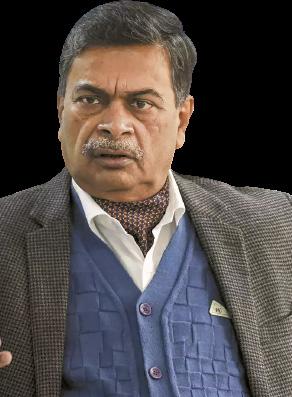
Union Minister for Power, and New & Renewable Energy, RK Singh rolled out a new scheme in the renewable energy sector at the National Summit on Powering Sustainable Livelihoods.
The summit was organised recently by the Council on Energy, Environment and Water (CEEW) and Villgro Innovations Foundation’s Powering Livelihoods initiative. “Our government is coming out with a new scheme for distributed applications of renewable energy (RE). There is already a lot of work happening on the ground and our scheme could benefit lakhs of families across the country,” he said. He also outlined the need for large scale-manufacturing and standardising of distributed applications of RE to lower prices and expand the sector. “We have seen the potential of grid-scale solar power; India will scale up distributed applications of renewable energy for livelihoods. Just like we have a large programme on rooftop solar and solar irrigation, we will create a large programme for DRE livelihoods,” he added. He also outlined the government’s plans to make DRE livelihood equipment affordable. This will be done through tie-ups with banks.
“If a family wants to own a solar dryer, they should be able to get financing from the banks–we will work towards it. Manufacturers and users of DRE for livelihoods are pioneers and now the government will scale it up to the next level,” he added. The minister released two new reports by CEEW and Villgro, that point out that clean technologies have the potential to impact 37 million livelihoods in India’s agriculture and textile sectors and translate into a market opportunity worth almost Rs 4 lakh crore (about $50 billion). The report also highlights that 70% of women and farmers using clean technology reported a typical 35% increase in income. The women use clean-energy powered products such as solarpowered silk reeling machines, multi-food processors, micro solar pumps, solar vertical fodder grow units, among others, to enhance and diversify their income. Further, the CEEWVillgro analysis highlighted that women form the majority of these clean tech users currently. Out of the 767 users surveyed across 19 states, 74% of respondents were women. The clean technologies deployed brought out several social impacts as well.
70 EQ MAY 2023 www.EQMagPro.com
Source: PTI
GREAT MEETING WITH MUKESH AMBANI TO LEARN ABOUT RELIANCE’S INNOVATIONS IN RENEWABLE ENERGY: US AMBASSADOR TO INDIA


Newly appointed Ambassador of the United States (US) to India Eric Garcetti met Chairman and Managing Director (CMD) of Reliance Industries Mukesh Ambani in Mumbai. During the meeting, the two of them discussed Reliance’s innovations in the renewable energy sector and avenues for more US-India together economic cooperation, said Garcetti in a tweet.

“Great meeting with Mukesh Ambani to learn about Reliance’s innovations in the renewable energy sector, and exploring avenues for more US-India together economic cooperation,” the US Ambassador Eric Garcetti tweeted. Earlier, Garcetti also visited the recently unveiled Nita Mukesh Ambani Cultural Center(NMACC) in Mumbai, where he met the cast of the Broadway play The Sound of Music.
He shared pictures from the NMACC on Twitter and wrote, “When in the neighbourhood, I stopped by the new NMACC. From meeting the cast of the Broadway classic The Sound of Music at The Grand Theatre to learning about India’s rich textile heritage at the India in Fashion exhibit, I was impressed from start to finish. Next time, you visit, don’t miss the reproduction of designer Naeem Khan’s ensemble for former US First Lady Michelle Obama.” The Ambassador also met with Maharashtra CM Eknath Shinde on the first day of his Mumbai visit to discuss “shared strategic priorities of business, climate action, and women’s workplace inclusion.” The newly appointed US Ambassador to India also met Bollywood actor Shahrukh Khan at his residence Mannat in Mumbai. Garcetti and the Pathaan actor talked about the film industry in Mumbai and the “huge cultural impact of Hollywood and Bollywood across the globe”.
www.EQMagPro.com 71 EQ MAY 2023
Earlier, Eric Garcetti also visited the recently unveiled Nita Mukesh Ambani Cultural Center in Mumbai, where he met the cast of the Broadway play The Sound of Music
RENEWABLE ENERGY
Source: PTI
BRITAIN LOOKS TO WIDEN RENEWABLES SUPPORT SCHEME
Britain plans to widen its flagship renewable energy support scheme to encourage investment in the sector, the government said as it opened a consultation on the proposed changes.
The Contracts for Difference (CfD) scheme is the government’s mechanism for supporting new British low-carbon electricity generation projects, such as offshore wind and solar projects. Under CfD, generators are guaranteed a fixed, pre-agreed price for the electricity they provide over the term of the contract and sell their low-carbon energy into the market. The scheme to-date has supported 26.1 gigawatts (GW) of low carbon projects, but the government said changes were needed “in face of the deployment challenges currently faced by the renewable energy industry”. A potential reform of the scheme could see applicants also being rewarded for “non-price” factors, such as supply chain sustainability or addressing skills gaps and innovation, the department for business, energy and industrial strategy said in a statement.
This could help drive investment in the sector, expand the economy and boost Britain’s energy security, it added. “Factors such as inflation, commodity price increases, and pressure from international competition mean that the UK will have to continue working hard to pull in the investment required to reach our Net Zero and energy security goals,” Adam Berman, deputy director for advocacy at Energy UK, an energy industry trade association, was quoted as saying in the government’s statement. The government has set targets for big increases in wind power generation, for instance, as it seeks to meet a goal of net zero emissions by 2050 and become more independent of imported energy after supply disruption caused by Russia’s invasion of Ukraine. Last month Britain set out more plans to boost energy security and tackle emissions, but critics said a lack of new investment and incentives meant it failed to provide any new boost for the country’s green energy sector.
Source : reuters
G7 MINISTERS AGREE ON ‘DRASTIC’ INCREASE IN RENEWABLE ENERGY


The Group of Seven rich nations have agreed to call for “drastically” increasing electricity from renewable sources and are considering targets for solar and wind power, a person familiar with the talks said.

But G7 environment and energy ministers, meeting in Sapporo in northern Japan for climate and energy talks on Saturday and Sunday, could not reach agreement on a specific date to exit coal power, according to France’s energy transition minister. Security, already tight around the event, was given greater immediacy after an explosion disrupted an outdoor speech by Prime Minister Fumio Kishida in the western part of the country. The premier was unharmed and police subdued a man at the scene. Kishida’s foreign ministry said there would be no change to G7 security. The group’s foreign ministers are meeting in the resort city of Karuizawa. The G7 decided to endorse a goal to “drastically increase electricity generated by renewable energies,” the person with knowledge of the discussions told Reuters, asking not to be identified because the information is not public.
Ministers also appeared to be considering numerical targets for increasing solar power capacity to at least 1 terawatt and offshore wind power capacity to 150 gigawatts by 2030, the source said. They could not come to agreement on a specific date to exit coal, although they agreed there should be no new coal-fired power plants, France’s Agnes Pannier-Runacher said. The event has also put focus on the need to help emerging countries reduce emissions, including through financing. “We, the G7, need to not only reduce our own emissions but also take concrete actions to achieve emission reductions globally,” Japan’s Economy and Trade Minister Yasutoshi Nishimura said in his opening remarks, singling out countries in the “Global South”. Nishimura said ministers would like to discuss ways to use finance to help reduce carbon in so-called “hard-to-abate” industries, which include chemicals, shipping and steel.
‘STRONGER LEADERSHIP’
The issue of emissions in emerging markets has long been a focus for developed countries. However, the world’s richest countries need to do more to help emerging nations reduce carbon, said Alden Meyer, a senior associate at E3G, a climate change think tank. “There’s a responsibility for the G7 and other developed countries to provide finance and to mobilise private finance as well to help the decarbonisation of the developing countries,” Meyer told a briefing ahead of the start of the G7 meeting. G7 countries must exert “much stronger leadership” in leveraging financial and technology resources to help developing countries reduce emissions, Meyer said. “Smart” government regulation was needed to help make hydrogen and carbon capture technologies more attractive and viable, said Sultan Al Jaber, the United Arab Emirates minister of industry and advanced technology, told a closed session, according to his remarks seen by Reuters. He said nuclear investment needed to be expanded.
Source : reuters
72 EQ MAY 2023 www.EQMagPro.com
RENEWABLE ENERGY














www.EQMagPro.com 73 EQ MAY 2023
Yes!
For 1 Issue:
o Indian citizens Rs. 200
o International $ 25 / € 20
For 1 Year (12 issues):
o Indian citizens Rs. 2400
o International $ 300 / € 240
Please Mail the coupon to: Name: Job Title: Department: Company: Description of the Company: Adress: City/State/Zip Code: Country: Phone: Fax: E-Mail. Web site:
PAYMENT
1.- My Cheque/DD in favour of “FirstSource Energy India Private Limited” for Rs…………………………………………………………………… Drawn on………………………………………is enclosed herewith.
Date/Signature: 2.- I will pay by Credit Card Type: ..........................................................................

74 EQ MAY 2023
ADVERTISERS INDEX
“EQ International” at www.EQMagPro.com or fill your complete address and Email to :admin@gmail.com or
SUBSCRIBE Subscribe
Call +91-7692973898
Magazine
I would like to Subscribe to EQ International
Number: Security Code: Expiration
Mail this coup on to: First Source Energy India Pvt. Ltd. Subscription Department. 95 C, Sampat Farms, Bicholi Mardana Distt-Indore 452016 Tel. + 91 96441 22268 " DB SCHENKER................................................................................07 ENERMAN.........................................................................................19 FOXESS.................................................INSIDE FRONT COVER RHS JA SOLAR....................................................................FRONT COVER REI EXPO.........................................................................................73 RISEN....................................................INSIDE FRONT COVER LHS
Name on Card:
Date:







































 X3-MEGA G2 40kW/50kW/60kW
X3-MEGA G2 40kW/50kW/60kW





















































































































































